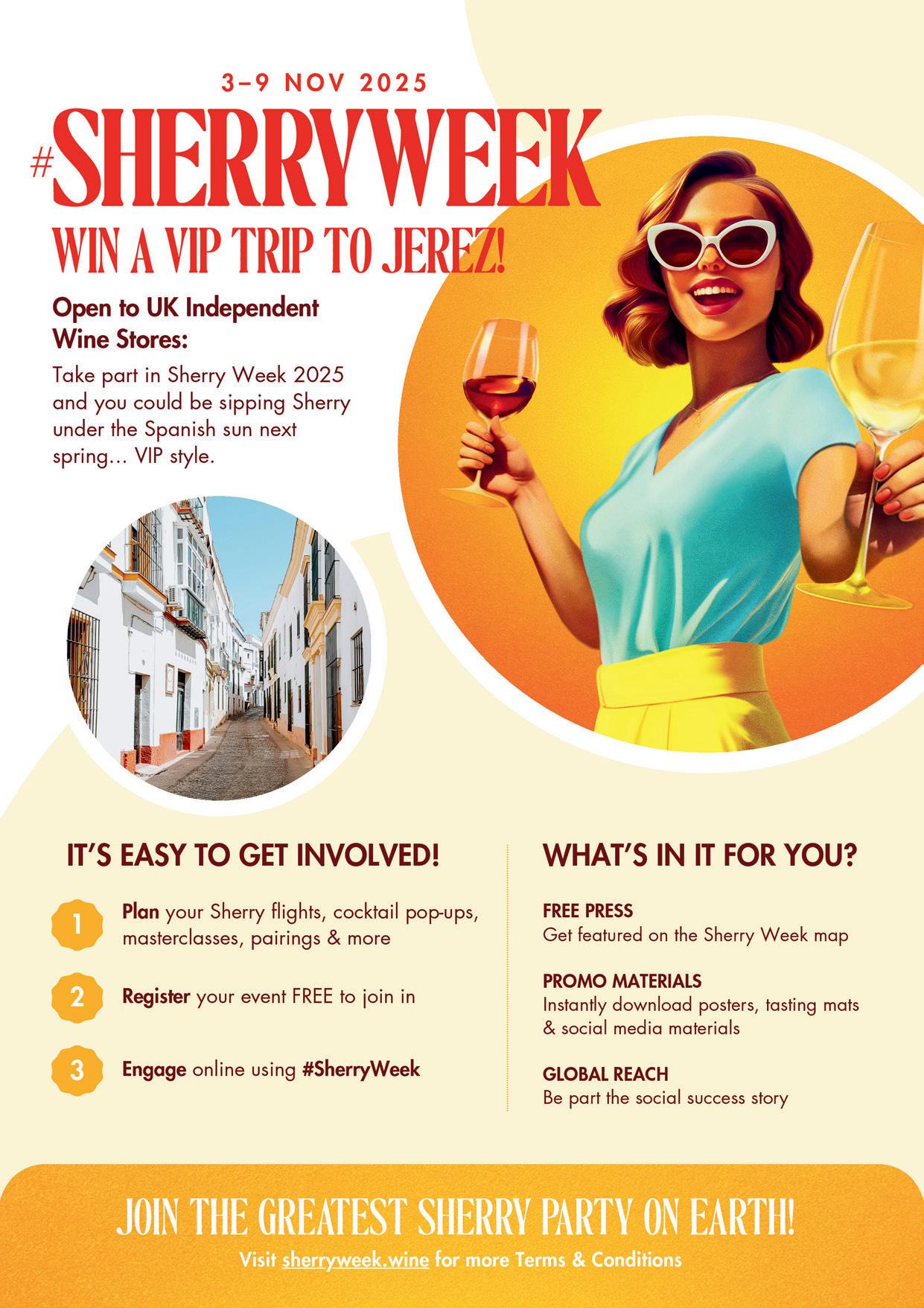THE WINE MERCHANT.
An independent magazine for independent retailers Issue 151, October 2025



Vineyards and Cork of the North lose cash and stock worth more than £10,000 despite banks accepting fake payments
Wine merchants are being urged to be vigilant after leading indies were conned out of thousands of pounds by scammers posing as customers.
In both cases the retailers have been unable to recover their losses, even though they did not release wines until payments had been cleared.
Hannah Wilkins of Vineyards in Sherborne, Dorset, has been left more than £3,000 out of pocket by fraudsters who claimed to be ordering Champagne for a hen weekend at a nearby Airbnb. The money had safely landed in her account before she made the delivery 48 hours later.
Marc Hough of Cork of the North in Manchester was suspicious of three requests for wines that were ordered by phone and paid for by card. But when his bank assured him all payments had been cleared – amounting to around £6,000 – he told staff the stock could be released to the couriers collecting from his premises.
Hough was contacted two days later and advised that the transactions were fraudulent after all, that the cards had been stolen or cloned, and that he was obliged to refund the money.
The losses for both businesses go higher than the value of the transactions because of the stock that cannot be recovered.
Both merchants believe they took
reasonable steps to ensure the payments were genuine and are appalled that the banks have offered no protection or compensation.
Police have been unable to help in either case.
There is a dearth of information available from banks or online about how retailers can protect themselves from credit and debit card fraud, or about what steps they
need to take once they become the victims of a scam.
In the cases of both Vineyards and Cork of the North, the fraudsters attempted repeat purchases once the retailers had been persuaded to believe that the transactions were genuine, having been accepted by the bank.
• Analysis: pages 10-12
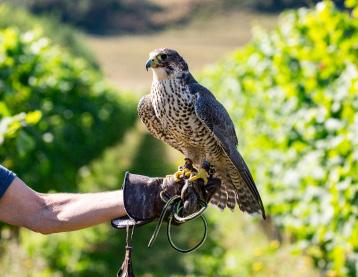
Rathfinny Wine Estate in East Sussex has done away with the 300 sq km of netting it usually drapes over its vines to protect them from birds. Instead, falconers are on hand with raptors like this peregrine falcon to encourage local crows, pigeons and seagulls to find other places to feed.
4 comings & Goings
Who’s on the move in the alwaysfluid world of indie retailing
13 rising stars
A former model who’s found a new lease of life at Salut in Manchester
14 tried and tested
You would tell us if our tasting notes got too silly, wouldn’t you?
18 david perry
Tracking down energy cold-callers to their hideouts in Karachi
19 the burning question
How will AI impact the wine industry? Four indies consider
24 merchant profile
Is George Bovill at Crushed & Cured working too many hours?
58 buyers trip to the rhone
A memorable trip to Ferraton’s impressive winery and vineyards
64 supplier bulletin
Essential updates from some of the trade’s best agency businesses
71 Q&A: richard kelley mw
The wine trade’s leading Leicester City fan submits to interrogation

The Wine Merchant has been involved in several buyers’ trips this year, and dozens more since we launched in 2012. Most we’ve helped to plan and organise; others have been put together by clients, with us jumping on board later in the process to join the fun and then reporting on what happens.
We’ve learned quite a lot about what works and what doesn’t work on trips. Here’s a small snapshot, for the benefit of any producers who may be reading.
1. Your tour guide is almost certainly charming, but their talents are wasted on us. Save the rehearsed quips and the explanations of how fermentation works for the coach parties. Let’s meet someone from the winemaking or export team.
2. About half of the group will almost certainly need the toilet the moment we arrive. So let’s wait for a bit, rather than rattle through all the crucial details while four of them are still queuing downstairs for the only available cubicle.
3. We’re here to buy, so please be ready with some figures. Telling us the euro price in your own shop does not “give us some sort of guide”, despite what you may think.
4. Contrary to popular myth, bottling lines are actually quite interesting. But only when they’re switched on.
5. Don’t boast about how much business you do with Majestic and Laithwaites, or how we may have seen the wine we’ve just tasted in Tesco.
6. However many spittoons you’ve put on the table, it probably won’t be enough.
7. We definitely need more water, while you’re at it. And wafers. Did you say there was cheese too?
8. If yours is the first winery we visit immediately after lunch, what did you do to upset the people at the DO?
9. If yours is the fourth winery we visit that day, let’s skip almost anything you had planned that involves stairs or hills.
10. If yours is the fifth winery we visit that day, it’s really not our fault that we’re two hours late. Take it up with José or Maria at the other places we’ve been.
11. Despite being given a turnaround time of just eight minutes at the hotel, all women in the group will emerge showered, made up and in fresh clothes at 6.30pm on the dot. The men will gradually shuffle into view after two Peronis, still bearing the dust from the vineyard we visited at noon.
12. However headache-ridden and exhausted the group appears on the sleepy minibus ride back from the restaurant at 11pm, a bar will be identified on our return – and beer will be consumed.


winemerchantmag.com 01323 871836 Instagram/Bluesky: @WineMerchantMag Unit 52 Newhaven Enterprise Centre, Denton Island, Newhaven, East Sussex BN9 9BA
Editor and Publisher: Graham Holter graham@winemerchantmag.com
Assistant Editor: Claire Harries claire@winemerchantmag.com
Reporter: Jacob Stokes jacob@winemerchantmag.com
Advertising: Sarah Hunnisett sarah@winemerchantmag.com
Accounts: Naomi Young naomi@winemerchantmag.com
Admin and reader liaison: Charlotte Gingell charlotte@winemerchantmag.com
The Wine Merchant is circulated to the owners of the UK’s 1,045 specialist independent wine shops. Produced in Sussex by East Print. © Graham Holter Ltd 2025 Registered in England: No 6441762 VAT 943 8771 82
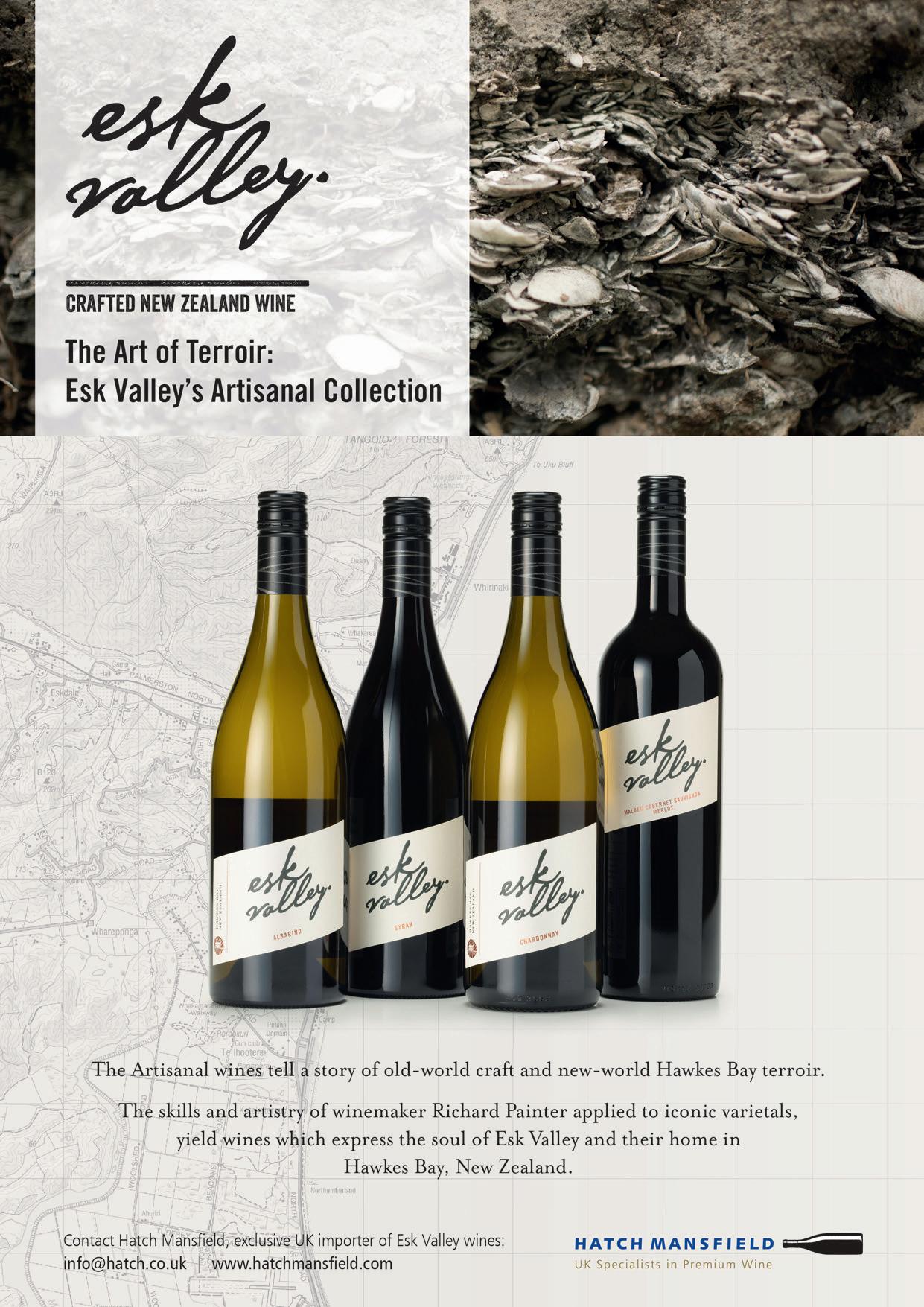

After months of wrangling with her landlord, the Co-op, Louise Oliver will be closing Seven Cellars at the end of January and reopening as a hybrid shop and bar in new premises.
The Brighton merchant has received much support from the local community in campaigning against the Co-op’s decision to take back the unit to further extend its own retail footprint, and now Oliver is hoping her Crowdfunder will attract similar attention.
Seven Cellars will remain in the Seven Dials neighbourhood of the city, just around the corner from its original shop, but the new premises – a former fast food restaurant that has been empty for five years – is a shell.
“There is no heating, no lighting, no flooring, and it is double the rent,” says Oliver.
She launched the Crowdfunder last month with a target of £60,000. Supporters are invited to donate anything from £5 upwards and there are 15 available rewards including tote bags and T-shirts to private masterclasses and tastings.
Even the smallest donation of £5 will ensure a permanent namecheck on the “supporters wall”, but kudos goes to the person who dreamt up the exclusive beers. For every donation of £25 or more, the reward includes of a can of either an Unco-operative Lager or an Unco-operative AF*** Pale Ale.
• Country Wines in Hove, East Sussex, has ceased trading. The company was owned by Paul Newton.
• Kwoff in Bury, Greater Manchester, relocated from its Silver Street premises last month. Its new shop is at nearby St John’s Gardens.

Since returning from her Italian sabbatical, Camilla Wood has been running The Somerset Wine Company from a temporary home since March.
“We’ve moved into the old Wine Wizzard premises which, complete with its old bin shelves of concrete blocks, is very nice,” she says.
Although the Castle Cary building has been purchased by a third party with the intention of turning it into an Italian restaurant, planning permission is still to be granted so Wood predicts she will be able to stay until next Easter.
“There is some doubt as to whether this [the restaurant] will ever happen as we are in more of a residential area of town and kitchen extraction is an issue,” explains Wood. “We are still looking for a bigger premises with an outside space so we can continue the hybrid shop/bar.
“On a very positive note,” she adds, “I have recently recruited Emily Bonsor, ex-Walker & Wodehouse/Bibendum, as my new full-time retail and development manager.
“As well as being a Plumpton graduate, she comes with great trade experience and know-how. She is a safe pair of hands for me to leave the business with whilst I go and pursue other avenues.”
Next year will also see the The Somerset Wine Company’s concession at Teals, a farm shop and services on the A303, expand into “a stand-alone space” within the new Teals extension.
There’s been a changing of the guard at The General Wine Company, eight months after Alan Snudden sold the business to the Drinks21 group.
General manager Sara Bangert, who had been with the company for 15 years, has left to pursue “freelance and travel” opportunities. The Wine Merchant understands she is one of four team members to have recently departed the company, which is a wholesaler and retailer with branches in Liphook and Petersfield, Hampshire.
Richard Royds, formerly of The Haslemere Cellar, is the new wine buyer.
Alexander Hadleigh Wines in Southampton is up for sale. Owner Del Taylor, who initially started as a wholesaler before becoming established as a retailer, is looking forward to retirement next year.
“I started the wholesale side in 1984 and we were in warehouses,” she says. “I solely concentrated on high-end restaurants and hotels. I travelled around door-knocking. Then in 2000 I realised I wanted a shop, and this place came up.”
Taylor says she has built a “loyal customer base with an active wine club” over the past 25 years. “I will miss chatting to my customers,” she says. “One lady came in the other day and said, ‘I’m so glad you’re still here. I worry that you’re going to be gone because your knowledge is so vast and you’ve always got something that you can help me out with.’
“We always get loads of positive feedback from our tastings, which are always highly over-subscribed. We don’t charge, we just rearrange the furniture in the shop and have a nice get-together. We have a really big Christmas tasting, and I think that’s
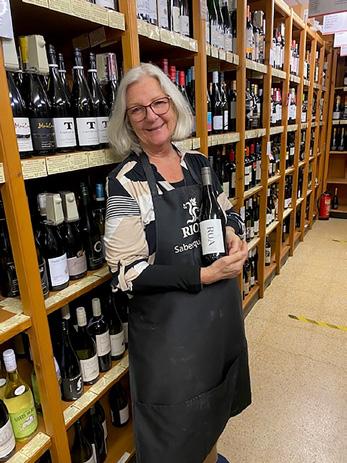
when I’ll announce my retirement.”
Taylor is looking at exiting the business in July 2026, if not sooner, and invites interested parties to contact her direct by email: info@ahadleigh-wine.com.
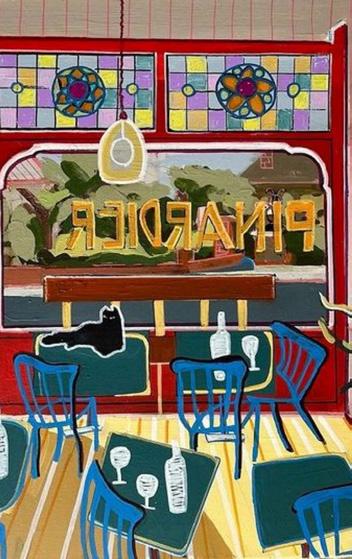
Le Pinardier has plans to expand in Deal, but it won’t be moving.
Owner Benoit Dezecot has confirmed that work is underway to take over the adjacent shop, a project which reunites the two sites. In the 1800s the two units were one, serving the town as Stuart Dunn’s chemist.
“Now, 140 years later, we have the absolute joy of bringing these two gorgeous little shops back together as we expand Le Pinardier into its other half next door,” Dezecot says.
“We may not be a chemist anymore but we like to think that what we’re serving up is medicinal and ‘bon pour la santé’.”
Dezecot says he hopes to open the new-look Le Pinardier at the beginning of February.

You can hide, but you can’t run
It’s the time of year when a wine merchant’s thoughts might be turning to Beaujolais Nouveau, but please be careful how you communicate this news to your clientele.
Chances are you’ll be placing an order with your usual suppliers rather than jumping into an Aston Martin or vintage biplane and racing off to Burgundy. Either way, don’t casually refer to it as “doing the Beaujolais run”, because if you do, you’re likely to receive a very stern legal letter from The Beaujolais Run®, an organisation which has trademarked the name and aggressively protects its intellectual property, as well as raising money for The Royal Airforce Benevolent Fund.
Marc Hough of Cork of the North in Manchester is one indie who’s had the pleasure of correspondence from The Beaujolais Run®, and its contents left him in no doubt about how seriously his transgression was being taken.
Jonny Cocker observed a woman pacing around his Martinez Wines store in Bingley, West Yorkshire, tutting and shaking her head as she examined the bottles.
“I’m not buying anything from your shop,” the woman declared.
“Why – is there a problem?” asked Jonny.
“Everything is out of date,” the woman replied.
When you’ve decided that every wine in your range ought to come with its own food matching recommendation, inspiration can start running a bit thin.
The Tanners team were up for the challenge, however, and even when private sales director Robert Boutflower was tasked with finding the right partner for Cune Crianza Rioja –specifically in a dinky 187ml bottle – he delivered. “A small cheese sandwich” was the verdict.
By WSTA


Duty hikes haven’t worked
As we step into the autumn all eyes are on a significant Budget for the sector on November 26. A major concern is further duty increases, but also the Chancellor will announce the final design and multipliers for the new business rates system from April 2026.
The WSTA will campaign for a duty freeze and highlight the impact of reduced sales on receipts to the Exchequer. Despite significant duty increases in February, the Exchequer has failed to plug the black hole in public finances and taken 4.3% less in alcohol duty receipts – a loss of over £220m – in the first five months of this financial year compared to the same period last year.
As well as seeking a meeting with the new Exchequer secretary, the WSTA will be conducting a full engagement campaign with MPs and officials, and will be working closely with other trade associations to reinforce shared requests across related sectors.
We continue to spotlight the economic contribution of the sector via our new industry guide, available on our website – The Wine and Spirit Trade: In Focus. It is key that government understands the impact of cumulative costs to our sector (and alcohol prices) of recent policy interventions – including the likes of EPR, NICs and business rates changes. Keep an eye on the WSTA website and social media platforms to find out how you can get involved.
• In other news, in August the Welsh government confirmed plans to create a unique approach to DRS and glass reuse, separate from the rest of the UK. Not aligning DRS with the rest of the UK is a major error and the WSTA has warned this decision may affect trade, increase prices and reduce choice for Welsh consumers. How the scheme is funded is not clear, with the Welsh government claiming not to charge deposits for glass between 2027 and October 2030. However it accepts “different labelling” could be required.
Find out more at wsta.co.uk
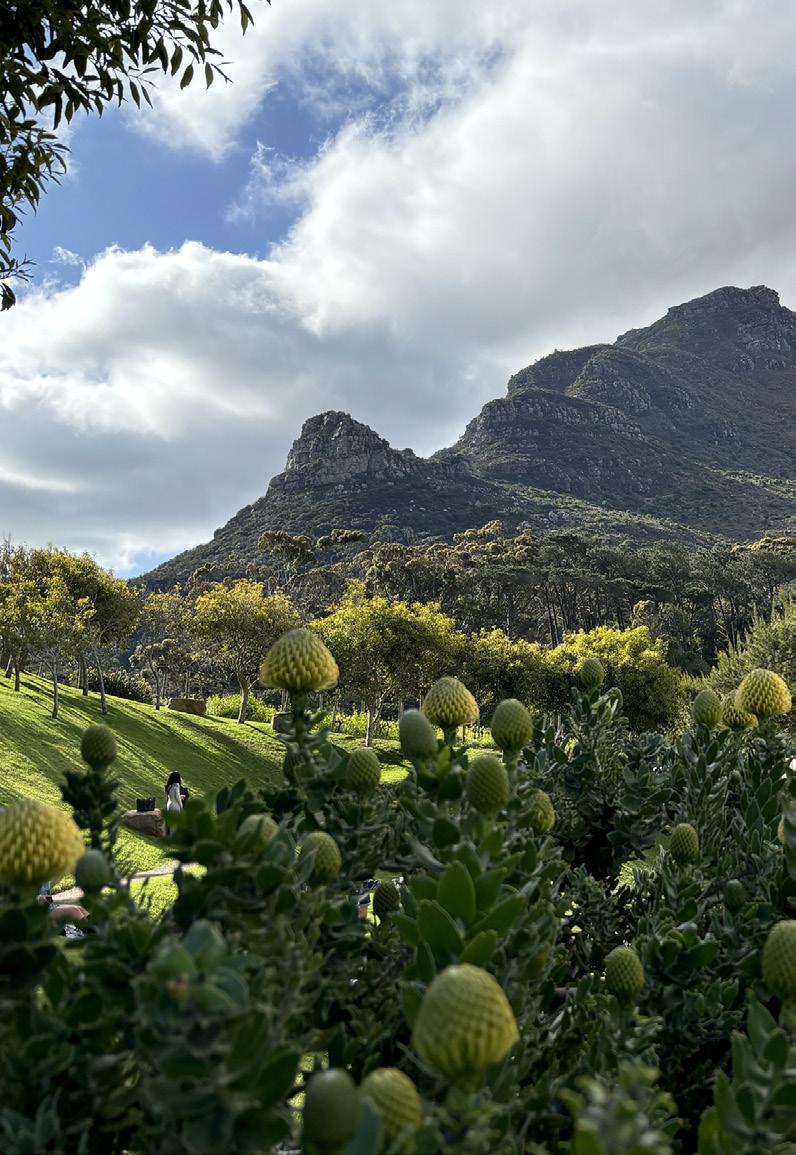
To say South Africa and its wine industry has faced turbulence in the past 10 years would be an almost criminal understatement.
Starting in 2015 and lasting three years, a one-in-384-year drought took Cape Town within hours of day-zero: the point where the taps run dry. It’s the closest any city has come to such a scenario and would have left some 4 million people without water.
In the vineyards, irrigated sites saw all usual water sources either turned off or be critically restricted. Dry farmed vineyards
dug deep for survival but in many cases died. The vines that persevered, and the farmers who could only watch on, came out the other side bloodied and bruised, but with the humbling experience of surviving new extremes – something that would be compounded just a year later with the emergence of Covid.
Beginning in March 2020, three separate bans on the sale of alcohol across the country paralysed the trade, stripping away the livelihoods of dependent communities overnight. The industry

lost an estimated R7bn (£300m) over the course of the interventions, with domestic sales dropping by 20% on the previous year. The government’s heavy-handed overreach put its wine industry, and the 270,00 jobs that it sustains, at risk of irreversible damage.
In addition to all of this, due to mismanagement inside the country’s state-owned electricity provider, ESKOM, South Africa fronted these challenges in the darkness of energy blackouts, as the government intensified its load-shedding
regime as a last resort.
But the tenacity of South Africa and its people prevails. Against headwinds unimaginable in most wine-producing nations, this most remarkable player in our global trade doesn’t just endure – it adapts, inspires and leads.
A group of independent merchants travelled to this year’s Cape Wine show to judge recent progress for themselves and to explore the winelands. Jacob Stokes joined them – read his report in our November edition.
by Rob MacCulloch MW Head Winemaker at Hattingley Valley Wines
High acidity is the hallmark of English wine; it’s what gives our sparkling wines their structure, longevity, and distinctive freshness
These days it feels like everyone is talking about acidity Wine regions all over the world claim to make “crisper,” “fresher” wines with on-trend grape varieties seeing a resurgence in popularity for their fresh acidity too Yet being understated English, we don’t go in for such hyperbole: we can sit comfortably knowing that our acidity levels at harvest – both the volume and pH – are consistently at World Heavyweight Champion level thanks to our cool climate
And there’s more to it than just the amount of acidity; it s the type of acidity that makes English wine so distinctive Elsewhere in the world, tartaric acid dominates at harvest with less malic acid remaining In England, our famously cool nights give the opposite: malic acid can actually be higher than tartaric This can be tricky, as malic acid on its own can taste a bit hard and green
The usual fix is to put the wine through malolactic fermentation (MLF), which converts sharper malic acid into softer lactic acid But our high levels of malic acid require us to be careful in how we handle it This is where the art of balance in winemaking comes in Too much MLF can make wines taste too broad with acidity that’s out of style for English Sparkling Wine; or if considering making traditional method sparkling wine with no MLF, the wine may require far, far longer maturing on lees before it becomes truly drinkable But over the years, we ’ ve learned to understand acidity and how it shapes what we taste We can adjust it, but it’s never easy to balance acidity in England’s cool grape-growing climate
In short English winemaking at its heart is about mastering balance And for us in England, the balance of acidity is both our greatest challenge and our greatest gift
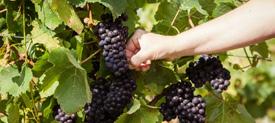


In a nutshell: Through a collaboration with Flod, Gills & Co has given some empty wine bottles a new lease of life.
Tell us more …
“Flod is a team of two young guys who collect river rubbish, such as glass and plastics, and essentially turn it into product. Given their experience as parttime chefs, they knew how much waste was involved in hospitality as well, and that motivated them to want to work with restaurants and bars to help do something with their waste.”
We’re not talking food waste?
“No. Things like glass and plastic that we put into the general recycling, but we don’t really know the true fate of those items.

In particular, Flod is working with old plastic chopping boards and glass bottles. They approached us and asked if we had any spare wine bottles and, as we discard two wheelie bins full of empty bottles every week, we were like: ‘Of course, come down and have a look.’”
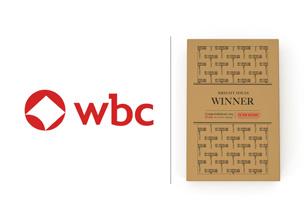

More than mere mudlarking, Flod is litter-picking from the riverbanks and creating its own artefacts?
“Yes, they make vases, tealight holders and plant pots and they’re doing loads of other things within the sector too. Sheffield was renowned for steel and the guys at Flod have found a stock of vintage steel that they’re using to make knives, and they’re recycling plastic chopping boards to create the handles. They’re working with restaurants and bars to make some really cool things from waste, some of which
Vic Trudgill Gills & Co, Sheffield
we generate, that we can re-use in our businesses.”
What became of your bottles?
“They made some vases, which they gifted to us. We’ve got them on the tables and on our shelves as décor, and I am interested in buying and using their knives for the business when they’re available.”
What has been the reaction so far to this project?
“Flod made a video of the process of upcycling our bottles to make the vases and we posted it on Instagram tagging Trimbach, Simpsons and Roebuck Estate, whose bottles were upcycled. This content on social media created quite a bit of conversation about how amazing the work is that they’re doing, and as these wines are made as sustainably as possible, I think it’s a real positive for the producers to see the bottles being used in this way.”
Have you collaborated with other local businesses?
“This is the first time we’ve done something like this and I’m really hopeful that this gives Flod more exposure because they are doing such great things for the environment. If other merchants want to work with them, they should get in touch direct at flod.co.uk.”
Vic wins a WBC gift box containing some premium drinks and a box of chocolates.
Tell us about a bright idea that’s worked for you and you too could win a prize.
Email claire@winemerchantmag.com
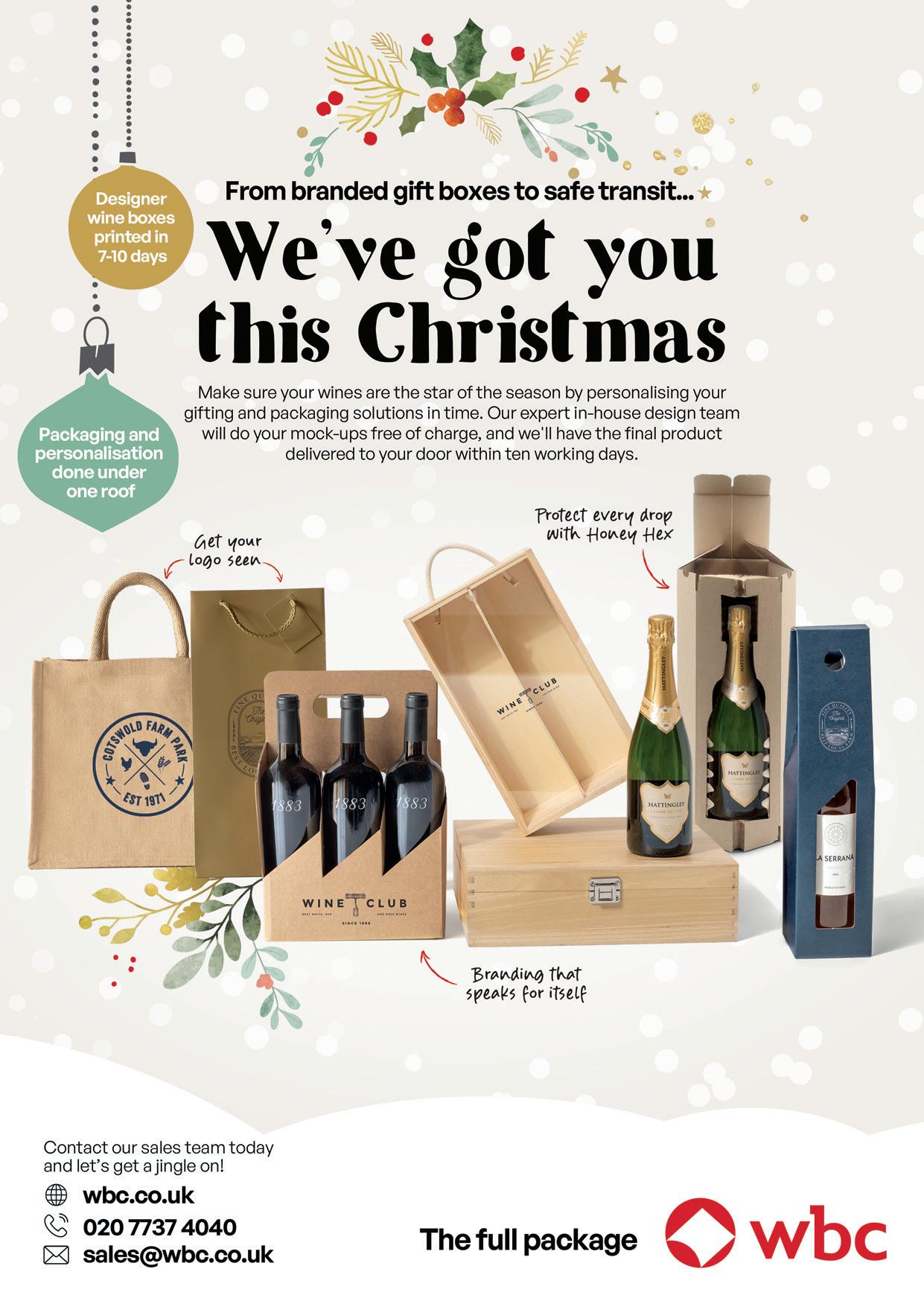
Two of the independent trade’s most prominent merchants – Vineyards of Sherborne and Cork of the North in Manchester – have both recently fallen victim to major card fraud.
Claire Harries hears their stories, and about their fruitless battles for compensation
Technology has made retail transactions increasingly easier and quicker for consumers. But when it comes to fraudulent card payments, who foots the bill?
Despite following the correct payment protocols, Hannah Wilkins at Vineyards in Sherborne, Dorset, was left with an unrecoverable debt after being targeted by a gang using cloned cards.
A woman called the shop and told Hannah that she was with a hen party staying at a local Airbnb and asked if she could she order wine for delivery. It all sounded completely plausible, so the sale went ahead.
“I put it through as a CNP [cardholder not present transaction],” Hannah explains. “I took her address, her name and number, as you’re meant to, and it went through. The money cleared into my bank account, no problem at all. I checked it was still in my bank account 48 hours later and as the money was very much in there, a member of the team delivered the stock.”
Alarm bells didn’t start ringing until the following week when the same woman called saying she’d extended her stay at the Airbnb and wanted to order some more Champagne. This time the card was declined.
“She gave me another card to try, and then another,” says Hannah. “I noticed at the time that one card had an Edinburgh postcode and another was from the south coast. I thought, ‘well, they’re a group of women on a hen-do, they’ve got together from wherever, so it’s not so weird’. But when the

third card was declined, I told her I couldn’t put the sale through.”
Within a few minutes Hannah received a call from her card payment provider confirming that it wasn’t happy with those attempted transactions and saying it was looking into the activity on the three cards.
Then the woman called again with another card. “I told her that I’d had my card processing company on the phone, and they’d put a stop on any large transactions because of the issues with her cards,” says Hannah.
Remaining friendly and confident, the woman promised to do a bank transfer but that was the last Hannah heard from her. At that point she began some detective work of her own. She knew exactly where the Airbnb was, having delivered to it the previous week.
“I get tech, I really do, and I always thought that with a CNP there was protection for the retailer. But there was absolutely zero”
Hannah Wilkins
She approached the owner who, as she lived in the adjacent property, was able to confirm that rather than a group of women on a hen-do, the house was occupied by a lone man who spent his time accepting a stream of deliveries. She also saw a lot of taxis arriving, which he loaded and sent on their way.
This was followed by an email from Hannah’s payment services provider saying she’d received a charge back for the initial transaction. She called 101 and was sent a link to complete a form. “It took me nearly an hour and a half to get past the first section, because the second or third question is, ‘is
this crime happening at the moment?’ Of course, I’m going, ‘well, yeah, but no, but yeah ...’ If you clicked yes, it told you to ring 999,” she says.
“Eventually I gave them all the information and was advised they probably wouldn’t be able to do anything because none of the cards had been reported as fraudulent or cloned at that time.”
Shouldn’t this scammer have been caught redhanded? Counting a retailer, an Airbnb owner and numerous taxi drivers, there were plenty of witnesses – but this is 2025, and the police tend not to turn up for much less than anything involving a physical threat.
Hannah posted about this experience on her social media last month and, judging by the comments she received, it appears scams of this nature are common, with even the most experienced of retailers being caught out.
“I don’t want this to happen to anyone else,” she says. “I’ve done this now for 27 years and the good old days, when you used to take an imprint of someone’s card and they signed it, and you’d take the slips into the bank, have all gone.
“People come in and they pay with their watches or their phones.
“I get tech, I really do, and I always thought that with a CNP there was protection for the retailer. But there is absolutely zero.”
Marc Hough at Cork of the North in Manchester had a similar experience –but his scammer sent a courier to collect the goods.
“He rang one of my shops asking to buy £450 worth of wine and gin,” Marc explains. “OK, that’s more than the usual amount that somebody would buy over the phone, but it’s not unheard of, so it didn’t raise any suspicions.
“We took the long card number, expiry date and the three digits on the back and the payment went through. He said it was for a party and he was sending a courier to pick it up. A couple of hours later, a fella turns up with a van and we help him fill it with the booze. And off he goes.”
Just two days later, another call came in from someone else wanting to spend £500 on wine. Marc raised an eyebrow when he was told the customer didn’t mind what the wine was, but hearing it was for a party and that they’d been let down by a previous supplier, he swiftly went
“Alarm bells rang. Who on earth would buy £5,000 of wine and not ask for a discount? But Elavon said, the money is in your account”
Marc Hough
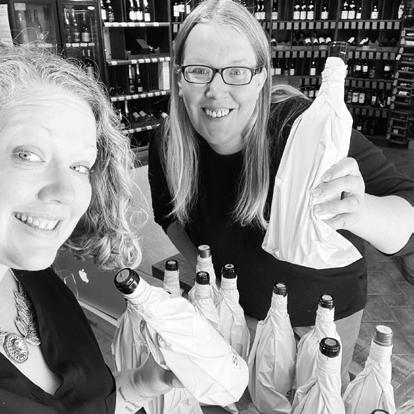
into helpful mode and suggested a party-pleasing mix of Cabernet Sauvignon, Sauvignon Blanc and Prosecco. Once again it was collection by courier, but the payment had gone through the card machine, so why ask questions?
“We use Elavon, who are tied to Santander,” says Marc. “The reason we use them, and a lot of retailers use them, is because once payment is approved you know it’s going to be in your account the next day.”
When it came to the fraudster’s third and final act of the scam, Marc called Elavon to check the payment, even mentioning the F word, but was advised to go ahead.

“A member of staff rang me to say the same guy had called and wanted to buy about £5,000 worth of wine,” he explains. “I asked, ‘what does he want and what discount does he want?’ and for me alarm bells rang when she said he wasn’t bothered about a discount and didn’t know what he wanted. Who on earth would buy £5,000 worth of wine and not ask for a discount?
“I rang Elavon and explained the situation. Elavon said, ‘we have just seen that payment successfully go through’, and I asked, ‘are you sure it's not any type of fraud?’. To which they replied: ‘Well, look, the money is in your account.’
“Two days later, I get an email from Elavon telling me that all three of these sales were fraudulent as whoever it was ringing me had used stolen or cloned cards, but I am liable for the payments.”
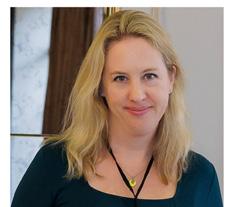
with Rachel Gibson MBACP

Sorry team, I’m leaving you on your own in the shop yet again as I’m at back-to-back portfolio tastings today. Huge apologies, Favourite Importer: I can’t leave the shop long enough to go on that incredible trip you’ve promised me, despite agreeing to it ages ago. Very sorry darling, I’m working until midnight on Thursday, Friday and Saturday evening … probably for the next three months.
How often do you feel that unsettling pang of guilt, and how long does it last? Clients in therapy sometimes explore their emotions around this subject, perhaps with the hope of unburdening themselves from those chronic, uncomfortable feelings and their tangled pickle of communication in both work and personal relationships.
Interestingly, many clients who experience the most severe and prolonged symptoms of guilt also describe strong feelings of empathy, justice and fairness. They tend to be finely attuned to other people’s emotions and care what others think. You don’t want to let people down.
It can be helpful to break down our feelings of guilt and question their origins and potential helpfulness. For example, when we feel guilty, do we hear someone else’s voice in our heads? Are we feeling guilt based on a similar experience that happened in the past? Have you ever been “made” to feel guilty by someone who wanted you to feel bad?
Look at the bigger picture. Ask yourself: Is my guilt serving a purpose? Is it making me behave in a particular way (good or bad) and could I communicate differently, or adjust my behaviour? Guilt makes us think and reflect, but remember, its usefulness also has a shelf life. There comes a point when we deserve to forgive ourselves, leave it in the past and move on.
Rachel is an integrative counsellor and a member of the British Association for Counselling & Psychotherapy. She formerly ran Wine Utopia in Winchester. To support clients in the wine trade, she offers ongoing online counselling sessions at the reduced rate of £35 per 50 minutes, so mention this article. Email rachel@rachelgibsoncounselling.co.uk.
Marc was told that he had not completed two additional checks required when taking a CNP payment. “You’re supposed to put in the card machine the number of their house and the numbers in their postcode,” he says. “We got some new card machines about 18 months ago and they do have the facility to do that, but we’ve never bothered with it because you just sort of like press ‘yes’ and ‘yes’ and just put the payment through.”
The advice here would be for every retailer to check the policy with their own payment service provider, because as Hannah Wilkins at Vineyards confirms, she did go through those extra two steps but the monies were still rescinded from her account.
There are now new policies in place at Vineyards and Cork of the North. Payments must be made in person or failing that, by bank transfer or secure payment link.
“Apparently this is quite a well-known scam,” Marc says, “but I wish we’d been aware of it. We’ve spoken to the police but they say there’s nothing we can do.”
He adds: “Do you know what really adds insult to injury? The following week the same guy rang up again and when I said to him ‘how dare you commit this fraud on a small business?’ his outraged response was: ‘Fraud? How dare you!’ He was so brazen.”
In this situation the owner of the cloned or stolen card will often have their money reimbursed by the banks, but for that to happen, the bank will rescind payment from the retailer in question. It seems the only way to avoid this is to choose secure payment links or BACS instead of a CNP transaction.
“Retailers can be liable for chargebacks where fraudulent card information is used to make a purchase,” confirms Giles Mason at UK Finance, the banking and finance industry’s trade association.
“Whilst banks and payment providers
“Apparently this is quite a well-known scam. But I wish we’d been aware of it. The police say there’s nothing they can do.”
Marc Hough
have strong fraud controls in place to protect customers from fraud, criminals are sophisticated and find ways to use stolen customer data to make fraudulent payments.
“Best practice includes using an address verification service at checkout, ensuring Strong Customer Authentication such as 3D Secure is in place, checking for unusual or high value orders, and always obtaining the card security code to confirm the card details are genuine. If something doesn’t feel right, take a moment to challenge or verify before going ahead.”
According to research published by the Federation of Small Businesses, fraud costs the UK £7bn a year and now accounts for 41% of offences in England and Wales, with only 1% of police resources dedicated to it. Incidents of small business cybercrime have more than tripled.
Action Fraud was also invited to advise retailers on how to protect themselves as the busiest time of year approaches, but a City of London Police spokesperson said it is “unable to assist” because it is “currently working towards the launch of our national reporting service which will replace Action Fraud”.
The impact of fraud on businesses can be life-changing for the owner but can also have a negative impact on the local economy. Vineyards and Cork of the North are both busy and successful, but Marc, having lost £9,500, won’t be able to sustain a further hit – and Hannah has already had to explain to local charities that she won’t be able to make her usual boozy donations this year.
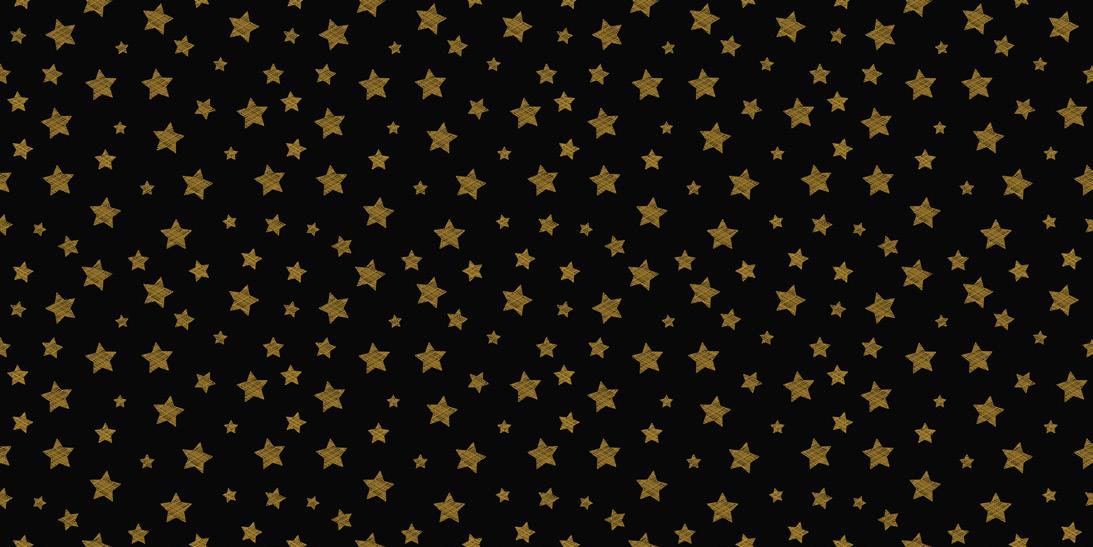
Before she launched Salut over a decade ago, Sara Saunby was an air stewardess, a career she says gave her the skills to “be independent and stand up for myself”.
When Georgie Toms applied for a job, Sara recognised similar traits in the former model and is delighted to report that, although Georgie had no hospitality experience, “she very quickly went from being somebody who wasn’t used to this industry to become an excellent example of what good customer service really is”.
Sara adds: “At Salut we have four pillars: kindness, respect, integrity and inclusivity, and Georgie nails it. I think the biggest deal for us is finding the right people with the right personality. She’s now our manager and runs the show really well. She looks after the team, while looking after the customers, while looking after me. I trust her implicitly, and I think the rest of the team feel the same way.”
Scouted by an agency, Georgie began life as a model straight out of high school. “Half the year I was in Paris, Milan, Barcelona, New York, so I mostly lived away from home in Manchester,” she says. “The modelling world came to a very abrupt halt during Covid, and that’s when a friend of mine told me about Salut.
“It’s a completely different world, but at the same time there are similarities. Modelling, like hospitality, is very forward-facing, but with modelling there’s always the thought, ‘I can’t do this forever’, and you’re going to need some training to do something else.
“One of the lovely things about this job is how much I can use my brain, and how much I can constantly learn and expand,” she says. “There are so many different aspects to this role, and as Salut has a full, busy bar, as well as the shop, there’s so much going on.”
Although Georgie says she loves her new lifestyle and really appreciates no longer living out of a suitcase, international travel is never off the table in the wine trade.
“You can still do a lot of travelling in this industry, only it’s a lot more fun,” she says. “I’m much more aware of what I’m drinking and eating, and I can enjoy it more. I now know what kind of wine I like, whereas before I was sat at tables where people would order for you.
“Weirdly, coming to the same place every single day
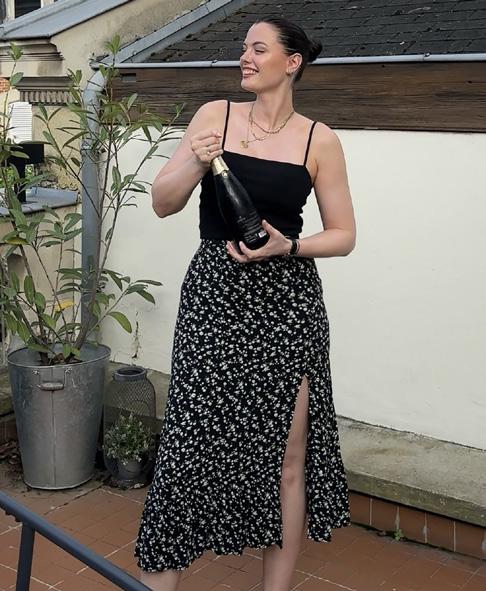
was both the hardest and the easiest thing. Being able to walk to work is glorious, as is having teammates –we have a great team here. Being part of the amazing food and wine scene in Manchester is to be part of a fantastic community. It is like a whole world that opens up to you.
“We stand out at Salut because we have the tasting machines and it’s really nice to have that point of difference.
“One of the favourite parts of my job is Saturday nights. It’s always such a good buzz, especially as we come up into winter. We’ve got so many lovely regulars and it’s always intense, but fun and energetic.”
Georgie wins a bottle of Champagne Devaux Cuvée D courtesy of Liberty Wines
If you’d like to nominate a Rising Star, email claire@winemerchantmag.com

TRIED & TESTED
Rustic but elegant, textured and still vertical, poised but enthusiastic. Think toffee apples and iodine, sea salt and lemon rind, quince skin and olive brine, stone and sap. In the story of Sardinian whites, Granazza is merely a single page. But you’d fold the corner, jot down the number, or tear it out and frame it.
RRP: £63 ABV: 12.5%
Passione Vino (020 3487 0600) passionevino.co.uk
It might be tempting to compare this to the northern Rhône. But Cape Syrah deserves to be accepted as the distinct style that it is: cool, dense and tightly coiled. A solid core of salted blueberries and black cherries supports a steady bleeding of cocoa nibs, clementine, violets and granite.
RRP: £35 ABV: 14%
Dreyfus Ashby (01636 858774) dreyfus-ashby.co.uk
Think of every type of rock melted down, woven into silk and draped over unctuous white peaches, salted lemon pith and golden apple skin. An authority built by whispers rather than orders, a tension built by silence, not vices. Language will always leave a wine like this unpraised. We don’t have the words yet.
RRP: £45 ABV: 12.5%
Justerini & Brooks (020 7484 6430) justerinis.com
This Syrah-dominant GSM blend is drenched in Languedoc sunshine. Plush and sweet with a generous vein of oak, it’s gushing with soft bramble fruit, spicy red plum and strawberry jam. Unapologetically hedonistic with waves of cedar, vanilla, lavender and cinnamon. There’s a sense of place, and it’s a hot one.
RRP: £41 ABV: 15.5%
Walker & Wodehouse (020 7449 1665) walkerwodehousewines.com




Lorca trained to be a doctor, opted instead for a career in Argentinian winemaking, got into cycling, did the Camino de Santiago de Compostela and decided Galicia would be a great place to make wine. This entertaining Ribeira Sacra has crunchy red fruits, an earthy undercurrent and a waft of rosemary.
RRP: £21 ABV: 13%
Ucopia World Wines (01435 517080) ucopiawines.co.uk
Old vines from an old wine region, vinified in an oldfashioned way and aged in old oak. Sometimes new ideas are welcome in the wine trade, but often it’s pointless trying to reinvent the wheel. As with many Douro field blends, the style is much more elegant than you might expect, but there’s enough ripeness and tannin to satisfy the roaring-fire-and-Netflix crowd.
RRP: £33 ABV: 13.5%
Hatch Mansfield (01344 871800) hatchmansfield.com
Just hearing that the grapes are foot-trodden in Tenerife primes you for a wine you know you’re almost certainly going to love. So we did 30 pressups and had a cold shower and, guess what: the wine was still genuinely remarkable. Silky and saline, mellifluous and mineral, vivacious and versatile.
RRP: £34.50 ABV: 13% Moreno Wines (0161 908 1383) morenowines.co.uk
This De Bortoli-owned plot is on the eastern edge of Rutherglen, a site which evidently suits the Marsanne, Roussanne and Viognier blended so seamlessly here. No malo, no stirring, just precise fruit purity, subtly rounded by lees and oak. Beautifully judged: a wine in Australia’s Goldilocks zone.
RRP: £18 ABV: 12.5%
North South Wines (020 3871 9210) northsouthwines.co.uk




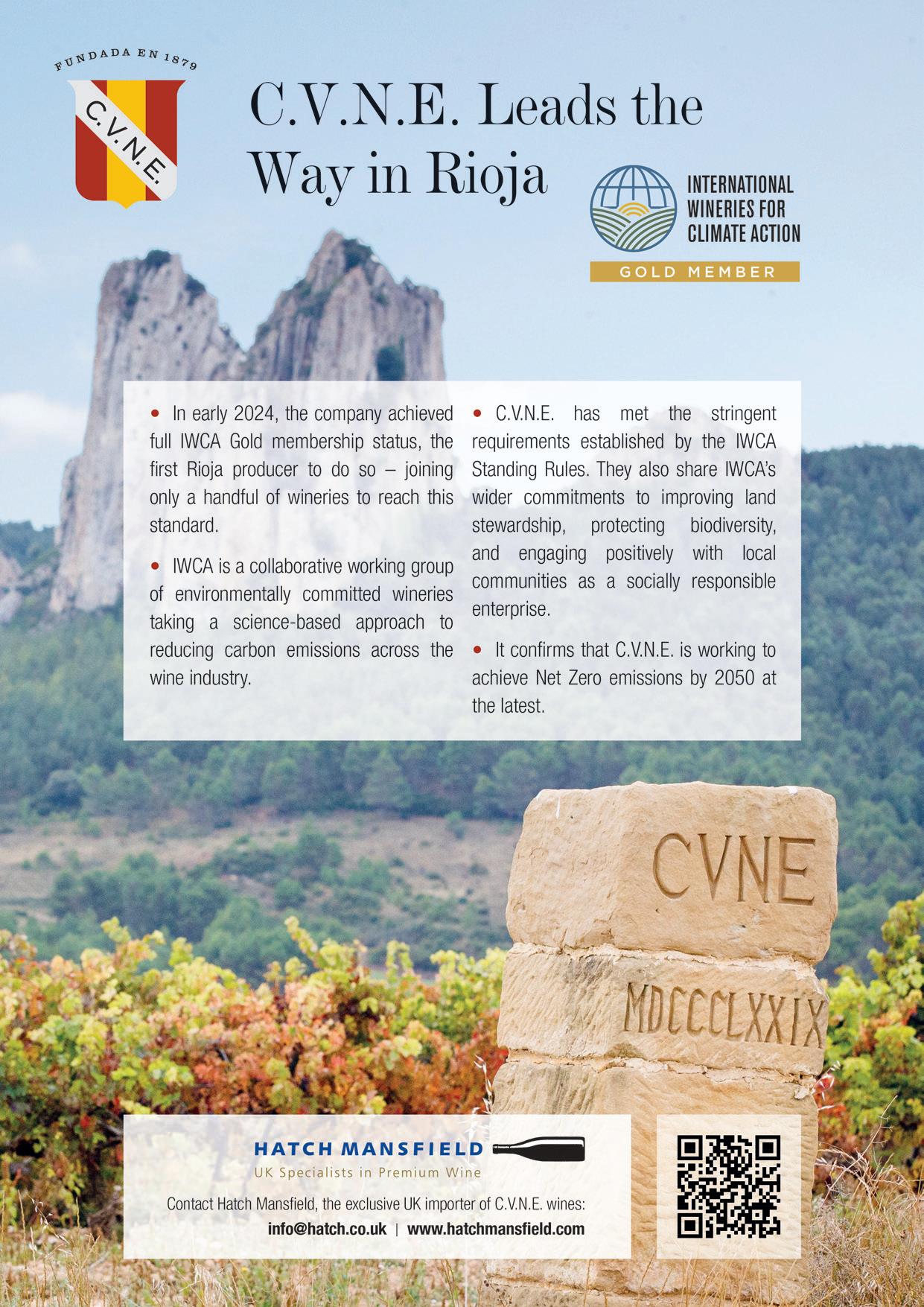
The 2025 harvest has just come to an end in Champagne. How would you describe it?
We will remember the 2025 harvest as a very high-quality one.
The different grape varieties were in excellent health and, after visiting the vineyards and tasting the berries, we knew that full maturity was essential to achieve the fruit expression we were seeking. Thanks to the dedication of our growers, who harvested at the ideal time, we were able to reach optimal quality.
The musts we tasted showed beautiful balance and an elegant aromatic profile.
This is very promising for our future wines, which are currently undergoing alcoholic fermentation in barrels.
This year marks your 35th harvest with Champagne Devaux. How does it feel to look back on such a landmark?
Reaching my 35th harvest with Champagne Devaux is a special milestone. It reminds me that every harvest is unique – each year brings its own challenges and surprises. I feel deep appreciation for our growers and team, whose dedication allows us to adapt, learn and maintain the style that defines our wines.

Over the past 35 years, what have been the most striking changes you have seen in Champagne vineyards?
Vineyard work now demands a more scientific, observant and methodical approach, especially in response to increasingly
harsh and unpredictable climatic conditions.
Climate change is often cited as one of the biggest challenges for winemakers. How has it impacted your work and the style of your wines?
Our main challenge is to maintain the same wine style and blending philosophy in an environment that is constantly evolving. We have had to adapt both in the vineyards and in the cellar, developing new tools: semi-wide vines; harvesting only in the cooler hours of the morning. Another important change has been the increased use of wines without malolactic fermentation.
What adaptations have you and your team implemented in the vineyard and in the cellar to respond to these changes?
In the vineyards, we focus on soil management, using grass cover to maintain balance and vitality in the vines. In the winery, at the blending stage, we work with non-malolactic wines and have refined our pressing techniques, particularly by separating the cœur de cuvée – the first part of the first pressing of the juice – to capture the purest expression and best qualities of the grapes.
How has your own winemaking philosophy evolved over the decades?
We remain humble, always seeking new tools to preserve our style while striving for continuous improvement.
Would you say that the wines you are producing today are very different from those of your early years at

As Michel celebrates his 35th harvest at Champagne Devaux, he reflects on the changes he’s seen over that time
Sponsored feature UK importer: Liberty Wines
Champagne Devaux?
The wines are not fundamentally different, but we use modern tools and techniques to maintain our style. We have also refined our winemaking practices to add complexity – for example, through barrel fermentations.
What excites you most about the future of Champagne?
What excites me most is seeing how Champagne continues to evolve while staying true to its identity. The resilience of the vineyards, the dedication of our growers and ongoing innovations in winemaking give me great optimism for the future.
What message would you like to share with the next generation of winemakers who will face even greater challenges?
My message is to stay curious and adaptable. Always strive to innovate while keeping quality as the ultimate goal, and embrace challenges as opportunities to refine your craft.
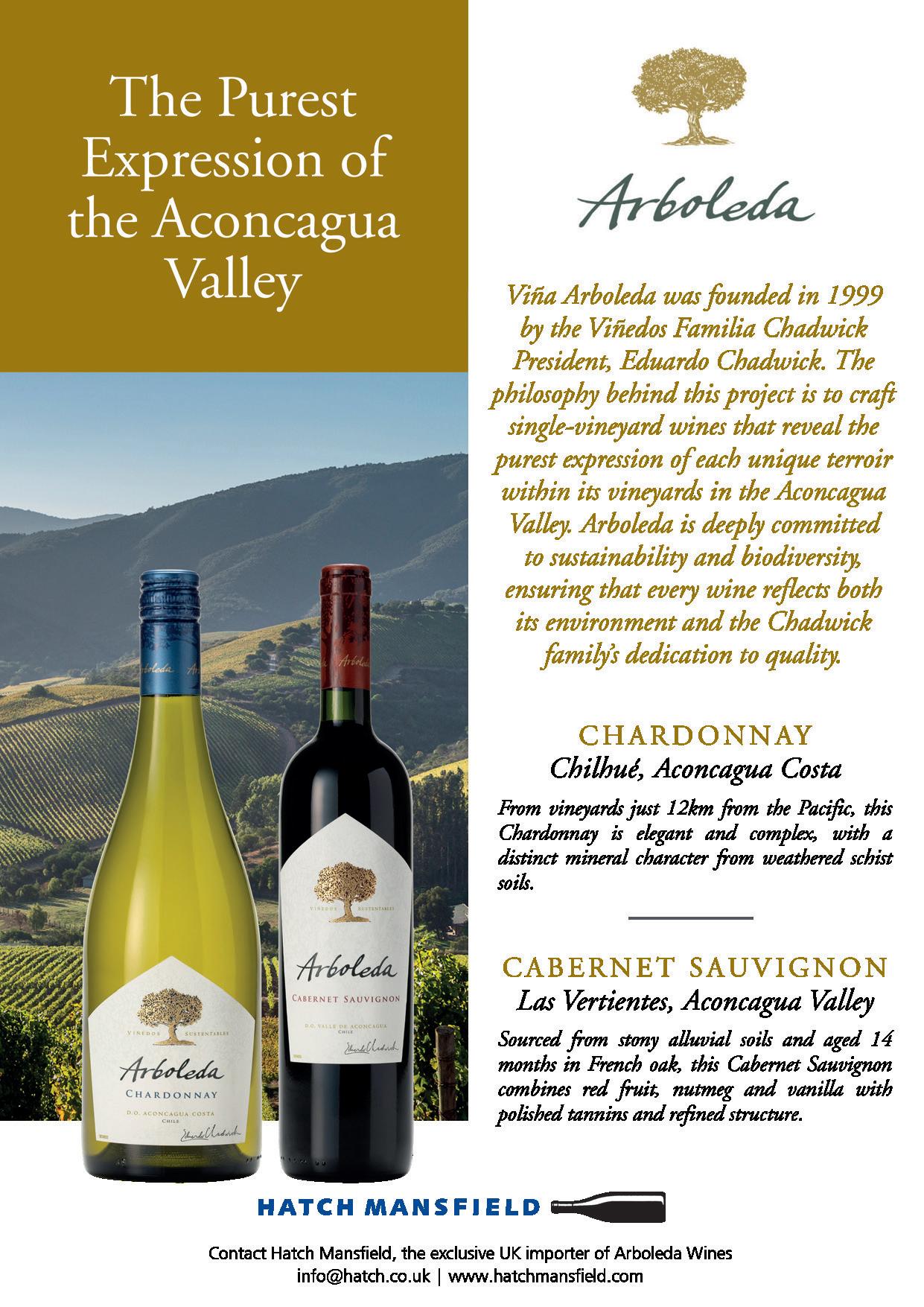

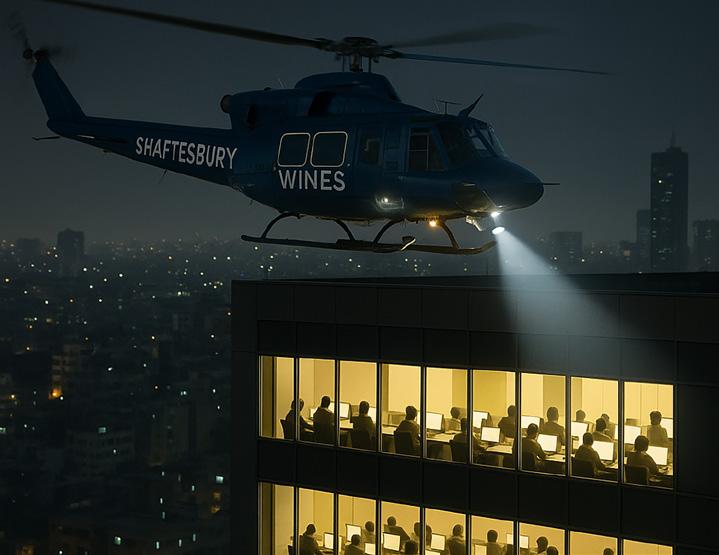
As a business you have to answer the phone when it rings. You have to answer it pleasantly, expecting a customer.
“Hello. Shaftesbury Wines …”
“Hello sir, how are you today can I speak to the owner of the business this is John from Acme Gas & Electricity company you are paying too much for your electricity who is your current supplier we can save you 30% even if you have unpaid arrears …” Click.
“Hello. Shaftesbury Wines …”
“Hello sir, how are you today …”
This can happen up to a dozen times a day and has been going on for years. What on earth do they expect to get out
of it? Initially I assumed it was some kind of fraud. Maybe if they know my current supplier or my meter number they can steal money or electricity. No, that can’t be it. Maybe they are testing my gullibility and if I pass, my number goes on a list for others to ring? Now, I think they are genuinely trying to get my business. That is never going to happen, is it?
I have tried all sorts of things to stop them ringing. Registering on the Business Telephone Preference Service makes no difference.
I have tried explaining that my electricity bill is so small (and we don’t have gas) that even a 30% saving would not compensate for the constant disruption. They don’t
care. I have tried explaining that any commission they might earn would be vanishingly small. They don’t care. I have asked what I can do to stop them ringing me. Nothing apparently, other than giving them all my business and bank account details and first-born child.
Generally, if I’m busy, I just put the phone down. Often it will ring again immediately, wondering why we were cut off. Mostly, I am not abusive. I wait for them to take a breath and then say, firmly and slowly, “go away”.
Nothing works.
I used to play a game. I’d put them on loudspeaker and make the occasional incoherent noise while getting on with other stuff. Five minutes is the current record before they hang up. Sometimes, if I’m feeling mischievous, I will tell them they have rung the wine ordering hotline and could I have the delivery address and card details for our special summer case offer. I just keep repeating it until they hang up.
To be honest, if I’m up to my neck in it, and it’s my friends from the electricity call centre again, it can be a relief knowing that I don’t have to do anything other than hang up. I get a bit worried for them if they haven’t called for a week. Stockholm syndrome, I suppose.
It is not always harmless, though. There was a period when it was quite abusive. I would get cross and say they had only just rung, always to be told that it was the first time. No, it isn’t. Then I’d get a torrent of abuse calling me a liar along with some pretty impressive swearing by someone for whom English is not their first language. On one occasion I thought I would have some fun and when they asked to speak to the owner, I told them she wasn’t here. That resulted in some unpleasantness, so I asked if he had an issue with me working for a woman. In response I was told, quite
I get worried for them if I haven’t heard from them for a week. Stockholm syndrome, I suppose
graphically, what he would like to do to “my boss”, accompanied by pornographic sound effects. I put the phone down only for it to ring again immediately, as he was evidently just getting into the swing of things. That is certainly illegal but, as I had already suspected, outside the UK’s jurisdiction.
When I have had time on my hands I have tried to gather information and investigate further. I would ask which town they are calling from. It ranged from London, Manchester and Southampton to, unexpectedly, Rugby.
I have tried tracing the numbers. It tends to be a company renting large blocks of non-geographic numbers to call centres. Occasionally I engage in a polite conversation and ask exactly where they really are, what time it is and what the weather is like there. Some have been remarkably candid. One pleasant enough chap admitted he was based in Karachi, Pakistan. That narrows him down to over 20 million people. Getting any job at all must be a struggle in the world’s twelfth largest city.
Spurred on by this information, I dug a bit deeper online and came across a recruitment advert for energy call centre representatives in Karachi. Now I knew the region of the city and, roving around Google Earth, could take a good guess as to the actual building. That should spook them next time I can be bothered to engage. I might describe the area, ask which floor they are on and ask them to look out of the window to see if they can spot me waving at them.
I also found out the qualifications required – none. Well almost none. It requires basic English and a willingness to work UK hours. The pay looks quite good until you understand the exchange rate. The starting rate is PKR 19,000 and PKR 5,000 commission. That’s £49.50 basic and £13.06 commission. And that is per month! £750 a year, if they are lucky.
Now I am beginning to feel a bit of sympathy. But only until the bloody phone rings again.
David Perry is the owner of Shaftesbury Wines in Dorset



�Where I see AI becoming really useful is in saving time generally, be it drafting tasting notes, blog posts, social media content or analysing sales data from last year to help predict growth. If it’s integrated well into a website, it could also make tailored wine and cheese pairing suggestions for customers, which adds a personal touch online. For me, AI will always be a support and never a substitute for the human knowledge, care and passion that make the wine trade so special.”
Jessica Summer * Champagne winner * Mouse & Grape, London
�We have already started to look at it closely for giving new life to the tedious but necessary 30-word tasting note and for customer mailout blurb. In fact, we did an experimental AIcreated mailout not long ago and it went down very well in terms of orders and responses. If you had hot-spots in your shop where you know product sold well it could help you optimise those; some sort of best-layout plan. Like anything else, if it is an easy solution that saves time, I’m happy to use it!”
Toby Peirce Quaff, Brighton



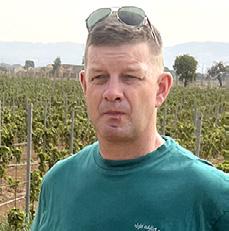
�I think AI will be a great help regarding wine recommendations, as it can suggest wines based on taste preference and food styles. It can help the consumer learn more about wines and in particular navigate wine lists and even wine regions to learn more. With regards to wineries, it could help with flavour profiles and blending. AI can also assist with pricing, analysing the market demand globally, auctions and critic scoring, all of which influence the pricing of wines.”
Frankie Mitchell Mitchells Wine Merchants, Sheffield
�Algorithms already suggest wines based on taste preferences and future AI may adapt to an individual’s evolving palate with extreme precision. Conversational AI assistants, like a digital sommelier in your pocket, could help consumers pick wines in shops or restaurants. AI can also analyse global sales, reviews and social media to forecast demand. Last but not least, it can be very useful to answer questions from excellent wine trade magazines!”
Kevin Bowers, VinedMe, north Norfolk
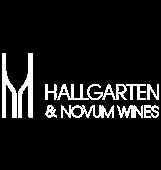
Champagne Gosset
The oldest wine house in Champagne: Äy 1584


I’m happy pouring wines for the rich –after all, we Orcadians know our place
In September 1909, Orkney was visited by steel magnate and philanthropist
Andrew Carnegie. He’d donated £1,500 for the building of a grand public library, and came to Kirkwall for the official opening and to receive the freedom of the burgh.
This was far from the start of book borrowing here: the “Publeck Bibliothick of Kirkwall” was founded in 1683, making it one of the oldest in the country. Carnegie’s grand building, with its honey-coloured sandstone pillars and roof of Norwegian slate, became the centre of both book lending and archiving for the islands. It served until 2003, when a much bigger building was built on the site of the old cattle mart, a few steps behind our shop. Historical documents from Kirkness & Gorie’s history are stored in the archives there, including receipt books going back to the 1860s.
The old library has been renovated and reinvented several times. The archive rooms were converted into a coffee shop and wine bar, which we’ve been supplying for 20 years or so. The grander main part of the building was reconfigured again recently at the hands of a thrusting young accountant. The upstairs offices are where the number crunching goes on. The two big rooms downstairs (where the racks of books used to loom) are now brightly coloured, stylish lounges, set up for workspace

anywhere. Conspicuous consumption is frowned on here. There’s a guy who sits on the windowsill of the museum just along from us, all day every day, whatever the weather. He drinks discreetly from cans of Lidl lager, smokes roll-up cigarettes, and occasionally leaves a damp stain on the pavement when he doesn’t make it to the public toilet quickly enough. He’s well respected: everyone passing by greets him or stops for a blether. He embodies a prized Orcadian virtue: Know Your Place.
sharing and business-meets-party events. There’s a token wall of books, but they’ve been chosen for the colour of their covers to match the paintwork, rather than anything using the Dewey Decimal system. It’s an admirable venture. Our town is stuffed with Victorian buildings: hard to maintain, expensive to heat, with limited access and strict planning restrictions. Good luck to anyone who commits to bringing them back to new life.
Last week we were hired to provide a wine bar for an evening of speeches and partying to celebrate the launch of a wealth management company. Being a small shopkeeper, I’ve never had to worry about managing any wealth, though managing the overdraft is an essential skill. The chief wealth manager is an ebullient Australian, so he asked us to provide a selection of ebullient Aussie wines to be freely poured as long as the guests lingered. I recognised about half the folk from the streets of Kirkwall, though only a few were customers of any regularity. I chatted with an oil refinery worker; a plumber who unblocks our toilets; a retired bank manager who told me our shop was one of the glories of Kirkwall though he only comes in once every three years. This is my problem: the people with wealth don’t spend it in our shop.
To be honest I don’t think they spend it
This is my problem: the people with wealth don’t spend it in our shop
The people who have wealth to be managed don’t drive fancy cars or buy fancy bottles of Champagne or claret. Their money’s tied up in investments or stashed in a bank. I suppose that makes our wealth manager happy: there’s lots of wealth to manage, and there’d be less commission for him if it was being spent on expensive booze.
The tasting was all very jolly, though it was clear that I was there to pour and smile and not get involved in any financial small-talk. I asked a passing accountant how to acquire enough wealth that I needed someone else to manage it for me. “You’d be surprised,” he said, and moved swiftly on. Actually, I wouldn’t be surprised: I know how it’s done. You have grandparents who farmed 100 acres on the edge of a small village called Kirkwall. A century later, as the town sprawls outwards, you divide up the old fields and sell them off one building plot at a time, £100k per site.
Sometimes I look at the adverts in glossy wine magazines like Decanter, advertising Fine Wine Encounters or Grand Vertical Tastings with distinguished Maîtres de Chai. There are always photos of deferential servers in white shirts and waistcoats pouring wine into the glasses of smiling, well-groomed guests. I can’t help it: I always identify with the wine pourer, rather than the one getting the wine poured for them.
I don’t mind too much, I know my place. Sitting on the windowsill of wine.
Duncan McLean is proprietor of Kirkness & Gorie, Kirkwall

With Flying Füchs
1. Arrange these California wine regions from north to south: (a) Santa Ynez Valley (b) Livermore Valley (c) Paso Robles
2. Methoxypyrazines are compounds associated with which distinctive wine aroma? (a) Turkish delight (b) Green pepper (c) Mushrooms
3. If an auction house adds the letters OWC to a wine’s sales description, what does this signify?
4. Which British rock star owns the Il Palagio wine estate in Tuscany?
5. What’s the Portuguese name for the grape variety also known as Merenzao and Trousseau? (a) Morono (b) Bastardo (c) Arce
Answers on page 23

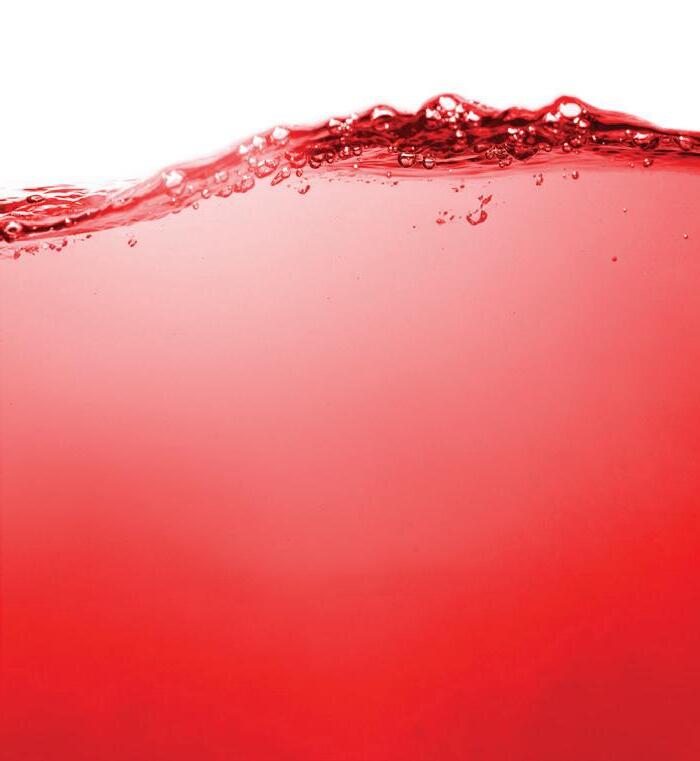
Kukla Spedition UK

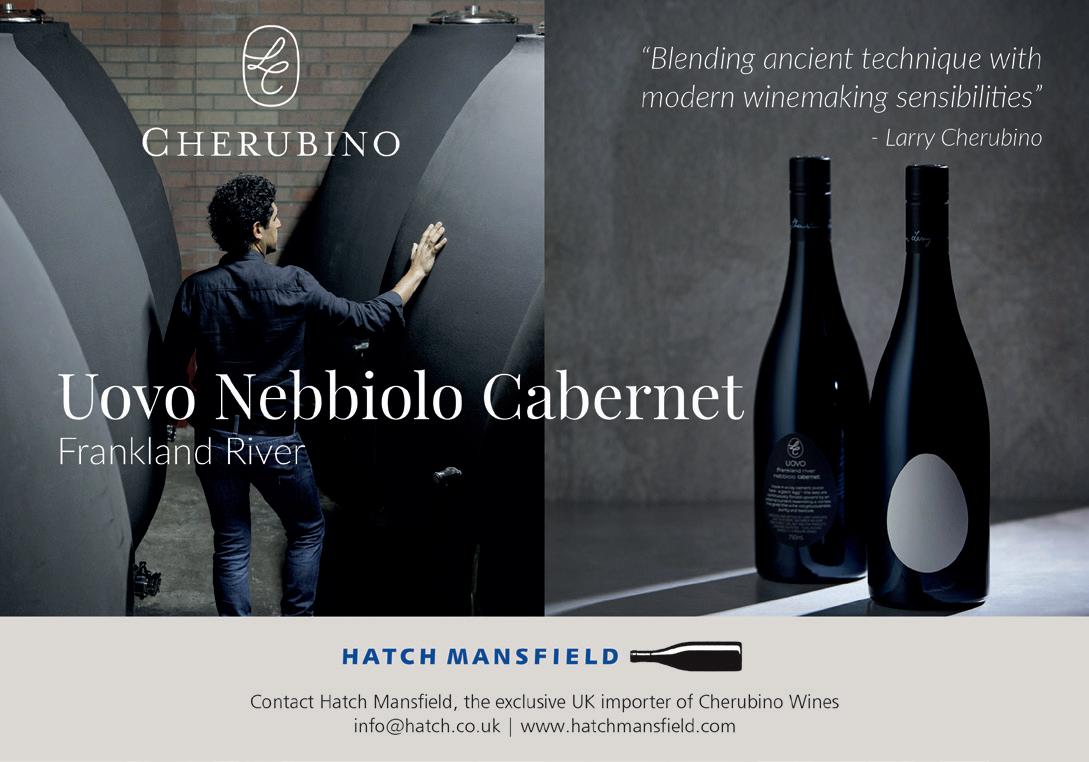
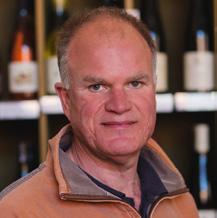
Shane Slater
Sheldon’s Wine Cellars Shipston-on Stour
Favourite wine on my list
We are really enjoying a Malagouzia from Alpha Estate winery. They are based in northern Greece, near the border with North Macedonia.
Favourite wine and food match
It is difficult to beat well-cooked beef with aged Bordeaux, but an off-dry Riesling with Thai Green curry is a real match. The Donnhoff Oberhäuser Leistenberg Riesling Kabinett works very well with the fragrant spice.
Favourite wine trip
Earlier this year we visited the Jura which was a first for us and we thought the surroundings, food and wines were great. The range of grape varieties and wine styles is both broad and exciting.
Favourite wine trade person
Richard Kelley MW from Dreyfus Ashby. He’s as mad about wine as we are and has the rather amusing tagline of being the champion of “the unknown, the unfashionable and the unsaleable” – all things we love here at Sheldon’s.
Favourite wine shop
When I visit Vin Neuf in Stratfordupon-Avon I always walk away with two or three bottles of interesting wine. James and the team are great and they have shown that it is possible to cram a well-curated range of wines into a small town centre space.
Chapel Down has scrapped plans to build a £32m winery as part of a strategic overhaul it hopes will return the business to profitability amid slowing demand for English wine.
Chief executive James Pennefather said cancelling the long-planned Canterbury site would save “significant” capital spending and would not affect growth targets.
The UK’s largest winemaker has had a challenging few years, swinging to a loss in 2024 after consumers cut consumption and poor weather hit the harvest. Financial Times, September 24
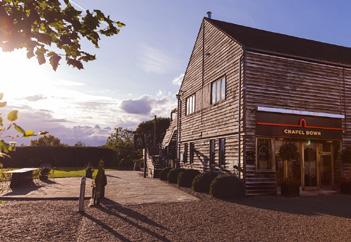
France has revoked approval for 20 copper fungicides, leaving organic growers facing strict limits and fears of losing key tools against downy mildew.
Authorities justified the move by citing health risks for vineyard workers, stating: “The available data do not allow for the exclusion of a risk of harmful effects for users.” They also said manufacturers had failed to provide sufficient safety data.
The new rules set a maximum of 4kg of copper per hectare per year. Applications must also follow a minimum interval of seven days, with restrictions on use near residential areas and waterways, and a ban on treatments during flowering.
The Drinks Business. September 23

German police in the Rheinhessen wine region were hunting for clues as to the whereabouts of stolen grapes after two producers reported harvest theft in the Gundheim district.
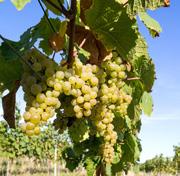
Nearly all of the ripe Riesling and Sauvignon Blanc grapes across an 8,000-square-metre area encompassing two vineyards have gone missing and are presumed to have been stolen.
Two independent winemakers have suffered economic losses of several thousand euros, said police for the German city of Worms, in the Rhineland-Palatinate region.
Decanter, September 19
On the night of September 28, Russia launched a drone strike against Ukraine’s Odesa region. There were no civilian casualties, but damage was recorded at a winery and a nearby private residence.
According to the State Emergency Service of the Odesa region, a workshop and a warehouse for finished products of the wine enterprise were destroyed. Mezha, September 28
• Jan Boland Coetzee, one of South Africa’s most influential winemakers and a Springbok rugby legend, has passed away after a brief illness at the age of 80. Decanter, September 16
Kermit Lynch, described by The Wine Spectator as “a Renaissance man of the wine world” and “one of America’s most influential and pioneering wine importers”, is about to publish his first novel, at the age of 83. Lynch, who now lives in Provence, has written “a paean to Provencal life, food and wine in general” called At Poupon’s Table, published by Podium. His 1988 book Adventures on the Wine Route is “the classic of the modern French vigneron movement”.
Wine grower Nicolas Joly, dubbed the “godfather of biodynamics” and lauded for his work at La Coulée de Serrant in the Loire Valley, is the recipient of Decanter’s Hall of Fame award for 2025.
Angelina Mondavi will become the first woman in her family to lead the winemaking at Charles Krug since the Mondavis acquired the estate in 1943, reports The Drinks Business. The move follows the announcement that longstanding winemaker Stacy Clark, who has held the role for 14 years, is retiring.
A French winery is toasting victory over Cole Palmer after giving his plans for a wine range with a similar name the boot.
Château Palmer opposed the footballer’s bid to flog plonk under his Cold Palmer nickname. Now the Chelsea and England star, 23, has dropped wine from a list of goods he hopes to sell using the brand name inspired by his shivering goal celebration.
Palmer wanted to use the name for products including wines, spirits and clothes. His legal team has now amended its Intellectual Property Office documents to head off the clash.
The Sun, September 23
Salut Wines in Manchester has posted an announcement on Instagram detailing its zero tolerance of abuse against staff.



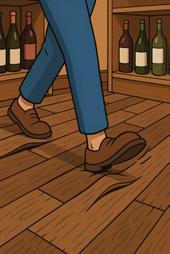
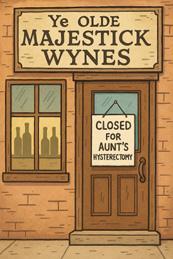

The statement said: “Our team works hard to make Salut a space where everyone feels welcome and looked after. Recently, we’ve had to remind a few people that respect is part of that. Abuse, harassment or inappropriate comments have no place here. Ever.
“Respect and kindness are nonnegotiable at Salut. Our team is here to make your experience the best it can be, and they deserve the same respect in return. We will not tolerate abuse of any kind – including offensive comments about race, sexuality, gender, or politics. Sexual harassment is also absolutely unacceptable.”
Manchester World, September 11
Answers to questions on page 19
1. (b) Livermore Valley (c) Paso Robles (a) Santa Ynez Valley
2. (b) Green pepper
3. Original wooden case
4. Sting 5. (b) Bastardo
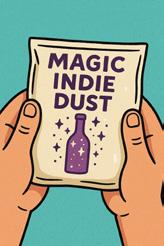

by Brett



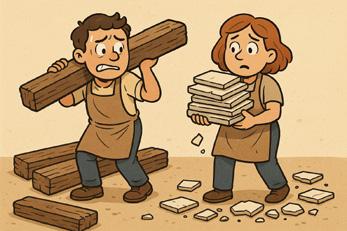

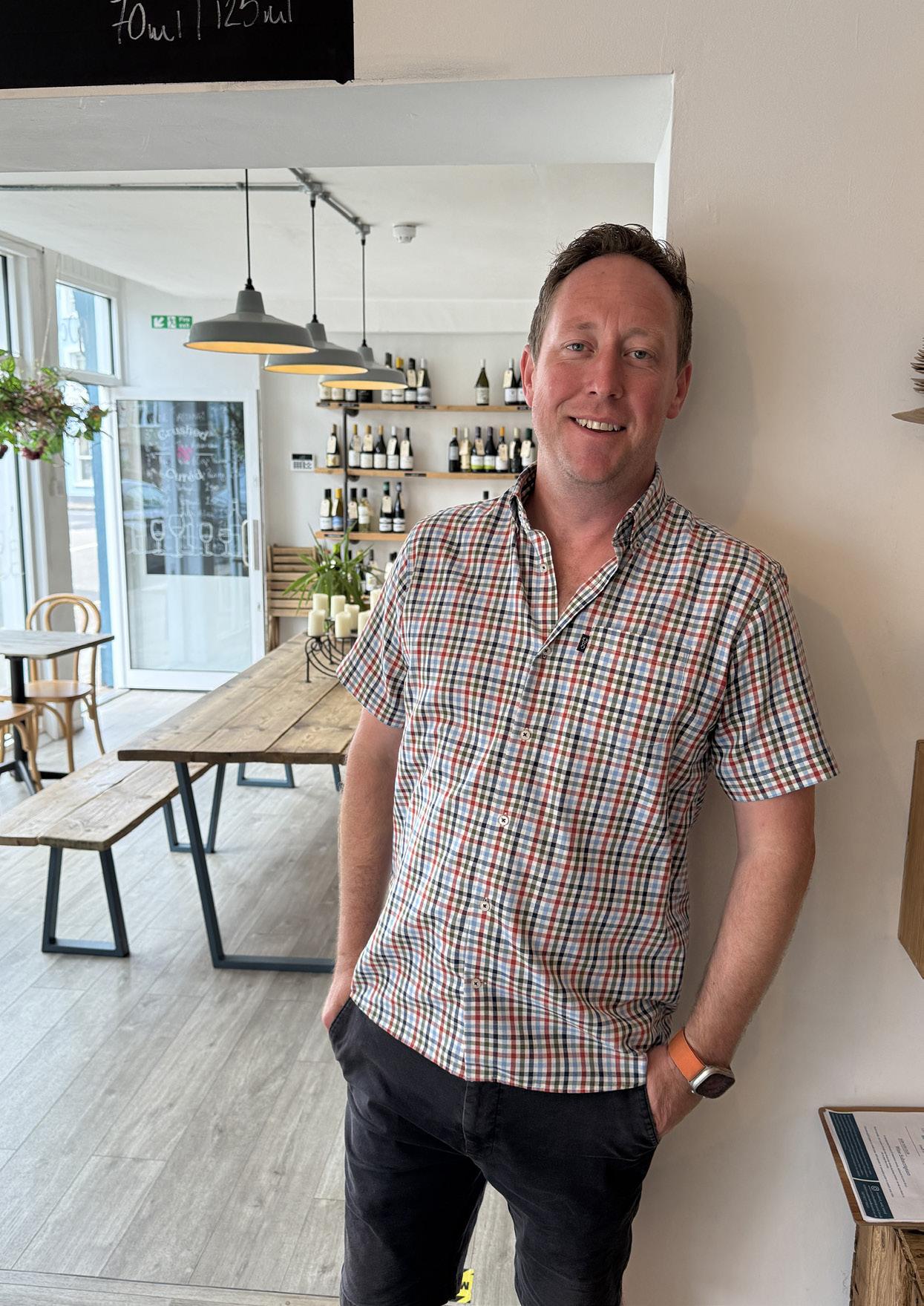
Three decades ago, George Bovill fell in love with Portsmouth’s beachside enclave of Southsea. Since 2022, locals have fallen in love with Crushed & Cured, the wine shop and bar that he’s created there.
Graham Holter pays a visit
Southsea feels like an archetypal south coast resort; from some angles it could be mistaken for Worthing or Bexhill. Yet zoom out of the map and you’ll see that it’s in the heart of Portsmouth, just not particularly near the warships, flyovers and postwar sprawl that the city conjures in the mind’s eye.
Southsea’s charms include the Clarence Pier amusement park, a canoe lake and a model village. Crushed & Cured joined the list of attractions in 2022: an inviting, double-fronted wine shop and bar, owned by George Bovill, who’s originally from Reading but has called this part of Hampshire home for almost three decades.
“I just fell in love with the place,” he says. “I love being by the sea. When the sun is shining, it’s a fantastic place to be, and there’s always lots going on. It’s got a great feel and it doesn’t seem like a big city.
“People here are really supportive of local businesses and local products.”
The premises aren’t on the seafront, but on one of Southsea’s main north-south roads, on the corner of a shopping street where independents seem to thrive. It’s spacious and inviting, with abundant natural light from the large east-facing windows. It’s hard to imagine a better canvas for a hybrid wine merchant – even though that wasn’t originally what this was going to be.
Bovill spent “20 years running restaurants for
“The hybrid bit just came about organically, really. I wanted to keep everything really simple in terms of the food offering”
other people, at site level, and then at regional manager level,” he explains. Covid brought that to an abrupt halt, and he took a job running marinas. “Which was a similar role, but I didn’t really enjoy it,” he says. “So I decided I was going to do something for myself. This was it.”
Wine had been an important element of Bovill’s early career, but had faded into the background as his seniority grew. He was keen to get back to his roots with his new venture.
Was wine always going to be the focus here?
Yes. And initially we were just going to be a shop, so for the first, I guess, six months, we were just retail. And then I realised two things: that we had a lot of space; and making money off retail is quite difficult.

So the hybrid bit just came about organically, really. I put the tables in and wanted to keep everything really simple in terms of the food offering: just cheese, charcuterie, with a couple of Spanish bits, but really just focusing on British producers and things that we can put together quickly and easily.
As we’ve got busier, and the venue’s evolved, I wanted to bring in some fresh elements. We’re looking at another revamp, just to keep things new and fresh. We change it every four months, I suppose – not fully, but just tweaking things. We have a lot of regulars so when they come in, there’s new things for them to explore.
What sort of team do you need to put that together?
Up until April, it was just me full time, and then I took Tansy on, who’s my first employee. She joined just doing weekends. And as we got busier, she joined the team full time. We’ve got three or four part-timers that do weekends and days when we need them.
It’s a decent-sized space. It feels like it wouldn’t feel too cramped even when it’s full. No, it’s not. I looked at trying to get a couple more tables in, but it became too tight. You want a bit of privacy and to enjoy the conversation without feeling like you’re sitting on top of somebody else. When it’s full it’s a great atmosphere, great vibes. It’s good fun, but very relaxed at the same time. People seem to have really bought into it. We can seat about 40 people and there are a couple of tables we can pull out if we need to.
What’s your crowd here?
We get all generations: young couples, a few students from time to time, and then people my age
“We’ve never put a New Zealand Sauvignon on the by-the-glass board, because that would be literally all we sold that month”
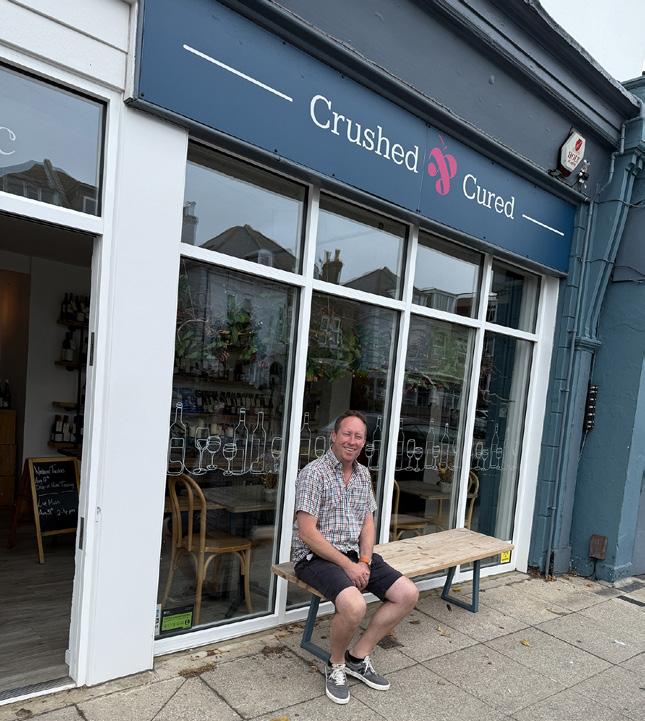
and older. People just want somewhere they can go where they know they’re going to get really good product and have a really, really good glass of wine – which is hard to come by, which sounds weird. But around here, there are a lot of pubs, and it’s pretty average stuff that they’re offering.
How do you get the balance right with the wine? I just wanted to be really accessible and approachable to people. I’m trying to break down that barrier: there is a thing around wine, with people not understanding it. We get lots of people saying, ‘we don’t know anything about wine’, but I tell them you don’t need to. You just need to know what you like and what you don’t like.
I guess there’s a lack of understanding around wine, especially old world stuff, where you’ve got grapes that aren’t on the label. People don’t want to feel like they’re being silly. And so we work really hard to break that down, just being really down to earth with people and trying to work out what they enjoy or don’t enjoy.
A lot of people just come in and go, ‘can you recommend something?’ You obviously get people knowing exactly what they want, but the bulk of people are open-minded.
What if someone comes in and says, I really love Jam Shed?
That’s a difficult one! If it’s that big, fruity style of wine they like, we’ve got lots of things like that, but it tastes 10,000 times better.
How do you select your wines by the glass?
We change them every month, there’s always new things to try. We try and keep some things off there that people would default to, so that they discover new things. We’ve never put a New Zealand Sauvignon on, because that would be literally all we sold that month. We’re trying to get people discovering new grapes, new wines, new styles.
What kind of wines have you got people into?
Chardonnay was one that initially we struggled with. People were very anti it, but we’ve always put one on, and it’s generally got some oak ageing on it, just to get people into it – which has worked, because we sell a lot more than we used to, for sure.
You never really know what’s going to go. Sometimes you put something on, and it absolutely flies out. We put a South African Shiraz on at the
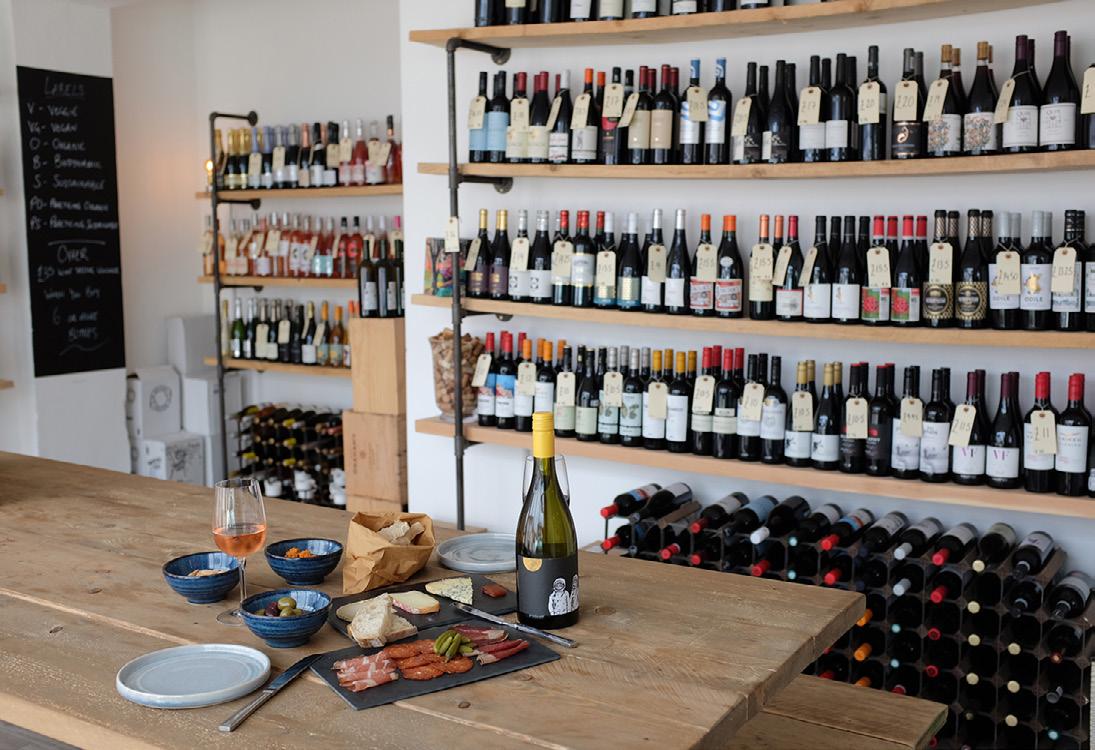
start of July. That sold out in the first weekend. People were just going crazy for it.
We don’t do a huge amount of high-volume stuff. We tend to do one, two, three, four bottles. We don’t really get people coming in and getting cases.
Is parking tricky around here?
It’s not too bad. Southsea is quite small, and people just tend to walk places. But if people drive, the parking isn’t terrible. If they buy a dozen of something, I just say, ‘pull up outside and I’ll run it into the boot for you’.
What’s your corkage charge?
It’s £10, and nothing on a Tuesday. Just to try and drive a bit of trade. It’s quiet-ish, and it’s helped us gather some really good momentum.
What about the rest of the week?
Our flight club on Wednesdays is really strong: we do three cheeses paired with three different wines for £15. People really like that. Thursdays it’s
“We had to move from one to two tastings a month because they were so popular. It’s different to going out for a meal or to the pub”
tasting night. Generally, our first two of the month are public tastings, which are really popular. They sell really well. I had to move from one a month to two a month because they were so popular. The demand was so high.
I think people just like an event. It’s different to going out for a meal or to the pub. It’s informative, it’s fun. You get to sit around the table here and meet new people. The uptake on it has been mega. There are people who are friends now because they’ve met here.
What’s the breakdown between your sales for consumption on the premises, and sales for taking home?
It’s about 60/40 sitting in to retail. It was around 50/50 but it’s swung slightly the other way. I kind of wanted to keep it around 50/50, but it is what it is and we’ll take what we can get. Christmas goes the other way, as I’m sure it does for everybody. You get a massive amount of people coming in and buying presents.
Tell us more about the range. It’s a mixture, I guess, of classic things from classic regions and countries, but then we try and find some more unusual stuff. So we’ve got quite a bit from Bulgaria, Romania, Georgia, that part of Europe, which I think produces some brilliant wines. The quality coming out of there is amazing. And then really, if it just tastes good and it’s interesting, if it’s slightly unusual or different, off the beaten track, we’ll get that in as well.
Who are your main suppliers?
Alliance and Liberty are probably the biggest two, and we work with Hallgarten as well. Then smaller ones like Graft, Stone Vine & Sun … The Jolly Merchants for all the eastern Europeans. I think what they have in their portfolio is great. Those are the top ones.
How do you make your buying decisions? Do you get good service from reps? Do you get to many tastings?
A bit of both. Stone, Vine & Sun and Jolly Merchants bring things to me quite regularly and we taste them here. I really like that more intimate way of
“The
frustrating thing is trying to keep some entrylevel stuff around the £9-£10 mark. It gets more and more difficult”
discovering wines. Then I go to the big portfolio tastings. It’s different, it’s quite chaotic, but it’s also good fun. I tend to write a few notes that will jog my memory and help me decide what to bring in.
Would you ever think about direct importing? It was on the business plan when I wrote it back in 2022 so yeah, never say never. But it’s about prioritising, focusing on making things go really well, and then down the line, potentially – yeah.
I guess your prices must have jumped up a lot over the last couple of years.
The frustrating thing, I think, is trying to keep some entry-level stuff that’s around that £9-£10 mark. It gets more and more difficult all the time.
Our sweet spot is between £15 and £20, I suppose. We try and keep things as reasonable as possible.
People just don’t have as much disposable income now. There’s less money to spend on leisure.
People still want to go out, and they still want to spend money, but what they want from that is a good time and a good experience, good service, good
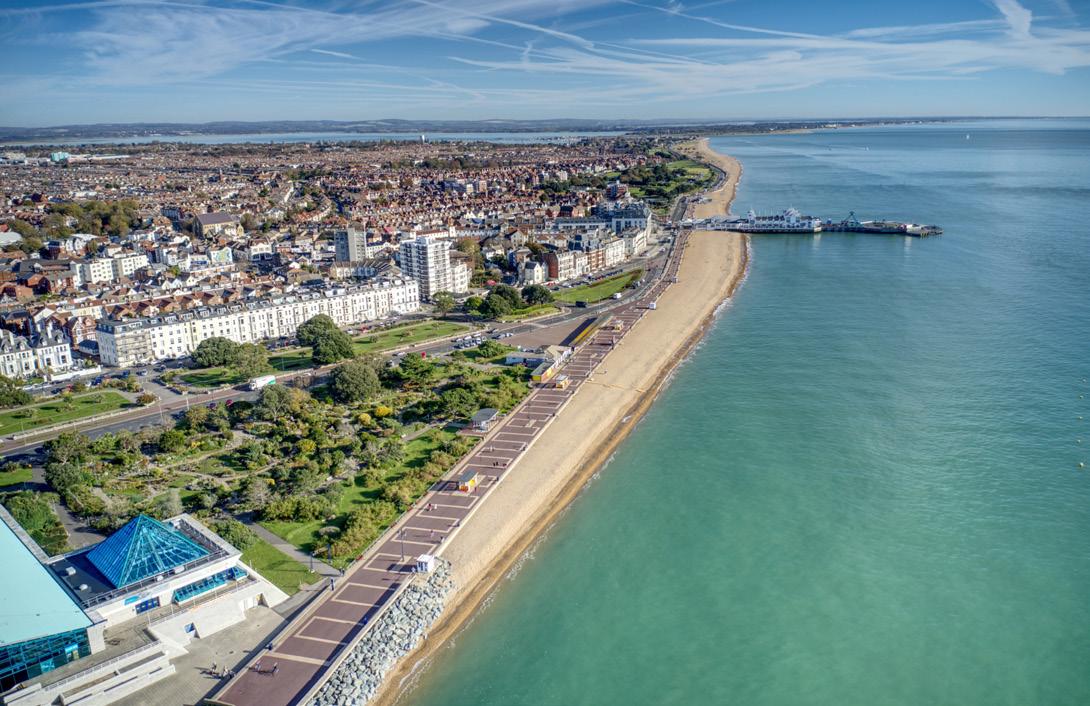
quality. And as soon as they don’t get that, they then question it.
So if a couple come in here, and they order a bottle of wine, some charcuterie and that sort of thing, how much would they typically be spending?
Probably around £60, £70.
You seem very comfortable with your social media appearances. Do you enjoy making those videos?
It’s very out of my comfort zone, really. But I wanted to do it for a long time, and I started working with a guy who films and edits them for me. I’m more comfortable doing it now. I watch them once just to make sure I’m happy, and then I can’t watch them again.
We used to do them in various takes, but now a lot of them I just do in one take, and it feels a bit more natural that way. I’ve definitely got better and I enjoy doing them now, actually. It’s good fun.
From an outsider’s perspective, it sounds like you’re working very long hours. Is that sustainable?
For the first two and a half years I was doing six days a week, 12 hours a day, which I think I just had to do. Now I’ve got Tansy full time, I get more time off and more support. But we’ve just got the business to that point where we can afford to pay her salary and keep the business profitable.
Would you like more time off in the coming years?
That would be very nice. I just got back from holiday – we went to Tuscany for a week. You know, I love [the job]. It’s fantastic being here when it’s busy and talking to people. It’s one of the best bits of the job. But yeah, I’d like to take a step back and do some other things. Maybe.
What’s your big thing outside of work?
Not huge amounts, just family time. Going to restaurants and eating nice food.
I keep bees as a hobby, which is fun. I had a load of honey at Christmas which I sold through the shop and we used on the menu. It was just something I started doing a few years ago. It takes me, like, an hour a week in the summer, and I just go down and do an inspection, check that they’re
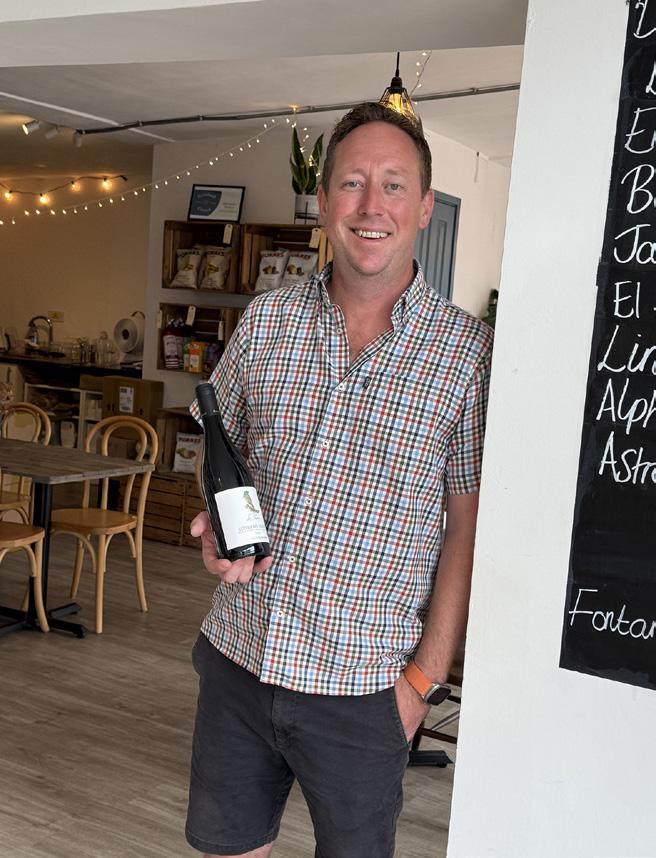
Bovill had to come out of his comfort zone to film his social media videos
“For the first two and a half years I was doing six days a week, 12 hours a day, which I think I just had to do”
healthy, and they’ve got enough space. It’s a nice way of getting out. It’s just you and hundreds of bees flying around.
Have you been stung?
Yeah, lots of times. You get used to it. You do swell up, but I’m not allergic, so it’s a minor inconvenience.
It sounds like everything’s going the right direction with the business. Is there anything you need to tweak or redirect?
No, it’s going in the right direction. I think it’s just about maintaining the standards of service and the way we look after people. But, yeah, I’m really happy with where it’s going.
You don’t know what’s going to come around the corner, but I’m pretty positive for the next 12 months.
For indies looking for exciting options beyond white Burgundy, Hatch Mansfield offers plenty of choice, as a recent masterclass demonstrated
Does new world Chardonnay have the elegance and complexity to rival Burgundy? A Hatch Mansfield masterclass in London last month made a convincing case.
Winemaker Larry Cherubino was joined by Hatch chief executive Patrick McGrath MW, brand ambassadors and 11 indies to explore six cool-climate Chardonnays that would charm even the most determined ABC die-hards.

Errazuriz, ‘Aconcagua Costa’ Chardonnay 2023 (ABV 13%, RRP £19)
“Chile is one of the global regions that’s entering this new fine wine wave, but offering outstanding value,” says Georgie Crawley from Hatch Mansfield. “Their era for fine wine, looking at terroir and letting that speak for itself, has really arrived.
“The Aconcagua Costa vineyards are around 12km from the Pacific Ocean, so they’re influenced by the Humbolt current. The soils are schist and alluvial and they also have this metamorphic rock that seams through them, which imparts a salinity to the wines.”
Although these vineyards are coastal, Crawley likens them to Burgundy in terms of the rolling hills and the cool climate.
“This is a new generation of Chardonnay from around the world,” explained McGrath as we sat down with wines poured from Argentina, Australia, Chile, South Africa and the USA.
It’s true the variety has struggled with its own PR over the last few decades. It suffered from its buttery, over-oaked ubiquity in the late 80s and early 90s and, according to Kat Stead from Brigitte Bordeaux in Nottingham, modern-day wine
“You can really compare this to any European counterpart. Alongside that lovely salinity, you get a bit of joy in the glass with the fruit. It has tension and vibrancy,” she adds.

Zuccardi, Apelación Chardonnay 2021 (ABV 13%, RRP £20)
“The last 20 years in Argentina has seen a revolution in the way we work,” says export manager Nico Angelini. “We have been focusing on and learning a lot about our terroir – and we believe that Chardonnay expresses that terroir very well.”
With so little rainfall in Mendoza, at Zuccardi everything must be irrigated. “We say we make mountain wines,” says
consumers can still be wary.
“Maybe they’ve had a Chardonnay in the past that they didn’t like and have therefore pigeonholed every single one,” she says. “A lot of customers don’t realise how different Chardonnay can taste depending on where it comes from and how it’s made.”
But as most in the trade know only too well, Chardonnay and its clones are nothing if not versatile, and can produce joyous, characterful wines.
Angelini, “and this Chardonnay is 100% influenced by the mountain. We’re trying to select the medium soils closest to the mountain with a high content of calcium carbonate, and the closer you get to the mountain the colder the weather, which sweeps through our vineyards, contributing to the freshness.”
There is no malolactic fermentation because Angelini says they want to keep the natural acidity of the grapes. 100% of the wine is fermented in concrete, followed by ageing 50% in concrete and 50% in large barrels to minimise the impact of oak.
Cherubino, Uovo Chardonnay 2023 (ABV 13%, RRP £23)
Larry Cherubino says the first thing he did when he took over this vineyard in Pemberton was plant more clonal Chardonnay, including GinGin. “We also call it hen and chicken,” he says, “because it sets with both really big berries and really

tiny ones. They’re intensely flavoured, so you've got a lot of complexity already on the vine.”
Cherubino paints a picture of lush green forests, home to ancient tingle trees. “We get about 1.4 metres of rainfall every year; it’s one place in Western Australia with an abundance of water,” he says.
The name Uovo (Italian for egg) and labelling echoes the fact that this wine doesn’t see any oak. It spends 14 months in concrete egg.
“People often ask me, ‘why is Western Australian Chardonnay so good?’ It’s because we’re able to get this opulent fruit character, but also retain acidity at the same time. You marry those two things together, and you’ve always got something that’s really yummy.”
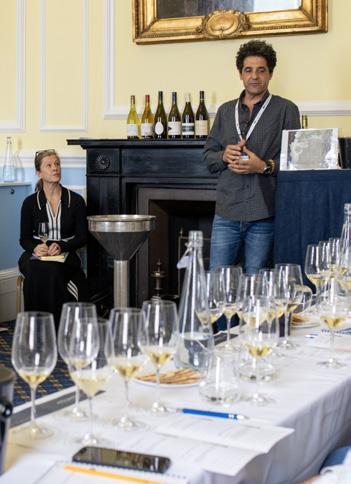
which is a bit warmer, and you get a lot of intensity from the old vines,” she explains.
“There was an article in an Australian newspaper recently all about Larry. It said that you have to be obsessive about viticulture. It’s no longer about tricks in the winery, it’s about the viticulture. That’s why I think Australia is performing so well. In the last 30 years I’ve seen exponential change in how winemakers understand their soils, their clones and their environment.
“I’m not going to diss Burgundy, because it’s my desert island wine, but

it’s too expensive. It’s the coming of age of Chardonnay right now. It’s 25 years since wines were made in that particular way. It’s like the antifreeze in Austria: it takes decades to get rid of these perceptions but it’s our job to do that, and we can, as long as we put the wine in front of people.”
Résonance, Willamette Valley
Chardonnay 2021 (ABV 13.5%, RRP £35)
A new world wine made by a Burgundian star, and Em Drake from Pacific Wines in London says it’s great for their business as “an ideal way to introduce customers to American wine”.
David Stephan, global export director of Louis Jadot, explains that as this particular vintage was subject to “a major dome of heat”, grapes were sourced from EolaAmity Hills, a much cooler area in Oregon, to add freshness, and Jadot has since purchased its own vineyard there.
be the assistant winemaker at Jadot, said he’s running the winery over there with that particular goal in mind.”
All the estate wines are certified organic and sustainability is also key. “Some people will argue that you cannot live without wine,” says Stephan, “but you can’t live without water either. At some point, wineries will have to make choices, and at Résonance, it’s all dry farming – no irrigation.”

Kleine Zalze, Family Reserve Chardonnay 2023 (ABV 13%, RRP £29) Patrick McGrath concludes the masterclass with a South African Chardonnay.
“All the wines today are about cool climate,” he says, “whether it’s up in the mountains or proximity to the ocean, which is the case here.”
The fruit for this wine grows on bush vines thriving in unique soils, known as Takulu, which are a mix of compacted granite and clay. The wine is a blend of 50% that has had prolonged skin contact and 50% that has been very quickly pressed.
“In the same way that Zuccardi is using a lot of concrete, RJ [Botha, the winemaker at Kleine Zalze] is beginning to experiment more and more with terracotta. There’s full malolactic here; it spends nine months separated half in terracotta, half in oak, before being blended together.
Robert Oatley, Finisterre Chardonnay 2022 (ABV 12.5%, RRP £26)
Katie MacAulay is the business development manager at Oatley where Larry Cherubino is also winemaker and viticulturalist.
“Finisterre Chardonnay is from two vineyards, Karridale and Wilyabrup,
“We’re not trying to do Burgundy style,” he says. “Our goal is to showcase another identity of Chardonnay in a different area. We also have a little bit more freedom because in Burgundy, you’re bound by the laws of the AOC, so in Oregon, we can have a little bit more fun. And our head winemaker, Guillaume Large, who used to
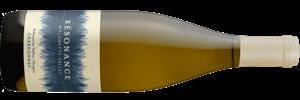
“This is the first release of the Family Reserve Chardonnay. It’s really linear with lots of fruit, and it’s so fresh and light.”
Garrafeira Nacional
Porto, Portugal
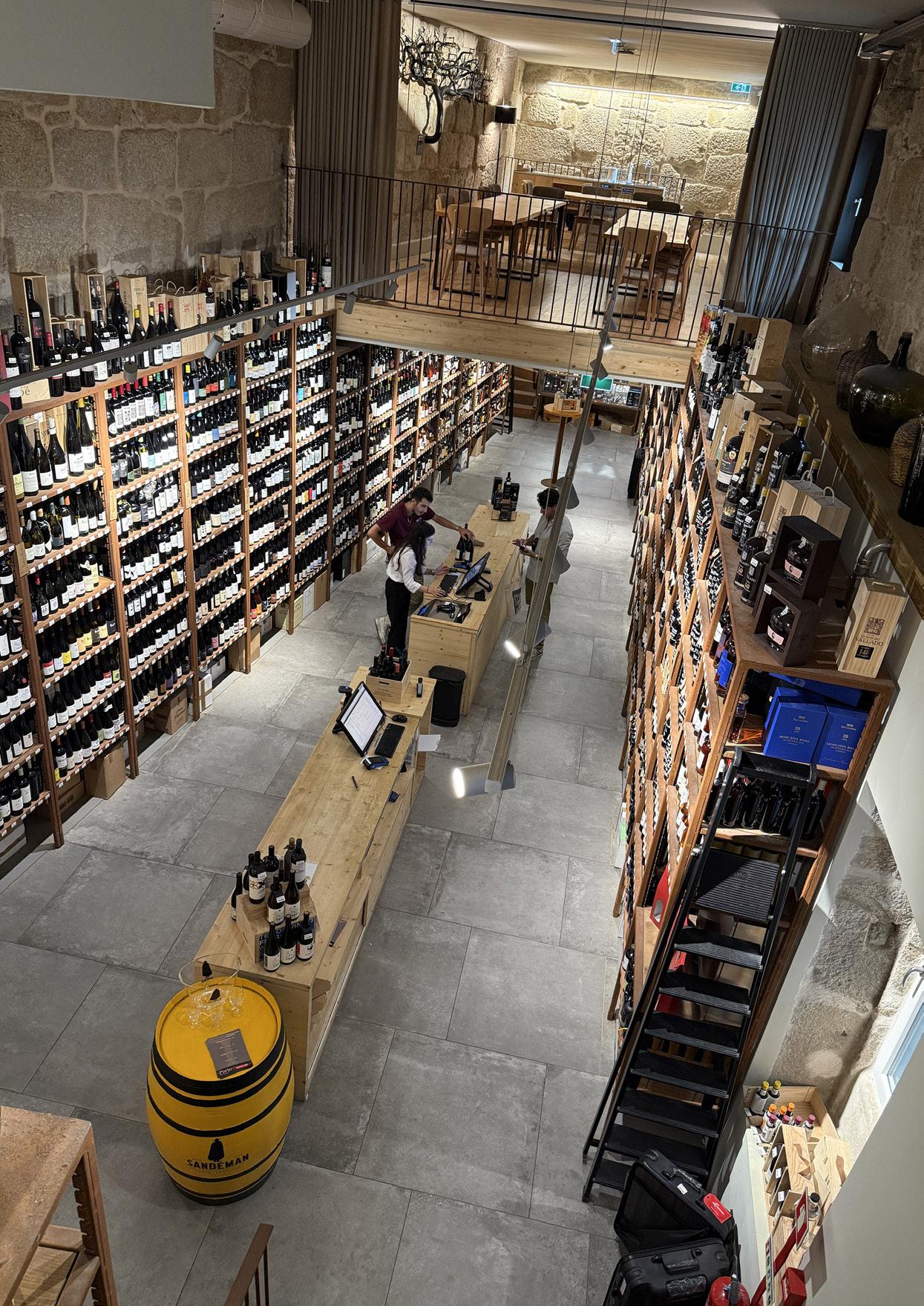

I’ve just drunk a litre of wine while running a marathon, and I’d do it again
There are a few reasons why the Marathon du Médoc is named “the longest marathon in the world”. Firstly – and trust me when I say this went down like a fart in a lift – the course was almost a mile longer than it should have been.
Of course, this is not what the organisers are trying to communicate with this tagline. They are talking about the fact that this is essentially a 26.2 (*ahem* 27.2) mile party that you’re aiming to finish as slowly as possible.
Writing this a couple of days after the race, it all feels like a fever dream, and not just because we’d been up since 5am and probably had heat exhaustion from the surprise 31-degree temperature we had to run in. I wrote some brief notes post-race, and one of them simply says “so much hot”.
This was our first visit to Bordeaux, and it won’t be our last (I can highly recommend the vibe of the city). Trampling our way through some of the finest vineyards in the world, gorgeous stretches of vines as far as the eye can see and with yet another beautiful château on the horizon, it’s quite easy to fall in love with the place. Naturally, we are remembering this through Bordeaux-tinted spectacles, because the bit they don’t tell you is just how much of a “watering” the vines get from the runners. I am hoping that it rains before the grapes are picked.
Texts from friends during the race sent condolences on having to drink red on such a warm day, but as these reds were served at cellar temperature, they
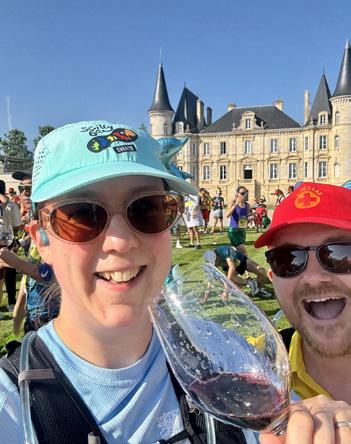
A
were surprisingly pleasant to drink. The generosity of the samples was the biggest surprise, though. Having a closer look at the pictures I took, we were drinking samples of 50-75ml. Multiply that by 21 different official sampling stations and it seems that we ran a marathon whilst drinking over a litre of wine.
Were we pissed? We certainly didn’t feel it, and I don’t think we looked like we were. The race director is reported as saying that “no one crosses the finish line visibly
drunk”. There were 125 people that didn’t finish the race this year, though …
Idid wonder how the château owners would feel about the race, with the best part of 10,000 wine louts passing through their land, dipping in the private lakes and generally causing chaos, but it’s very clear that they have a great sense of humour about it all. The welcoming atmosphere was incredible. Bands were playing and runners were stopping to have a dance. At Château Ducru-Beaucaillou, Monique Borie (who recently retired from the board) waved runners past from her balcony.
So, how does Mr B feel about it all? He had a dark few hours post-race. A first marathon in these temperatures will do that to you. We also spent seven hours on our feet and that is a long time (about an hour of that was standing around drinking wine, though). Technically, we also missed the race cut-off by half an hour. But given the conditions, the race organisers must have extended this (wisely they did not communicate this to runners, to encourage us to keep moving).
Would we do it again? I would. Over the last two days even Mr B has switched from “why would anyone do a marathon more than once?” to “maybe, but not next year”. Isn’t it amazing how the brain erases pain?
Cat Brandwood is head of private client sales at The Naked Grape
10,000 wine louts were passing through château owners’ land, dipping in the private lakes and generally causing chaos


Rosalia Molina’s remote Altolandon winery is so high up it can even produce ice wine. It’s the perfect location for a winemaker obsessed with organics, freshness and innovation
“We are in the middle of nowhere,” laughs Rosalia Molina. Her words are slightly distorted by a sketchy internet connection, presumably one of many occupational hazards that come with farming at 1,100m altitude on a remote plateau a couple of hours north west of Valencia.
Technically Altolandon comes under the Manchuela appellation. “But we don’t have a lot to do with the rest of the wineries since we have such a high elevation,” Rosalia says. “We are far away – around 200 kilometres – from the next winery in the same appellation. So we don’t see anybody around.”
Rosalia and her husband Manuel Garrote have been here since 1998. By that point she’d already gained a master’s in viticulture, oenology and wine marketing,
and worked in the vineyards and cellars of several Manchuela producers.
The site at Landete excited her as a place where days would be hot, nights would be cold, disease pressure would be minimal and fruit would express the freshness, clarity and natural acidity she wanted in her wines. An organic vineyard emerged, a winery sprung up, and soon Rosalia was harvesting her grapes with her three young children by her side.
“We have really hard winters, with a lot of snow and rain; we have fresh air all the time, so it’s easy to work organically,” she says.
“But for the first five or six years, everybody thought we were crazy, because nobody locally wanted to keep working in their vineyards.” Locals were bemused by Rosalia’s decision to plant vines in barren, stony areas, and to cut off what looked like
healthy grapes as part of green harvesting. “They didn’t understand that I wanted quality, not quantity,” she says. “And the vineyard that we planted in the stony area is one of the best that we have. So now everyone understands and everyone is happy.”
Rosalia has counted 14 soil types across the estate, ranging from very stony to more clayey, and each is suited to one of the many grape varieties she has planted. Bobal is Manchuela’s signature grape, and one that she enjoys working with. But her restless experimentation with other varieties has paid off handsomely.
“All the Bobal vineyards that we have are from people in the village who no longer wanted to work them. So we have vines that are between 40 and 100 years old,” she explains.
“And then we planted Syrah, because
we thought it was going to be really good in this area, and we’re really happy with the results. After that, we planted grapes that weren’t necessarily from Manchuela or even from Spain, like Cabernet Franc, Malbec, Pinot Noir, Touriga Nacional …”
But could these wines be labelled as Manchuela? “Yes. It’s a very small appellation, only 30 wineries, and they’re very open minded,” Rosalia reports. Even her pioneering ice wine has been welcomed into the fold.
She’s fascinated by amphorae and what these vessels bring to her wines. Oak barrels won’t be retired any time soon, but you get the impression that when Rosalia sees the opportunity to buy an amphora, she seizes it. “We started with amphorae about 20 years ago,” she says. “We love the results and we keep buying small ones and we’re making more and more wines in them – orange wine, ice wine. Recently we bought 12 really big amphorae from a winery in the area which are 200 years old.”
What are the biggest problems
Rosalia faces working in such a marginal location for viticulture? “People,” comes the quick reply, by which she means finding enough workers to help in the vineyards (the village population is only about 800). Frost has been a hazard as late as June, and three years ago “there was no water at all”.
“So the only problem is we are at the limit,” Rosalia says. “Sometimes when we are finishing the harvest, everything around us is covered in snow. But apart from that, I think everything we have is a big advantage for us.”
Rosalia’s enthusiasm for biodiversity means she’s happy to welcome visitors such as deer and wild boar and to tolerate the modest amount of damage that they do. Peacocks also roam the vineyards, along with her neighbours’ sheep and chickens. It all fits into an approach to sustainability, and biodynamics, which also takes in things like composting, solar panels and rainwater collection. “We have a clear idea to make everything here as natural as possible,” Rosalia says.
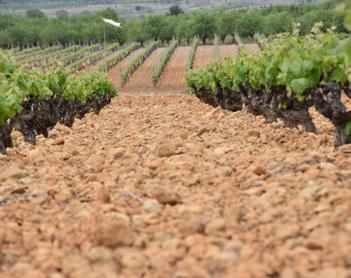
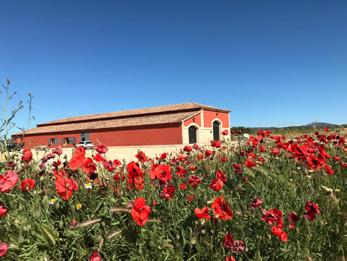
Visit the Alliance Wine website for the full range of Altolandon wines
RRP £16.75, now £14.75 on the winter promotion
The wine is always harvested late, never before October 12. There is skin contact for two to three weeks before spontaneous fermentation. Malolactic fermentation takes place in barrel, in outside temperatures that can dip to -15 C.

She lets slip that, the previous night, she was working until 3am in the winery and was back there at 6am. No coffee was involved, she insists. Just a restless energy to experiment and play.
Does she have time for a life outside wine? Absolutely, she says. “I love music, and we used to go to a lot of concerts. I love photography. Gastronomy. I have a very big family, so we travel a lot. So I have a lot of hobbies. It’s not only wine.”
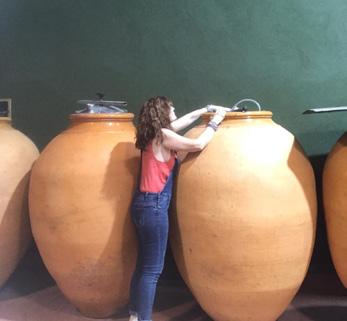
In association with Altolandon and UK importer Alliance Wine Find out more at alliancewine.com

“Bobal does not always have a good name because most of the time it makes very big wines,” says Rosalia. “So we try to make a really fresh style. We make two Bobals: one is more serious but this one is fruity and fun. When we’re making it, the whole winery smells like candy.”
The wine is spicy, juicy and well-rounded, with a fascinating crunchy-fruit freshness.
RRP £24.49; now £19.99 on the winter promotion
“People go crazy when they hear about an ice wine from Spain,” laughs Rosalia. “I’m not a big fan of sweet wines, but I am a fan of ice wines.

Twelve years ago we forgot to harvest one of our parcels and the grapes were totally frozen, so I decided to make a small barrel of wine and I was surprised with the results.”
Made with 100% Petit Manseng, Dulce Enero is now a fixture in the Altolandon range, with grapes pressed in the vineyard before the ice crystals break down. Fermentation is very slow, taking as long as three months.
The wine is golden in colour, with intense tropical aromas. The palate is packed with stone fruits, with the sweetness balanced by crisp acidity and a mineral streak.
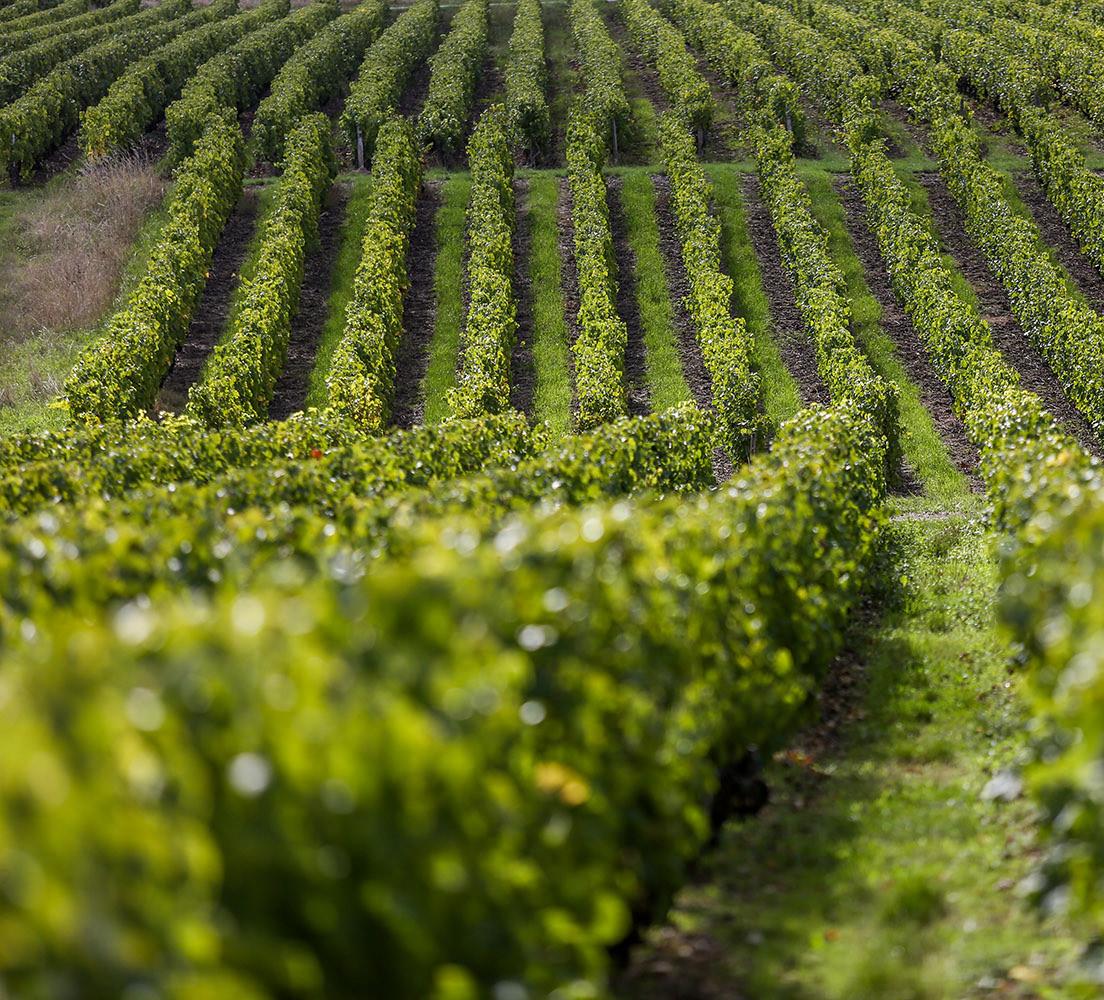
Vouvray represents a masterclass in how a single grape variety can shape-shift and stretch itself. From bracingly dry sec styles to luscious moelleux, from still wines to pétillant and traditional-method sparklers, it’s a region where Chenin Blanc performs its complete and remarkable repertoire.
At the drier end of the spectrum, Vouvray delivers taut acidity, orchard fruit and a mineral edge that makes it a natural partner for shellfish or goat’s cheese, or simply a refreshing aperitif. The demi-sec styles have an off-dry appeal that combines perfectly with many Asian dishes and
mature cheeses.
Moelleux and liquoreux Vouvray – only produced when noble rot deigns to make an appearance in the vineyard – can age for decades, developing honeyed, waxy, trufflelaced complexity, but with a fresh snap of acidity. These are world-class sweet wines, and at prices that wouldn’t suggest so.
Then there’s the fizz. Vouvray is one of France’s most important regions outside Champagne for sparkling wine, and the zippy, crisp style offers a price/quality combination that is widely appreciated by French wine consumers – and increasingly in export markets like the UK.
It’s a landscape where Chenin shines many styles that there’s one for every
Vouvray’s marketing strapline is “2,200 hectares of vines, 150 domaines, one variety”. In some parts of France, vignerons can be reluctant to focus the spotlight on individual grapes. But in this unassuming right-bank section of the Loire valley, east of Tours, Chenin shines brightly, and growers are more than happy to say so.
Vouvray has a long track record in the UK market, so benefits from name recognition among consumers. It also helps that Chenin Blanc (sometimes referred to locally as Pineau de la Loire) is widely known. But,
brightly, making wines in so every palate and every occasion
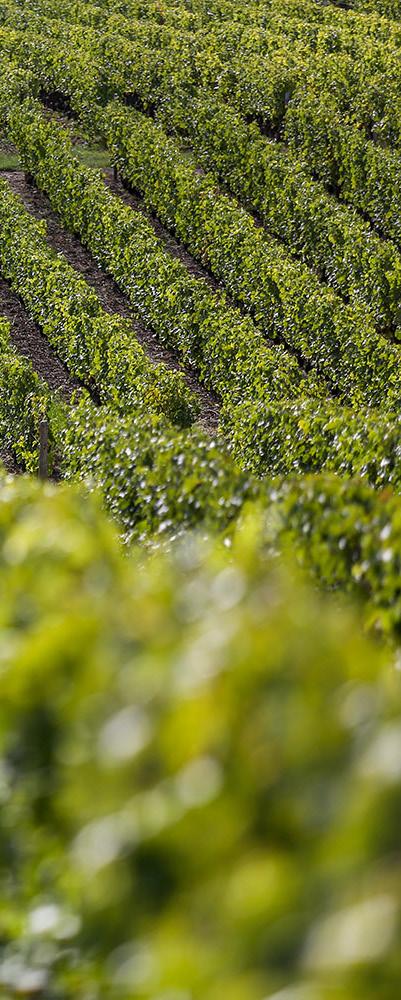
as Guillemette de Reviers, director of the Syndicat des Vignerons de Vouvray points out, consumers are frequently amazed by the breadth of what they taste.
“A lot of people are surprised by Vouvray,” she says. “They’re discovering the diversity of the range of styles on offer, and how well these styles pair with food, so there’s a whole gastronomic aspect to how the wines are perceived.
“Research that we’ve commissioned in the UK tells us that a modern Vouvray consumer is more likely than ever to be female, perhaps living in a city, and interested in wine and food pairings,
especially involving cheese.”
De Reviers is encouraged by the way sparkling Vouvray is being enjoyed by consumers, and regards this as a central part of the region’s appeal to modern wine drinkers. “Many of these wines are vintage bottlings with long maturation in the cellar,” she adds.
“Some of the wines come from a new generation of producers who care deeply about the land they work with and are producing interesting lieux-dits wines, which add another layer of complexity to what Vouvray has to offer. Organic viticulture is becoming more common, and even producers who aren’t applying for organic certification are working hard to reduce their impact on the soil and to minimise the applications they use.”
A region-wide study of Vouvray’s terroir got underway in 2021, digging deep into the ground to map out the soil and bedrock. Vouvray often conjures images of troglodyte caves carved out of the porous, crumbly tuffeau limestone which underpins much of the region. As well as creating excellent underground storage for ageing wines, this rock encourages the deep penetration of vine roots, with all the advantages this has for grape growing.
But as producers grow increasingly captivated by small-parcel wine production, the study will reveal more about the way vines behave differently in soils that might have a bigger component of clay (potentially giving fuller wines), or sandy gravel (where lighter, more aromatic wines might be possible).
These are already exciting times for Vouvray wines. It seems that excitement is only going to build.

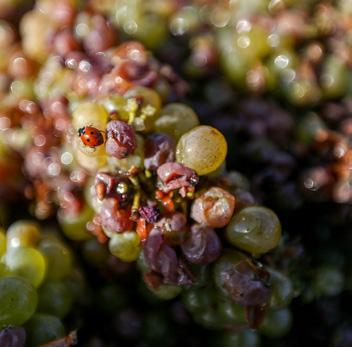
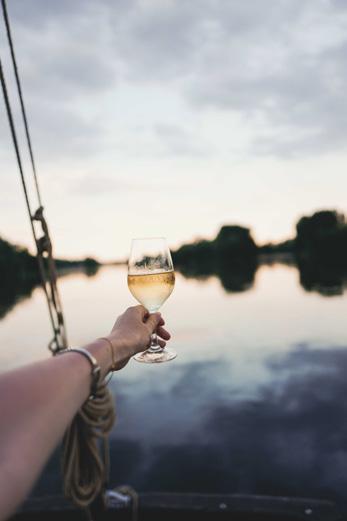

In July, Vouvray hosted the third day of the Chenin Blanc International Celebration which took part in locations across the Loire valley.
It was a chance for Vouvray to highlight its iconic sparkling, dry, demi-sec and sweet wines, all of which underline the versatility of the variety.
According to the Wine Trade Monitor 2024, Chenin Blanc is among the most soughtafter grape varieties in global markets, showing the most marked increase in interest since the previous study.
Chenin Blanc was listed as one of the top five grape varieties whose demand will increase the most in the coming two years among wine professionals and is in the top three most dynamic grape varieties for professionals in the UK, Canada and Belgium.
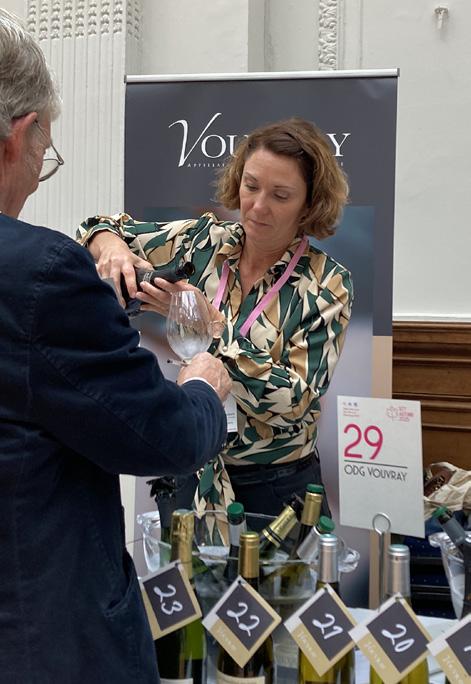
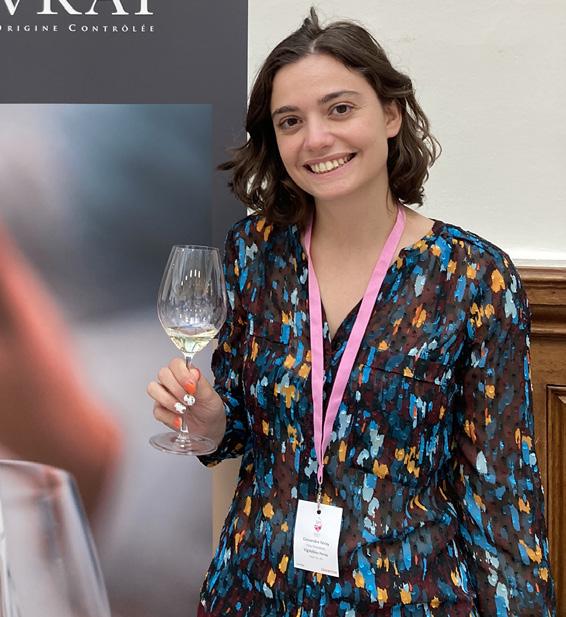
“Chenin Blanc is a very gastronomic grape. It has weight, but it is also delicate, and it changes so much in the glass – and over the course of a meal – that it always has something to offer.
“There is so much diversity in Vouvray. We’re not such a big area, but there are many different terroirs. More producers are making wines from single sites because they want to show the potential and variety of Chenin Blanc. We are going to see more of this.
“We have many producers who are now making lieu dit wines. It allows us to show many styles from different terroirs.”
Anne-Laure Brisebarre, Vignoble Brisebarre

“A sweet Vouvray wine with blue cheese is one of the great combinations. It’s a classic for a reason.
“But Chenin Blanc offers you every style that you want: from dry to sweet, oaked and unoaked. It is a real voyage of discovery, and that is great for the consumer.”
Cassandre Feray, Domaine de Moncontour
“We know that demi-sec is not a best-seller wine, and it is becoming rarer, but it is the origin of Chenin Blanc in Vouvray, and we love it. It is more versatile than people think, and we notice that younger drinkers are choosing it more these days … if we can’t sell it, no problem: more for us in the cellar!
“I love that Chenin can pair with almost any food. It is so easy-going, but it also has balance, structure and amazing length. It is the definition of quality, and so often offers consumers really good value for money.”
Coline Caron-Chouin, Domaine de la Rouletière

Sponsored feature
Domaine Vigneau-Chevreau
Clos de Rougemont 2023
Impressively rich: the autumnal stone fruits have an attractive smoky edge thanks to vinification in barrel. Lovely texture, with a long finish. Grapes come from limestone soils and are tended biodynamically. A wine with the structure for foodies and fans of aged wines alike. UK importer: Thorman Hunt
Vignoble Alain Robert Ammonite 2023
Aged in barrel for 12 months on its fine lees, this benchmark Chenin Blanc has generous notes of quince, honey and baking spice. Made from the estate’s oldest vines, Ammonite is both supple and moreish.
UK importer: Mumbles Fine Wines
Domaine de la Fontainerie Sec 2023
There’s a lovely spring in the step of this Vouvray. Yields are carefully managed to secure healthy, flavoursome grapes. The result is a tangy, green apple and Mirabelle plum flavoured wine. Seeking UK importer
Domaine Florian
Le Capitaine les Aumônes 2022
Strikingly flinty. The nose is an inviting mix of clementine, honey and spring flowers. South-facing vineyards seem to have added suppleness to what is still a very fresh Chenin Blanc.
Seeking UK importer
Château Gaudrelle Le Sec 2023
The advice is to open the bottle an hour before serving – not a bad idea given its elegance but undeniable heft. Aged in barrels (30% new) from locally sourced oak, this is a young wine with some distance to travel. In the here and now it’s a preview of a spectacular show to come. Sold in the UK by Tanners Wines and Neeche Wines
Domaine Sébastien Brunet Fosses Rouges 2022
One of many Vouvray producers keen to show the quality and diversity of Chenin Blanc harvested from lieux-dits. Fruit picked from north-facing, red clay soils has yielded a wine with a floral, lightly tropical nose, leading to a broad stone fruit and preserved lemon palate. Super length. UK importer: Indigo Wine
Sarah McCleery picks some favourites from the recent SITT tasting
Domaine Francois et Julien Pinon Les Déronnières 2022
Oozes quality from the first sniff. Floral notes with acacia, fresh herb and peach. The palate has a voluptuousness character that nevertheless has nuance, kept bright with salinity and pitch-perfect acidity.
Great ageing potential.
UK importer: Boutinot
Domaine Benjamin Serer
Les Trois Chênes 2023
Spontaneously fermented and neither fined nor filtered, this Vouvray bristles with energy: precise apricot and quince fruit, with tangy saline notes and strands of limestone minerality.
Seeking UK importer
Domaine d’Orfeuilles
Silex d’Orfeuilles 2023
Not a shrinking violet! Oak-aged – 25% new – with regular bâtonnage over several months, this is bold and opulent. Impressive balance and freshness supporting a generous mouthful of honeyed orchard fruit.
UK importer: The Winery
Domaine Sylvain Gaudron Demi-sec 2022
It’s a tragedy that there’s not more demi-sec like this around: such strong commercial appeal, and undoubtedly delicious with goat’s cheese too. A lovely underscore of acidity brings balance and verve to the red pear fruit.
Sold in the UK by Alexander Hadleigh Wines
Domaine Eric Gaucher
Grains de Chenin 2022
Irresistible sweet smoky aromas lead to a moreish palate of juicy, baked peach and Mirabelle fruit. Judiciously managed acidity keeps the wine on the right side of sweet; the result is a versatile and hugely drinkable Chenin.
Seeking UK importer
Domaine des Aubuisières
Cuvée Zéro Extra Brut 2018
Second fermentation on the lees is four years long, and you can tell! Bone dry but with good flavour and length. Has an elegance that would make most sparkling wine connoisseurs take note.
Seeking UK importer
Domaine Damien Pinon Le Brut NV
30-year-old vines give the fruit for this stylish, full-flavoured crémant. There is the lightest touch of brioche with red pear and apple fruits, enveloped in a creamy mousse.
UK Importer: Graft Wine
Château de Moncontour
La Grande Réserve 2021
A pretty, pale gold sparkling with fine bubbles and a soft, appley palate that makes it an irresistible aperitif choice.
UK importer: Hay Wines
Maison Darragon MT Brut NV
Vibrant, apple-driven, traditional-method sparkling wine that has an abundance of charm. Quite a soft example, and very easy to drink with or without food.
Seeking UK importer

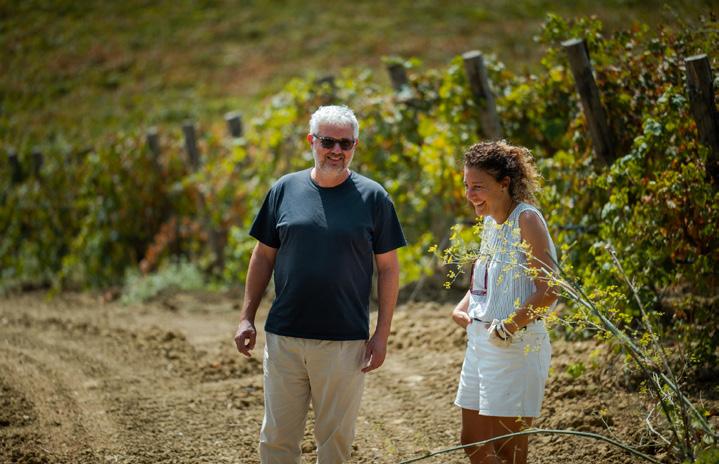
The Vesco family make sought-after organic wines from three locations in Sicily. Marsala is a tradition that they are proud to continue, as owner Andrea Vesco explains
Sponsored feature Wines are imported by Alliance Wine
Tell us about Rallo. How important is the Marsala tradition to you, even though your main focus is still wines?
Rallo has always been deeply connected to the Marsala tradition, as it represents both our history and the culture of western Sicily. While our main focus today is on still wines, Marsala remains a cornerstone of our identity, a heritage we are proud to carry forward with the same care and passion as previous generations.
Can you briefly talk us through how Marsala production works?
Marsala is produced by fortifying a base wine – traditionally from local varieties such as Grillo, Inzolia and Catarratto – with a small addition of grape spirit, then ageing
it in wooden casks. The ageing process, whether in the traditional solera system or in individual barrels, gives Marsala its remarkable complexity, with layers of dried fruit, nuts, spices and savoury notes that evolve beautifully over time.
Tell us about the vineyards where you source your Grillo and why the variety works so well in Marsala.
Our Grillo comes from vineyards in Marsala, western Sicily, where the combination of sea breezes, limestone soils and abundant sunshine brings out both freshness and structure in the grapes. Grillo is ideal for Marsala because it naturally combines richness with acidity and minerality, giving the wine both depth and longevity.
Rallo Azienda Agricola, Soleras 20 Year Old Marsala
A full dry, yet smooth and rich wine. On the nose this is intense, harmonious and delicate, with a pleasant scent of apricot, honey, dried fruit and dates. Dry in the mouth, round with bitter almonds, smoked vanilla and long persistence. RRP £45

What sets your Marsala apart from others, from a stylistic point of view?
We remain committed to an artisanal style, respecting traditional methods while highlighting purity of fruit and terroir. Our Marsala wines are elegant and balanced, with a freshness that makes them versatile, rather than overly heavy. This balance sets them apart and makes them appealing to a modern audience.
Has the style remained consistent over the generations or has it evolved?
The core identity has remained faithful to tradition, but of course each generation brings refinements. Today, we emphasise quality over volume, focusing on careful vineyard work and long, patient ageing. This approach has given our Marsala greater finesse and definition while still respecting its authentic character.
How does Marsala fit into a modern wine range? How can we persuade young people to try it?
Marsala can play a dual role: as a fine sipping wine in the same league as sherry or Madeira, and as a creative ingredient for food pairing and cocktails. For younger audiences, it’s important to highlight versatility – whether enjoyed neat with cheese, as an aperitif, or as part of a mixology trend. Presenting Marsala as both traditional and innovative helps connect it with new generations.
What are your favourite food matches for your Marsalas?
Marsala pairs wonderfully with mature cheeses, charcuterie and savoury dishes like mushroom risotto or roast meats. The sweeter styles are perfect with tiramisù, cannoli or dark chocolate. Personally, I love the dry styles with Sicilian tuna dishes, where the umami and saline notes complement each other beautifully.
Rallo Azienda Agricola, Marsala Mille Semi Secco Light golden amber colour, with an intense bouquet; delicate, smooth and nutty with honey, apricot jam and vanilla on the palate. Serve with strong, herbed cheese, or as a refreshing and refined aperitif. RRP £39

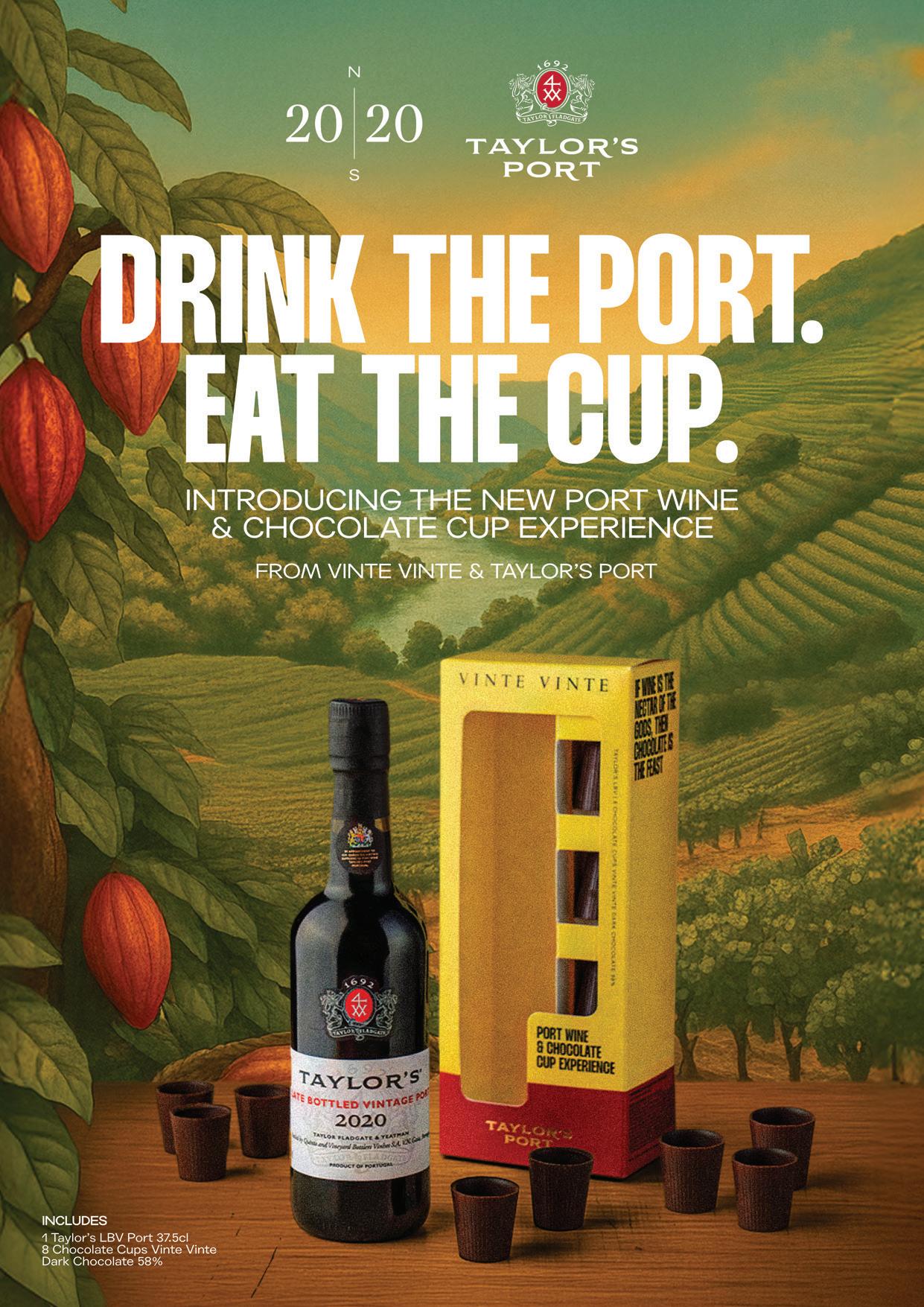
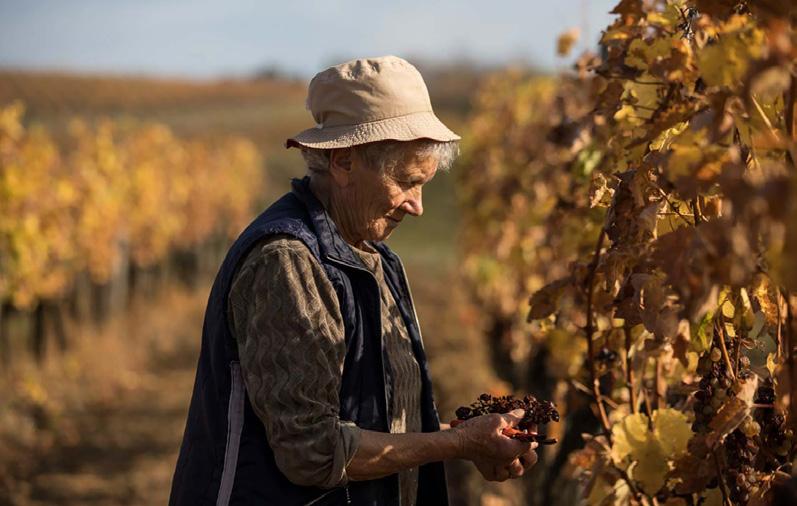
A highly skilled picker carefully hand-selects individual botrytised Aszú grapes
It was Louis XIV who described Tokaji as “the wine of kings and the king of wines”. And it was Hugh Johnson – wine trade royalty, it could be argued – who played a key role in creating the region’s most illustrious producer.
In 1990, Johnson led a consortium of overseas investors to found Royal Tokaji. It was a move that, at a stroke, brought together the vineyards, experience and expertise of 62 landowners. After years of decline under communism, Tokaji wines were back on the map, and ready to be explored by wine connoisseurs.
Today, Royal Tokaji is still privately owned and is the region’s leading producer, making dry as well as sweet wines that are enjoyed in more than 30 export markets. Its wines have won more than 100 awards, making it one of the region’s most awarded producers. Royal Tokaji has also featured in The World’s Most Admired Wine Brands by Drinks International for many years.
Royal Tokaji’s range of wines includes excellent dry styles, along with a classic selection of late harvest and Aszú wines. Among these, the most notable are the classic Blue Label 5 Puttonyos and Gold Label 6 Puttonyos wines. It also produces Essencia, the region’s rarest and most coveted wine, which is made from the free-run juice of Aszú berries. Additionally, its By Appointment range features limited-edition, small-batch wines crafted from the company’s finest grapes and vineyards. These wines are often issued as specific vintages, showcasing single grape varieties or traditional styles
Dry Furmint
RRP
£16.50
A fresh, dry, crisp wine showing all the fine qualities of the unique Furmint variety. Aromas of grape flowers, apple and pear combine with flavours of ripe apricot and peach to produce a sleek, intense dry wine with a long, refreshing finish. Fermented in stainless and barrels (15% new oak), then aged on fine lees for to add subtle complexity.
Furmint Vineyard Selection
Furmint
RRP £23
Produced from grapes selected from the finest classed growth vineyards in the village of Mád.
A concentrated wine with a firm but floral aroma, hints of apple and gooseberry, leading into a well structured style with minerality, spice and a long fresh finish. Fermented and matured in 300 and 500-litre Zemplén oak barrels for nine months.
Furmint Single Vineyard
Mézes Mály
RRP £28
A single-vineyard dry Furmint, selected from the famous Mézes Mály vineyard, which is one of just two classified as a Great First Growth. Its volcanic bedrock is overlaid with deep loess soil, giving elegance, finesse and floral notes to its wines. The wine is fermented in Zemplén oak barrels, then matured for an additional 10 months.



Royal Tokaji wines are regarded as world classics – but without the efforts of enthusiasts in 1990, they might have been lost to history.
Find out more at fells.co.uk
Feature produced in association with Fells
Sweet Szamorodni
RRP £22
Winner of The Wine Merchant
Top 100 Best Value Fortified & Sweet Wine Trophy 2025, Szamorodni means “as it comes”, which reflects the grape harvesting process, whereby whole bunches are picked including botrytised, overripe and fresh berries. This blend preserves acidity and freshness, whilst delivering the luscious, sweet flavours for which Tokaji is renowned.
Blue Label 5 Puttonyos
RRP £45
The flagship Royal Tokaji label. Produced from Aszú berries (botrytised) which were macerated in fermenting must for two days. After pressing and finishing fermentation, the wines are aged in 300 and 500-litre Hungarian oak casks in underground cellars for over two years. Historically a “puttony” was a basket used to harvest Aszú berries and was used to indicate the sweetness.
Gold Label 6 Puttonyos
RRP £67
As with Blue Label 5 Puttonyos, this wine is produced using Aszú berries and is aged in oak casks for over two years. The big difference is the higher volume of Aszú berries used in maceration, which produces a wine with intense concentration, complexity and a luscious richness of 189 g/l residual sugar.
Szt Tamás – 1st Growth Tokaji
Aszú 6 Puttonyos
RRP £82
In truly exceptional years Royal Tokaji selects the choicest berries from its finest vineyards and produces a few barrels of Single Vineyard Aszú. Szt Tamás is a celebrated First Growth vineyard sloping south west. Royal Tokaji owns 16ha planted with Furmint vines with an average age of around 30 years.




The Tokaj wine region is located 220km north east of Budapest, near the border with Slovakia. It is characterised by a series of hills and valleys that overlook the Great Hungarian Plain. These hills were formed by volcanic activity 15 to 9 million years ago, resulting in a diverse range of volcanic and alluvial soils rich in minerals, which enhance the quality and distinctiveness of the region’s wines.
The production of botrytis cinerea (noble rot), crucial for creating Tokaj’s renowned sweet wines, is facilitated by the confluence of the Tisza and Bodrog rivers near the town of Mád, which produce the autumn fog essential for its development. The main grape varieties include Furmint (70% of plantings), known for its high tartaric acid and susceptibility to botrytis; Hárslevelű (25%), rich in sugars and aromas; and Yellow Muscat (5%), a challenging but essential grape.
The uniqueness and quality of Tokaji wines have made the region historically and culturally significant. Tokaj was the first region to use botrytis in wine production and was also the first to be officially demarcated in 1737. Notable historic figures such as Catherine the Great of Russia, Louis XV, Frederick the Great, Napoleon III and Gustav III of Sweden enjoyed Tokaji wines. Emperor Franz Joseph famously sent Queen Victoria an annual birthday gift of this wine.

By Appointment No#9 – Fordítás
RRP £40
The By Appointment wines are crafted in small quantities, highlighting the region’s niche and historical styles. This wine exemplifies this range, showcasing the traditional Tokaji Fordítás method, which involves re-macerating the paste of pressed 6 Puttonyos grapes in fermenting must before maturing for two years in 500-litre oak casks. The result is a unique wine with a lusciously sweet, botrytised character. Production was limited to just 4,000 bottles.

By Appointment No#12 – Dry
RRP £40
Dry Szamorodni is the traditional style of dry Tokaji, unique to the region. This is a blend of healthy and botrytised grapes with a total potential alcohol of 15.5% providing the base must. After pressing and fermentation, the wine was aged for five and a half years in used Zemplén oak barrels in the Dry Szamorodni cellar. The wine matured under a thin veil of flor, which creates its nutty and savoury finish.

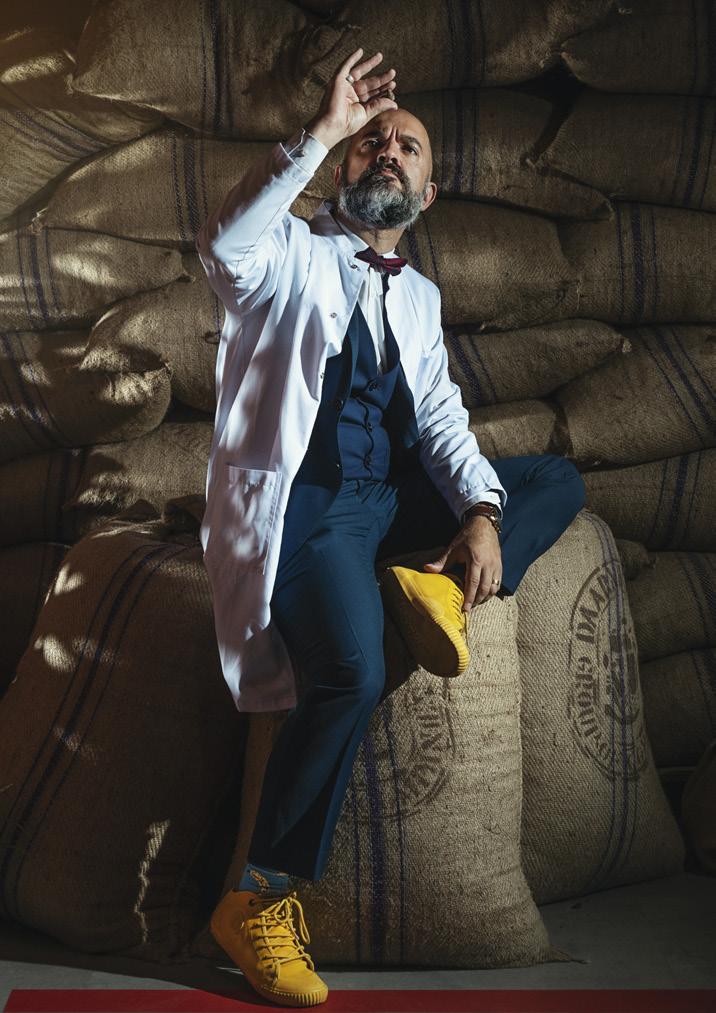
Is this the perfect port pairing?
Pedro Martins Araújo is master chocolate maker at Vinte Vinte. He's passionate about matching chocolate with port, and his latest creation is the Port Cup Pack, produced in association with Taylor's and available to independents via Mentzendorff
Sponsored feature
Find out more at mentzendorff.co.uk
Hi Pedro. Last time we were in touch we were discussing the Port & Chocolate Tasting Box. What has the reaction been to that, from trade and consumers?
The reaction has been great. Vinte Vinte and Taylor’s did not invent the pairing of chocolate and port wine, but they have definitely taken it to another level.
We are the only port wine house that also produces chocolate. The pairings we have made are some of the most classical pairings in port wine, but we have packed it and transformed it into more than a product: it is an experience in a box. I have done countless masterclasses and tastings, for consumers, traders, experts, etc, and I haven’t found one person that hasn’t enjoyed this product. It brings the fun to port wine.
Now we have the Port Cup Pack. Tell us how this idea came about.
This product came to fruition though multiple steps. At our chocolate museum – The Chocolate Experience by 20|20 –we decided to make little chocolate cups to offer our visitors with a sip of port wine. The whole idea was to make it uncomplicated, easy and fun.
We saw how much people loved the port cups, so we started bringing them to the UK to support our various port tastings and events. The response to these port cups was overwhelming – people couldn’t seem to get enough of them. From there we knew we had to turn the experience into something that people could enjoy outside of just our tastings and events.
The pack takes the pairing concept to yet another level. It’s easy and fun, and it’s an experience that everyone understands, enjoys and loves.
How did you arrive at the precise chocolate recipe to complement Taylor’s LBV?
We have been working and developing port wine and chocolate pairings for a few years. As you might imagine, a lot of experimentation and tasting has been done. But in this case the actual pairing already existed: the 58% dark chocolate
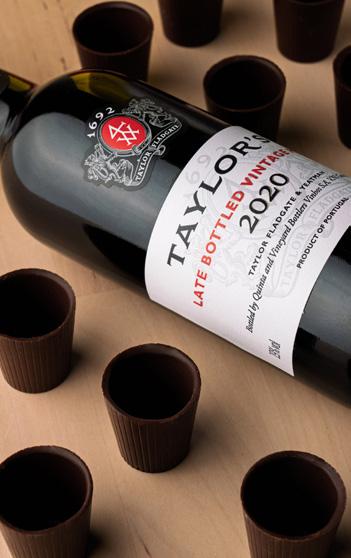
is already paired with Taylor’s LBV in the pairing box.
With the port wine and chocolate cup experience, what we have done is to change the format of the chocolate, to give a very different experience.
Did you get it right quite quickly or was there a lot of trial and error?
I wouldn’t call it trial and error … I would rather say that tasting port wine and chocolate is a hard life, but somebody has to do it. However, yes – it was quite a process to find this particular perfect pairing.
Do you have a particular customer in mind for this product? Obviously it will have wide appeal but in your mind were you thinking of a particular age group, demographic or consumer type?
Having already trialled the Port Cups at many consumer events over the last year such as the Waitrose Food & Drinks Festival, the Royal Windsor Horse Show and The Game Fair, we have seen that the Port Cups have a hugely wide appeal. In fact, Sophie, Duchess of Edinburgh was even photographed in the Daily Mail enjoying a Port Cup at this year’s Royal
Windsor Horse Show.
So we see the Port Cups as appealing to many different age groups, demographics and consumer types, but the key focus of the pack is strongly targeted towards helping to bring new and lapsed consumers into the port category, using social sharing moments and gifting opportunities as the vehicle in which to do so.
The packaging is quite striking, making it great for impulse sales and gifting. Again, was this something that the team had to work on for a while before it was exactly right?
Nothing striking is possible without hard work. We knew people’s reactions to the chocolate cups with the LBV – we only (and I emphasise the word only) had to develop a pack that highlighted the potential. In the end we kept it simple, showing the bottle and the cups, but once again, it was a process. We are very happy with the result.
The chocolate/port combination will be irresistible to many people. Do you worry they might consume each cup too quickly and perhaps binge on the entire pack without appreciating the nuances of the flavours?
I have mentioned time and time again that port wine and chocolate are a match made in heaven, and it brings me joy to realise that it is irresistible to many. Truth be told,
my only concern is making sure that people enjoy it.
How long before the chocolate starts to go past its best?
Our chocolate has a best-before date of 24 months, but this doesn’t mean that the chocolate goes off after 24 months. In fact, in the right conditions, one can store chocolate for a very, very long period –many years – and it will still be edible. What will change are the flavours. But our best-before date guarantees that the flavour profile remains unchanged. So merchants can hold onto the pack right to the end of the best-before date.
Port is seen as one of the most traditional and conservative categories in wine. Is this launch aiming to change those perceptions?
Yes, one of the objectives of the Port Cup Pack is to help challenge preconceptions about port. There are many consumers who have still not tried or do not understand port, how majestic it is or its versatility. For example, a lot of people still don’t know that white port even exists or that we encourage tawny port to be served chilled. The Port Cup Pack encourages trial; it’s a new, fun and different way to enjoy port. Nine out of 10 people say they love chocolate – and the other one is usually lying!


The Wine Merchant team was joined by Louise Oliver of Seven Cellars in Brighton to taste through a range of vermouths. Here are the 12 that impressed us the most
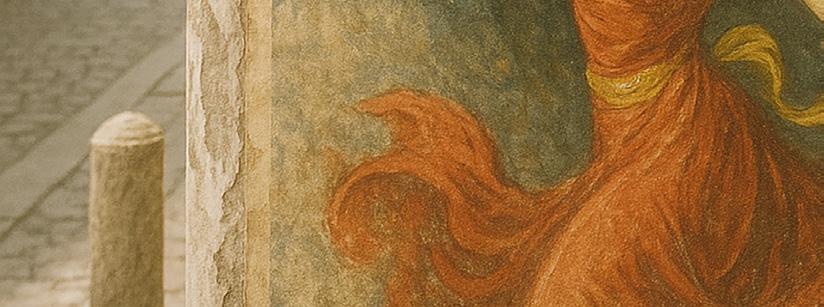
Fells, RRP £36
Packaged suavely with an image of a Cossack chief primed for battle, this feels like an event before it’s even open. A spine of Manzanilla is blended with 20 locally-sourced aromatics from Andalusia as well as reserve vermouth and quinine from the 1970s. It’s lavish and extravagant with treacle, salted caramel, orange peel, hazelnuts and cocoa nibs. Hedonistic in every sense.

Les Caves de Pyrene, RRP £52


Produced by Sicilian hero Giusto Occhipinti, who founded Azienda Agricola COS in 1980. This steals the hearts of the panel with its individuality, brimming as it is with turmeric, pithy orange and galia melon. There’s a phenolic grip that coats the palate with a fine, spicy powder. The packaging is unanimously popular with its unconventional typography. One for the toolkits of experimental mixologists.


Les Caves de Pyrene, RRP £41
Occhipinti’s red vermouth is made from organic Nero d’Avola, again fermented spontaneously on the skins. This is complex and intense, with cedar, mint, fresh herbs and smoky incense and an appealing dustiness. But it’s also bright, lively and youthful on the palate, with crunchy red plums and lemon peel. As much as this would elevate any negroni, it deserves its own stage. Serve with ice and pay attention.

Astrum Wine Cellars, RRP £23
Handmade at the Quaglia distillery in Turin, this is classic Italian vermouth and the packaging follows suit. It undergoes long aromatic infusion, inspired by traditional recipes and techniques. It’s markedly savoury with tomato leaf, chilli stalk, rose and capsicum leading the aromatic charge. There’s a dried fruit core with a long, pleasing bitterness on the finish. A worthy workhorse vermouth.

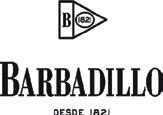
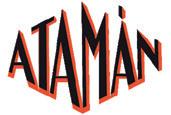

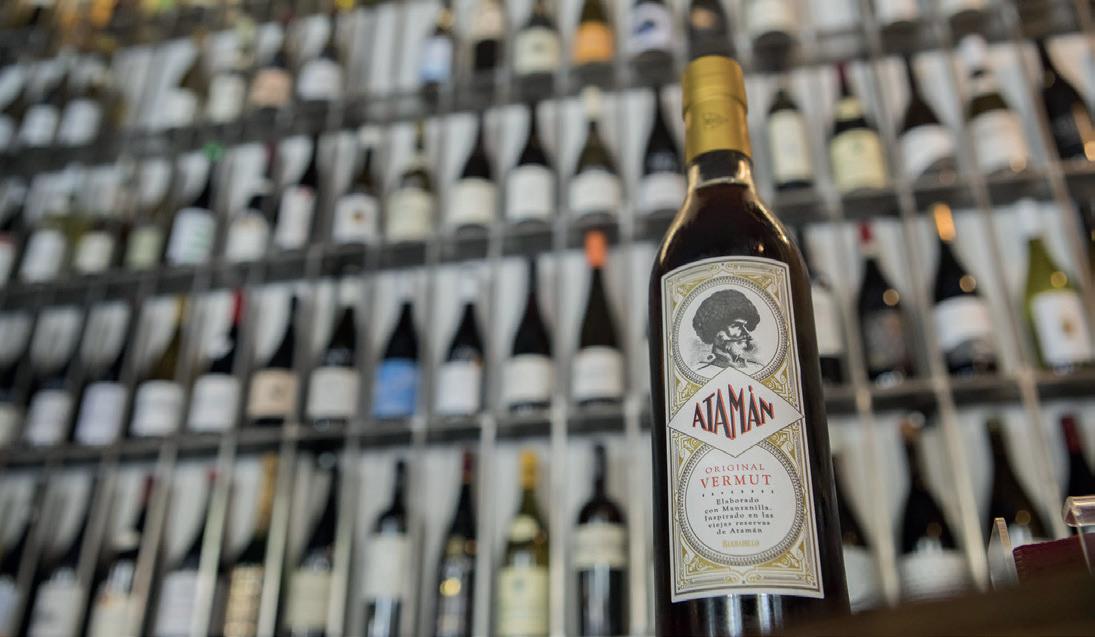
‘The spine-tingling, cymbal-crashing urgent and synapse-splitting intensity of this vermouth is almost impossible to describe. It’s waves and waves of revelation crashing on the rock and sand edges of your palate… the rustle of a thousand drumsticks and the march of a thousand silver cymbals.’
- Tamlyn Currin,
JancisRobinson.com
VISTA ALEGRE
40
RRP £110, 50cl
A blend of selected white wines aged in oak barrels for an average of 40 years, this exceptional white port is amber in colour with greenish hints. It offers an intense perfume of nougat, citrus peel, coffee and mint. Silky and fullbodied with a long, persistent finish, this is a standout fortified wine that impresses with its age and elegance, ideal for retailers looking to offer something truly rare and refined.

RRP £28, 75cl
Full ruby with violet nuances, this Reserve Ruby Port is rich and aromatic with a complex fruit-forward profile. It’s full-bodied and smooth with sweet tannins and a long finish. Presented in a striking decanter and gift box, it’s crafted from a blend of classic Douro grapes including Touriga Nacional, Touriga Franca and Tinta Roriz. A perfect gift option or shelf standout for retailers seeking fortified wines with visual and sensory appeal.
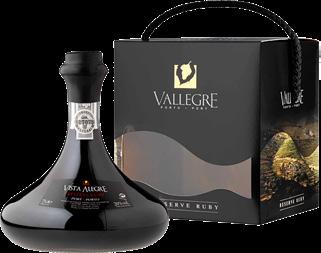
RRP £35, 75cl
A rare single vintage Tawny Port aged for at least eight years in oak casks to develop smooth tannins and soft spicy flavours. The 1996 vintage was chosen for its exceptional character, making this Colheita a wine of unique distinction. With depth, maturity and a story in every bottle, it’s a compelling choice for retailers looking to offer vintage fortified wines with provenance and personality.
All wines are available from Lanchester Wines. Please visit lanchesterwines.co.uk for more information.

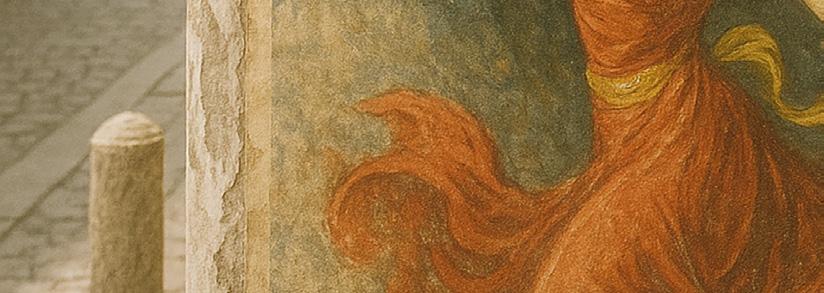
González Byass UK, RRP £20
The La Copa brand was registered by González Byass in 1884, and production still follows an original recipe dating from 1906. The rojo is produced from oloroso and PX soleras in which the wine is aged for more than eight years. Classically packaged, it’s alluring and decadent, with toasted almonds, sultanas, cinder toffee and clove. A warm, luscious hug that could do any dessert wine out of business.

Hatch Mansfield, RRP £24.90

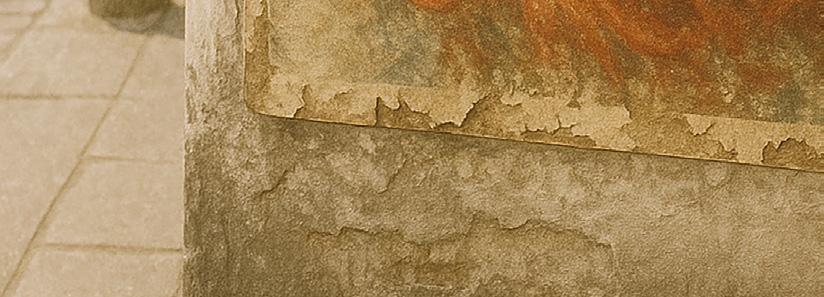
Argentinian wine giant Sebastián Zuccardi and three of his friends created La Fuerza with the simple aim of combining local botanicals from the Andes with the region’s two symbolic varieties: Malbec and Torrontes. The packaging is the trendiest in the full lineup, catching attention early on. It’s bracingly fresh and herbal with vetiver, bay leaf, rose stem and bitter lemon rind. Thirst quenching and full of high-altitude identity.


González Byass UK, RRP £20
This extra dry style would’ve been referred to as French vermouth back in 1896 when González Byass began producing it. The packaging is classy and traditional, very suggestive of the style. The fino does lots of heavy lifting here, providing strong floraged nerve. Think almonds, chamomile, sea salt, dried grass, lemon and marzipan. One for biological sherry enthusiasts.

Astrum Wine Cellars, RRP £23
The packaging divided the panel but the blanco from the Quaglia distillery in Turin offers the same spicy edge as its rosso twin with a heady, almost piquant lift on the nose. It’s grapey with hints of lemon sherbet, red apple and green chilli. Very distinctive with a sweet, approachable depth of fruit making it a safe but engaging bet for beginners.


Liberty Wines, RRP £22.99
This biodynamic Viognier-based vermouth is an absolute whirlwind of flavour, sitting just on the enthralling edge of being disjointed. Safe to say it divides the panel more than any other vermouth in our tasting, right down to its quirky 50cl medicine bottle packaging. On the palate, think cocoa, white chocolate, cane sugar, frangipane, citrus and blossom honey.

Hatch Mansfield, RRP £24.90


The rojo iteration of La Fuerza, the passion project of Sebastián Zuccardi and his close friends. It’s made with high-altitude fruit with a heart of more than 30 Andean herbs and Argentine botanicals. It has a glossy blueberry fruit core, and is dense and extracted without sacrificing freshness. There’s liquorice sweetness, fresh cedar spice and a moreish bitterness.


Les Caves de Pyrene, RRP £42
The panel didn’t particularly like the name, or indeed the packaging, so the liquid had some work to do. Luckily this vermouth’s Gamay heart is beating bright with crunchy red fruit, bubble gum, vibrant floral notes and a tart acidity. It feels very vinous for a vermouth with most of the aromatised elements taking a back seat. Definitely one for summer, over ice.

Les Caves de Pyrene, RRP £42
Again, in the context of the line-up, the branding falls flat. Made from 100% Gros Manseng, like its red counterpart it very much prioritises the varietal character of the base wine. It’s lean and citrus-driven with a clean spine of acid; flickers of curry leaf and sage come and go quietly. You could imagine this going town a treat with tonic and a slice of lemon. A quite individual style.



Let other merchants have fun with creative names. But I can do puns, too …
Skoda, IKEA and Hyundai are all companies which became very successful in the UK, and they allowed us to gleefully pronounce their brand names in a way that was pretty much akin to Roy Walker’s Catchphrase: say what you see.
Then at some point there came a Trojan Horse moment where they suddenly announced that we’d all being saying these names wrong all along. What’s worse is that this didn’t come with a little handy tutorial and a reassuring “don’t worry, we don’t mind” pat on the head. The changes seemed to happen overnight and made me feel ever so guilty for messing up the pronunciation in the first place, and a quick check on the internet shows that the defence of “I was only obeying orders” is no longer a vaild excuse, even for IKEA.
The same thing has been happening with place names. Bombay has gone walkabout and I get odd looks when ordering chicken kiev. Yet I am still free to pronounce the “s” in Paris; in fact, you’d come across as a pretentious prat if you didn’t.
Which brings me neatly on to wine. How should I pronounce wine names? With the accent of origin, or with my Yorkshire twang? I love to roll the “r” in Régnié and
We are quite simply Hoults Wine Merchants, which is something of the Ronseal approach to naming
embrace my inner French sophisticate –but I get the feeling that I would be in a spot of bother if I attempted an accent to pronounce the classic Indian sparkling wine, Omar Khayam.
I have yet to meet any French person who can correctly pronounce Hoult; they are always trying to drag the “u” into play. I had a teacher at infant school who took it upon themselves to pop an umlaut on my name on all of my schoolbooks in an effort to make it “proper”. They did change their mind once my mum pointed out the error of their ways in a style that only a chainsmoking mother of the 1970s could.
On the subject of shop names, we are quite simply Hoults Wine Merchants, which is something of the Ronseal approach to naming.
Originally it was just The Wine Shop, which seemed almost cutting-edge in 1987. These days wine merchants seem to be a little more creative with their names, with the likes of Vineking, Noah’s Goat and Cork of the North. I must confess at this point that I spent a good few years labouring under the illusion that Philglas & Swiggot were the last names of two wine lovers.
just have a pun: you also need to use letters that don’t belong there.
In Leeds there is a salon called Kurl Up & Dye. It’s a terrific name but only a hairdresser would think that it needed a kicking K instead of a curly one. What about Houltz Winez or Premier Kru?
My own favourite name for any business, though, is one that only exists in my head at the moment. I was having my barnet trimmed and my barber is a chap who spends as much time on a cruise ship as he does in his salon. He was saying how he’d actually quite like to be a travel agent. I suggested he combine the two.
Pop a load of those A4 adverts for holidays in the window and then you could discuss which trip suited you most as you get your hair styled. The name for it? Hair Today, Gone Tomorrow. I’m wasted in this job. Literally, sometimes.
While I have been typing this missive there has been a constant flow of people in orange hi-vis and hard hats going backwards and forwards past my shop window. The reason for this is that our shop is in a railway arch and it is in the path of the TransPennine Upgrade.
They have brought in the second largest crawler crane in Europe and closed Huddersfield station for five weeks to remove and replace a major bridge. To do this as quickly as possible they are literally working 24 hours a day and it’s been quite good fun to watch.
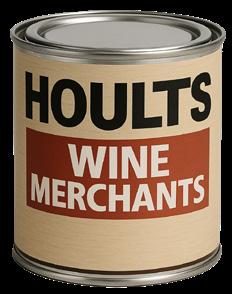
I do think that wine shops have still got some way to go until they reach peak naming territory, as that is currently occupied by hairdressers. We need to embrace our inner coiffeur, who lives in a world where it’s not simply good enough to
As this is all happening within a few yards of our front door there was an initial worry, and indeed conversations, that we’d end up having to close for a while. Thankfully, though, we are 20 feet from a Tesco, and they appear to be very good at ensuring that roads stay open when it might affect them. So despite all of the chaos and hi-vis we have seen little to no disruption to trade. As they say, every little helps.
Rob Hoult owns Hoults Wine Merchants in Huddersfield
By Matt Walls
Ihave a particularly serious case of nostalgia for Japan, where I spent several years. I was irritated by many aspects of life there, but the feeling of nostalgia is inescapable.
I feel the same way about the Rhône valley, although to a lesser extent. The memory of the summer warmth and of walks at twilight through the vineyards of Rasteau, or along the river in Arles, stays with me.
That, more or less, explains why I bought Rhône Valley: The Smart Traveller’s Wine Guide, by Matt Walls. I love reading, and I like drinking wines from the Rhône valley almost as much; mostly, though, I just wished to indulge in a bit of good oldfashioned nostalgia. I only had a vague notion of writing a book review.
The book commences with a brief section about the history of viticulture and winemaking in the region. I sometimes wonder why there’s always a chapter about the history of a country, a region or winemaking in books about travel and wine. Often I skip these pages –and I think I have a greater enthusiasm for history than most. Do readers really care about the history of viticulture in the Rhône valley? Perhaps.
about the local cuisine. He remarks that andouillette, “a large sausage”, is “an acquired taste”. Its detractors say it “smells like faeces”. This reminded me of the time I ordered it in a restaurant in Isle-sur-laSorgue, where the waitress seemed to want to persuade me not to have it. “You know what it is?” she asked. I did, and it wasn’t very pleasant.
“It’s not always obvious what to serve Condrieu (the most famous Viognier of all) with, as it’s so rich and aromatic,” writes Walls. I don’t think that's true. I had a bottle of Guigal’s Condrieu a few years ago and I thought immediately that, like other fullbodied, glycerol-rich and low-acidity whites from the Rhône, it would be an ideal partner for roast chicken. In fairness to the author, he does go on to say that poultry works with the grape. So, if you see a poulet rôti on the menu, look for a good Rhône white.
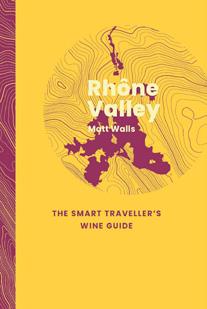
I always enjoy reading about grapes, and there are a lot of them in the Rhône valley. Not surprisingly, Walls provides a very informed description of the varieties in the region. One of the “heady aromas” of Viognier is jasmine, he observes. I think that’s true, but I’d say that jasmine is all too rarely detectable in a Viognier. A lot of wines made from the grape are mediocre and disappointing, in my opinion. However, when you do pick it up, the jasmine tea note is both unexpected and wonderful.
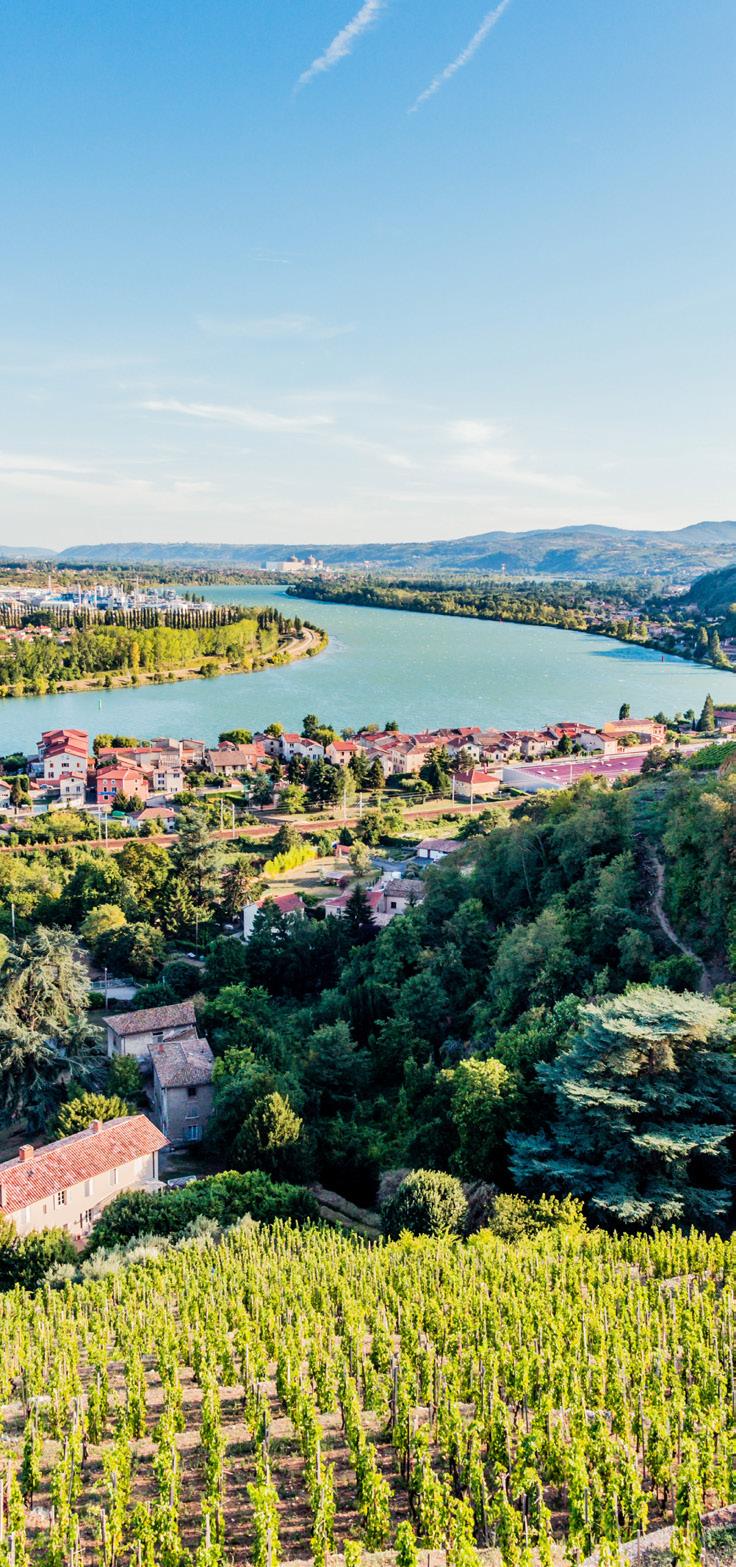


Selling Torres crisps has left me questioning my morals. Torres undermines the unspoken codes of UK crisp etiquette. Whether you believe Walker’s Cheese & Onion should be green or blue is a debate for another day. But one thing we can all agree on is that you wouldn’t ever be surprised to see Walker’s anywhere. From a building site to a cricket ground, a music festival to a wake, a children’s packed lunch to an office desk.
The same can’t be said for Señor Torres. His terms are ones of exclusivity. The potato snack of remote working and Birkenstock weddings. He hasn’t had the grounding of being between slices of bread or inside a two-for-one multipack. And his prices prove it.
“Have you ever met a wine lover who isn’t obsessed with food?” asks Walls in the introduction to the book. Yes, me. I wrote the following after my last visit to the Rhône valley:
I’m influenced by two factors when I order food: first, how hungry I am and, second, what I want to drink. Maybe the second takes precedence. My aim was to drink only local wine, and it had to be red. This suggested meat, which was in fact essential as I was utterly ravenous every time I sat down for dinner.
Walls has some interesting things to say
There is of course a lot of information directed towards tourists in the book. As someone who has travelled a lot, I can say that Walls’ observation that taxis in the Rhône valley “are inexplicably, eyewateringly expensive” could apply to just about any country.
As I say, I have a bad case of nostalgia for the Rhône valley. I suppose the litmus test, therefore, is whether the book makes me want to return. Among the many excellent pictures of the region is one of the Pont du Gard, an ancient Roman aqueduct over a river. As Walls points out, “you can even go for a swim in the river on a hot day”. I did that once – and when I read those words, I wanted to do so again.
Michael Walker
For a wine merchant, premiumisation is power. And as people break into a tenner for a packet of crisps, they must also be more likely to spend generously on wine. And up until now, this was my reason for giving Torres a stage on which to impose his many obnoxious faces.
When I hear children expressing a preference for caviar over foie gras to their parents, I feel ashamed to have played a part in this development. I fear that what started as a harmless experiment has now gone too far, with Torres now sitting smugly on supermarket shelves alongside the heroes of our past. Are we on a dangerous path of divide and conquer? A world in which we are no longer united by the common approachability of the crisp? Or am I guilty of making something out of nothing?
The only thing I’m certain of is that I’m definitely making something out of Torres crisps.

My current relationship with Burgundy can best be described as a once starry-eyed affair, now on the most frayed of ropes.
Like many, it was my first true love in wine. In the early days, I was taken by the mystique of the golden slope before I’d even had a real sip of it. Burgundy was my equivalent of a high-school crush with whom I’d not exchanged as much as proper eye contact, never mind a word.
Granted, as a newcomer, everything in the wine world seems mysterious. But there was something about Burgundy that felt particularly elusive. Misunderstood by many, but cherished by those who knew. So obviously I wanted to know.
And in a nerve-wracking first date, I asked Burgundy out for dinner: Christmas dinner, to be precise. I remember it distinctly: Louis Jadot Clos des Ursules 1er Cru. It was by far and away the most expensive bottle of wine I’d bought at that stage. And it took its seat at the dinner table with my family, who found it absurd to drink a wine like that. They’ve since got very accustomed to it. Funny that.
And honestly, in that particular moment I didn’t understand the wine at all. Don’t get me wrong, I liked it, and tried to convince
It’s brilliant, but this is still ersatz Burgundy in the grand scheme, and there’s precious little change out of £100

May I have this dance?
myself I loved it, but the truth was I didn’t. I should’ve known better: a slick French romantic pitching to a table of half-cut Yorkshire folk wasn’t a promising match.
But as with any ill-fated relationship, I ignored the signs, put it down to the occasion, and carried on. For the next few years, I took Burgundy on date after date, we shared kiss after kiss and inevitably exchanged lie after lie. Moments of promise convinced me it was a relationship worth saving, but earlier this year it all reached boiling point. And in the midst of a simply unacceptable Santenay, I called it a day.
Thankfully, with the suspiciously familysuitable home not bought and the HumberBurgundian children not out for delivery, it was a clean break.
But, as they say, the first heartbreak hurts the most. Within weeks I found myself seeking its attention at tastings. Keeping sight of its face felt essential. It gave me comfort.
So recently, after nearly eight months
of tentative separation, a proposition of rehabilitation arose when a friend of mine suggested we buy a bottle of 2016 Domaine Grivot Vosne Romanée that he’d found at a good price. I hesitantly agreed. And this week we opened it.
Picture the start of a waltz, me on one side of the ballroom, Grivot on the other. We stride towards each other; eyes locked as much in haste as anticipation. Our hands meet, clenching together with promise. An anxious intent fills a brief moment of silence. Then, we begin to dance.
Grivot has come dressed in a satin tail suit and he’s dancing like a man who can back it up. Gliding effortlessly with a stylish balance of energy and nonchalance, there’s a rise and fall of pure, crunchy red fruits, a fluttering of scorched flowers and a subtle tilledearth seriousness on a face of absolute composure. It’s classic Côtes de Nuits. It’s utter silk.
I savour every moment. And yet when the music stops, the heart rate drops, and as the last sip is sunk and a bottle of Dolcetto is opened for rehydration, the demons return. I’m feeling short-changed despite everything. Because despite its brilliance, this is still ersatz Burgundy in the grand scheme. And there’s precious little change out of £100. It’s demoralising. And the more I speak to both consumers and professionals alike, I sense the frustration is shared.
We are so lucky in the UK in the sense that we can have anything we want. We have the most diverse product range of any market on the planet. And it’s not just the abundance of world-class Pinot Noir and Chardonnay from across the globe at half the price that undermines Burgundy. It’s also the number of emerging styles that are very much occupying Pinot’s realm. Grenache, Cinsault and Nerello Mascalese to name just a few.
For the most notable expressions, Burgundy has mutated into an exclusive game played only by those with the deepest pockets. And that alone leaves a very sour taste on the end of what is probably an underwhelming finish.
In 2025, it’s easy to understand how many desperate imitations of sustainability have begun falling on deaf ears. But when Journey’s End says that sustainability is at the heart of everything it does, it’s not just a box-ticking exercise or a savvy marketing plan. It’s the truth.
As the first and only B Corp certified winery in South Africa, Journey’s End runs a number of initiatives, both on and off the estate, to pave a path for a sustainable future. All made possible by achieving aim number one: the production of quality wine.
And that starts with terroir. Tucked in the Schapenberg hills, 350-million-yearold granite soils are the lifeblood of the estate’s 40ha under vine. In this cooler part of Stellenbosch, False Bay provides Atlantic moderation, making this area a standout pocket for freshness and elegance.
But the droughts and energy blackouts of recent years have taught producers that, no matter the quality of terroir, wine can’t be made in the absence of natural resources. So, Journey’s End saw both water and energy independence as non-negotiable. Through the harnessing of solar power, harvesting of rainwater and recycling of wastewater, the estate now oversees every aspect of production self-sufficiently.
There’s a vitality of nature on the Journey’s End estate, partly through the preservation of indigenous flora and fauna. And there’s a local hero at the heart of it: spekboom. This South African plant sequesters carbon more efficiently than a
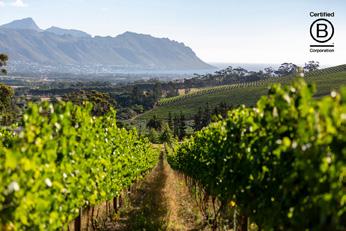
V3 Cabernet Franc RRP £18.50
This is proof again that South African Cab Franc is some of the world’s best. Refined, suave and distinct with a beautiful new world plushness. There’s fynbos and sencha, red cherries and green pepper, strawberries and cedar sap. Excellent.
Fresh and elegant Stellenbosch wines are just part of the Journey’s End story. The producer sets the standard when it comes to pioneering sustainability and community impact
Sponsored feature Wines are imported by Walker & Wodehouse
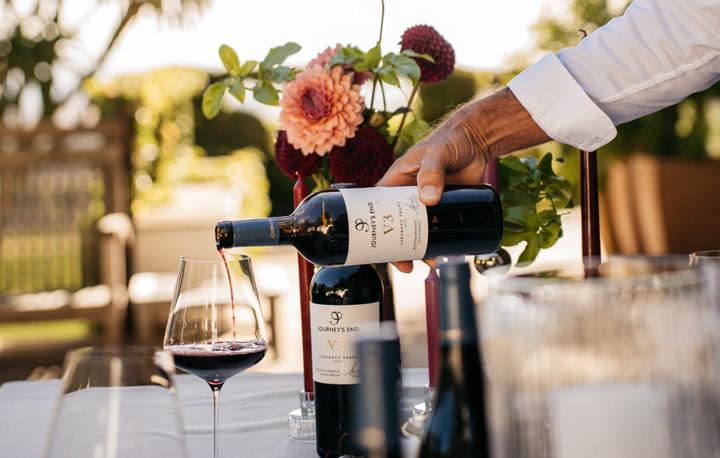
tropical rain forest, whilst also improving soil health through water and nutrient retention. There are now over 10,500 plantings of spekboom across the estate’s 22ha dedicated to conservation.
Importantly, these and many other sustainability initiatives allow Journey’s End to ensure a bright future for itself and its workforce. But perhaps even more profoundly, Journey’s End is able to extend its force for good into the local community of Sir Lowry’s Pass.
Here lives an entire neighbourhood beyond the reaches of reliable government support, and thus without a safety net. Some might find it tempting to concede a situation like this as too big to tackle.
V4 Cabernet Sauvignon RRP £18.50
A core of rich blackcurrants and black plum, with a savoury overlay and mixed spice. The velvety character is a result of generous oak maturation resulting in finely textured tannins and a long-lasting finish. Complex and layered; the palate of the wine evolves as it breathes in your glass.
But for Journey’s End, a commitment to sustainability is one that transcends the boundaries of its own four walls. Through various initiatives across Sir Lowry’s Pass, Journey’s End is directly impacting lives across the village. Firstly, through education, in the form of a school dedicated to safeguarding and developing young adults who can’t access the state system. But perhaps most critically through nutrition. In the wake of Covid, when many in the village saw their livelihoods erased overnight, Journey’s End began funding a food kitchen. And today, with the heroic stewardship of village resident Joyce and her team of volunteers, the kitchen has now provided over 7 million meals to local families.
Cape Doctor RRP £26
A Stellenbosch Bordeaux blend with cassis and rich fruitcake on the nose accompanied by cinnamon spice and dark chocolate from generous oak ageing. Concentrated dark berries are complemented by a creamy texture with soft elegant tannins, delivering a beautiful, long-lasting finish.
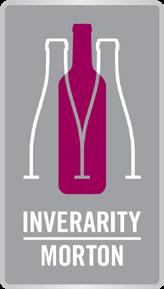

As regional sales manager for England and Wales at Inverarity Morton, I spend a lot of time talking with independents about what really works on their shelves. A good whisky range isn’t just about ticking off regions, it’s about balance, storytelling and giving customers a reason to buy again and again.
That’s why I’ve put together this lineup. It covers Scotland’s key whiskyproducing regions, brings together household names and rising stars, and offers plenty of flavour and provenance to spark conversations.
Together, these drams give independents a rounded whisky range with stories that sell. They highlight Scotland’s breadth and depth, while offering bottles that feel special in the glass and on the shelf.
They’re not just whiskies we stock –they’re whiskies we believe in.

(RRP £54)
Talking point: Sustainability meets storytelling
Ardnamurchan Distillery is on Scotland’s rugged west coast in the Highlands and is known for its sustainable approach and distinctive balance of peated and unpeated spirit.
The Midgie was crafted to honour Scotland’s most infamous creature, the Highland Midge. The 2025 release combines 75% unpeated and 25% peated whisky matured in 50% bourbon, 48% port and 2% sherry casks delivering a smoky fruit, red berries and a salty-savoury edge. Why we love it: It brings diversity and adventure to a range, giving the Highlands at their most characterful.
£50)
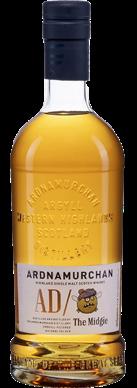
Farm-to-glass authenticity
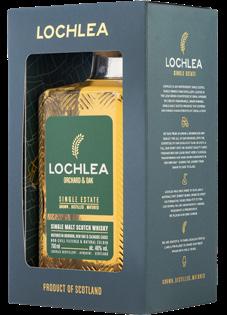
Lochlea is an independent family-owned Lowlands distillery in Ayrshire which was established in 2018 on the farm where Robert Burns once lived. They are one of the few distilleries who grow their own barley and mature all their whisky on site.
Lochlea Orchard & Oak is a newly launched core expression matured in 60% bourbon, 30% calvados and 10% virgin American oak casks delivering sweet apple notes, buttery caramel and delicate grass, all rounded off with their signature cereal finish. Why we love it: It’s provenance-driven and approachable – a whisky with authenticity customers love.
Glengyle Distillery in Campbeltown, revived in 2004 after closing in 1925, is operated by J&A Mitchell’s Springbank Distillers and produces whisky under the Kilkerran name.
Kilkerran 12, matured in 70% bourbon and 30% sherry casks, is the flagship expression known for balancing malty sweetness, citrus fruit and gentle coastal smoke. Why we love it: It keeps Campbeltown on the map, offering a classic style at a fair price.

Easy hand-sell: Recognisable and rewarding
Founded in 2017 as the first legal distillery on the island, Isle of Raasay embraces innovation with a focus on terroir, peat influence and diverse cask maturation.
Their flagship single malt, The Draam, combines peated and unpeated spirit matured across six cask types, first-fill rye, Chinkapin oak and Bordeaux red wine for each spirit style, creating layers of smoke, ripe berries, sweet spice and coastal freshness.
Why we love it: It’s a forward-thinking island malt that captures the imagination of adventurous drinkers.
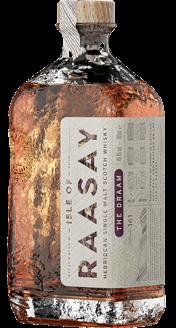
About Inverarity Morton
Inverarity Morton has been at the heart of Scotland’s drinks trade for 80 years. As the country’s leading independent wine and spirits wholesaler, we are proud to work with independent retailers across the UK, helping them bring distinctive, quality products to their customers.
Our portfolio spans global brands and local heroes, but our focus has always been the same: to give our customers the tools they need to stand out. From exclusive bottlings and award-winning whiskies to training and support, we’re here to make life easier for independents.
For stockist enquiries or to discuss your whisky range, contact the team at Inverarity Morton.
Angus Bennett
Regional sales manager, England and Wales
Email: a.bennett@inveraritymorton. com
Stephanie Bratby (pictured)
Key account manager, north England and Wales
Email: s.bratby@inveraritymorton.com
Inverarity Morton
sales@inveraritymorton.com 0141 620 6100 inveraritymorton.com

Revived in 2001 on the shores of Loch Indaal, Bruichladdich is renowned for its experimental approach and transparency, producing everything from unpeated malts to the world’s heaviest-peated whiskies as part of its Octomore range. Octomore 16.2 has been peated to 101.4 ppm and is matured in oloroso and Bordeaux wine casks before a final year in Madeira and Moscatel casks, bottled at 58.1% abv with a fusion of smoke, fruit and rich oak.

Why we love it: It’s a prestige bottle, perfect for enthusiasts and collectors who want something iconic.


Tucked into the Ben Rinnes foothills, GlenAllachie has flourished under Billy Walker’s leadership since 2017, becoming known for its sherry-rich, cask-driven whiskies. GlenAllachie 12 is matured in a mix of PX and oloroso sherry plus virgin oak casks, and delivers honeyed malt, dark fruit and warming spice.
Why we love it: It’s versatile and recognisable – a Speyside classic that works for newcomers and connoisseurs alike.
(RRP £51)
Award winner: Best Scotch Blended Limited Release 2025
Based in Edinburgh, Woven is an experimental blending house that sources whiskies from across the world to create small-batch blends built around flavour and storytelling.
Our Inverarity Morton Exclusive blend won Best Scotch Blended Limited Release at the Global World Whiskies Awards 2025. It combines malt and grain whiskies from Glenglassaugh, Strathclyde, Glenrothes, Loch Lomond, Invergordon and Glentauchers, delivering honey, vanilla, pineapple, soft oak and a refreshingly fruity finish. Why we love it: It’s exclusive to IM, giving independents something unique to share with their customers.
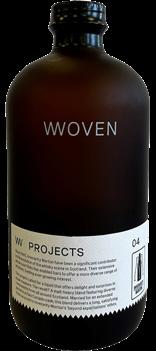
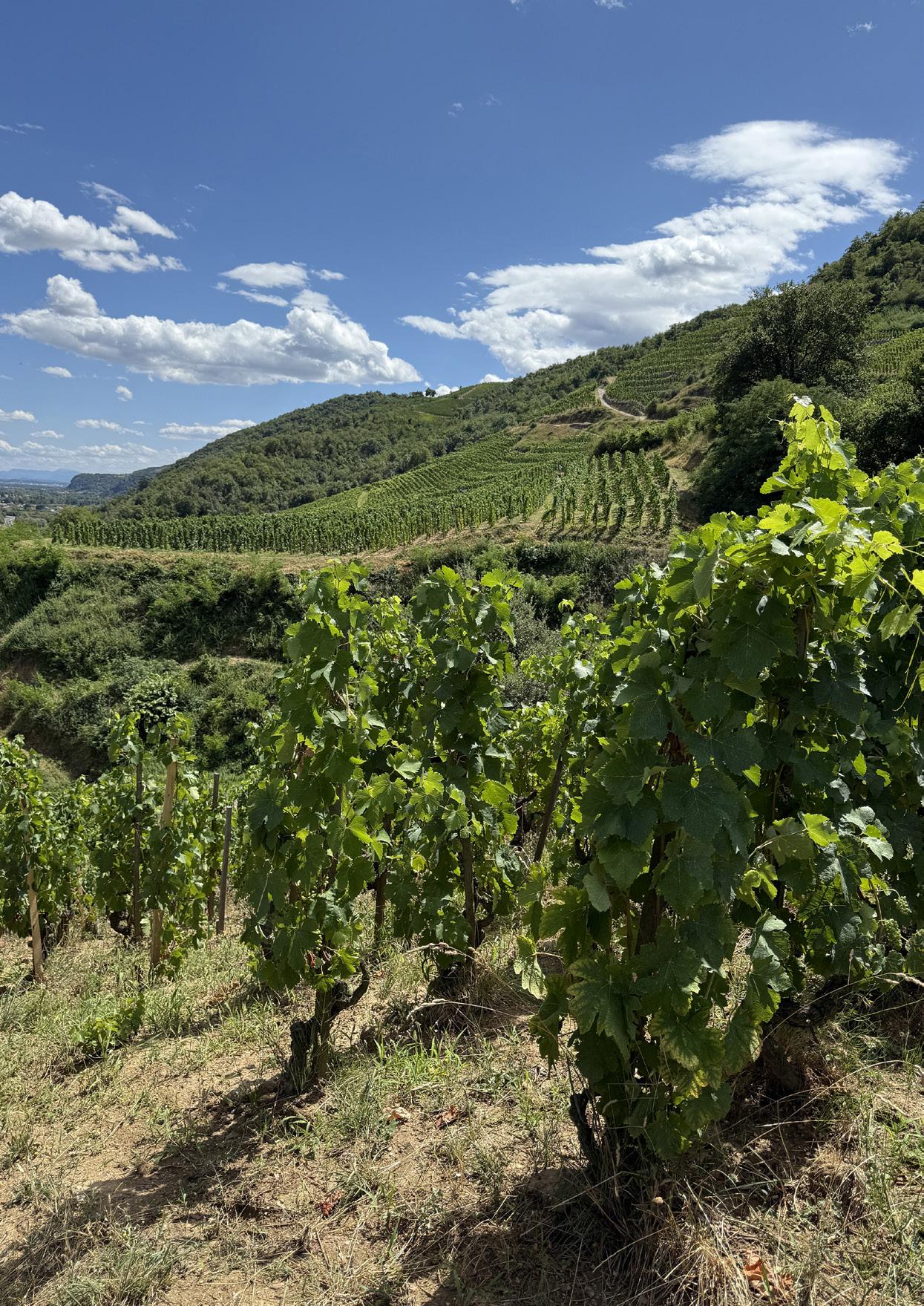
Ferraton Père & Fils works with the Rhône valley’s most celebrated appellations. But its real focus is on lieux-dits and micro terroirs, which it believes add an extra dimension to its wines
You can memorise the northern Rhône’s appellations, north to south, by studying a textbook, and at some point most of us do exactly that. But there’s nothing like climbing up these storied, sun-baked slopes and getting a 360-degree perspective, in real life.
Ferraton Père & Fils is an ideal travelling companion for such an adventure. In addition to what it produces from the southern part of the valley, it has some 35 cuvées in the north. Côte-Rôtie, Condrieu, Saint-Joseph … the roll-call of famous names continues all the way down to Cornas.
The Ferraton story starts in CrozesHermitage in 1946, when the business was founded by Jean Orëns Ferraton. He was succeeded by his son Michel, who took things a stage further, snapping up prime vineyard sites, expanding the winery and developing exports.
Then, in the 90s, the third generation took control in the form of Samuel Ferraton, the first in his family to formally study winemaking. Biodynamic viticulture was embraced and a négoce element was added to the business.
It was the cruellest luck when Samuel was badly injured in a motorcycle accident and his pioneering tenure in the family firm was cut short.
Yet the story continued, thanks to the family’s friendship with its neighbour Chapoutier. Ferraton was welcomed into the Chapoutier group, but retained its independence and identity. “From the very start we’ve always had our own oenologist and vineyard team – our own sales team as well,” explains brand ambassador JeanChristophe Sapet, introducing the modernday Ferraton.
“So we are part of the Chapoutier group, but we are also competitors. We share logistics and the bottling is done by Chapoutier. But the winery is our business.”
Ferraton approaches its winemaking in what might be called a Burgundian style, striving not just to make wines
that reflect their appellation, but which drill down further. The house’s focus on lieux-dits – specific, demarcated areas within larger vineyards – is something that the team believes sets it apart from other northern Rhône producers.
“We are really trying to put forward the terroir,” says Sapet. “That’s why we work so hard on the lieux-dits, because we want the terroir to speak for itself. Just like in Burgundy, you can be working with the same grape, in a vineyard with the same exposure, and create a completely different wine.” It’s a gamble, in a way: as Sapet explains, Ferraton’s lieu-dit wines must be excellent every year. But the quality of the terroir means the gamble invariably pays off.
We drive to the lieu-dit of Paradis in Saint-Joseph, on the left bank of the river, above the village of Mauves. Ferraton has a 1.5ha holding here and the vines – depending on the variety – could be planted on loess, granite or a claylimestone mix. At another Saint-Joseph site, Les Oliviers, the conditions are pebbly at the bottom of the slope, while granite dominates the higher ground. There’s a natural spring nearby, meaning the vines don’t suffer from hydric stress, and the white varieties have a pronounced freshness. Such are the details upon which Ferraton fixates.
“We work so hard on the lieux-dits because we want the terroir to speak for itself”
We meet winemaker Damien Brisset on our second morning at Ferraton. He greets us in the winery, where a table has been set out for us beside the neat rows of concrete vats. He’s been in the role for 20 years and his style is to understand each plot in minute detail, intervening as little as possible with the juice and fermenting and ageing it
separately (which explains the disparity in the sizes of the vats).
He reiterates the aim for purity and terroir expression, and the independence he has from Chapoutier. Surely, we suggest, he must have some sort of relationship with his counterpart there? The question is translated and a smile plays of the ex-Cheval Blanc man’s lips. Yes, he says, there is regular contact. The relationship is cordial and professional and there is a friendly rivalry. “Like Lennon and McCartney,” he adds, in English.
We embark on a tasting of 15 en primeurs from 2024, an experience that could only be possible with a tiny number of northern Rhône producers. It was a “rainy and laborious vintage”, Ferraton’s own marketing materials concede, requiring double the usual amount of biodynamic treatments in the vineyards. But, says Brisset, the results were “exceptional”, and he’s keen to give credit to the 25-strong vineyard team for their forward thinking and adaptability as nature played its tricks.


Hermitage Les Miaux red
Elegant and floral. The tannins are already fine but will become silkier; the aromas more precise.
Hermitage Les Miaux white
100% Marsanne with peach and apricot notes; we also detect apple pastry and bergamot.
Crozes-Ermitage Lieu-dit Le Grand Courtil red
From the first plot planted by Ferraton in 1971. Very ripe fruit with black olive and truffle notes.
Côte-Rôtie Lieu-dit Montmain red
There’s a fresh and floral character here, and what the group agrees are “minty tannins”. Airy and light.
Cornas Lieu-dit Patou red
This “marriage of granite and Syrah” wows the group with its dark fruit, spice and graphite notes and keen acidity.
Cornas Lieu-dit Les Eygats red
The vines are at 350m elevation and are the last that Ferraton harvests. A fresh, linear and less earthy style of Cornas.
Saint-Joseph Lieu-dit Bonneveau red
A windy, mountaintop location creates a tight, fresh and herbal wine, with fruit gradually revealed as it opens up.
Saint-Joseph Lieu-dit Les Oliviers red
One of the appellation’s great lieux-dits: a concentrated wine with dark fruits and spice, and tannins that will round off over time.
Saint-Joseph Lieu-dit Saint-Joseph red
The cradle of the appellation, with the most prized granite terroir, produces a powerful but balanced and silky expression.
Ermitage Lieu-dit Les Dionnières red 80% is Serine, a small-berried clonal ancestor of Syrah. Ripe, pure fruit with a mineral grip on the finish.
Ermitage Lieu-dit Le Méal red
For Damien Brisset, this is “the king”. Fullbodied and powerful, with a huge complexity of aromas and a long finish.
Crozes-Ermitage Lieu-dit Le Grand Courtil white
A vivid and powerful Roussanne/Marsanne blend, with apricot and passion fruit notes and a suggestion of fennel.
Crozes-Ermitage Lieu-dit Les Pends white 100% Marsanne from loess and gravel at 160m altitude. Citrus and herbaceous with some salinity on the finish.
Saint-Joseph Lieu-dit Les Oliviers white 70% Roussanne and 30% Marsanne. Well balanced blend of tropical fruit and freshness, with a long drinking window.
Ermitage Le Reverdy white
50-50 Roussanne and Marsanne: one of the best wines of 2024, according to Brisset, with outstanding balance.
Phil Innes
Loki Wines
Birmingham
I thought the Saint-Joseph Lieu-dit SaintJoseph 2024 was incredible. You expect Hermitage wines to be good – but SaintJoseph wines are slightly less expensive and don’t have the same sort of reputation. It actually proves that those singlevineyard sites really offer something very different. There is varied terroir, from the decomposed granite to the sand to the clay.
The winemaking style is modern: less oak-heavy and really focusing on fruit purity, which is definitely on trend at the moment, and something that I really enjoyed in the wines.
The Cornas wines I thought were completely different to the old rustic style. Pure, lovely fruit, and still bold, but not over the top.
The Côte-Rôtie Lieu-dit Montmain 2024 impressed me as well; incredibly fine and perfumed. I thought it was charming and beautiful and refined – exactly how I like Côte-Rôtie.

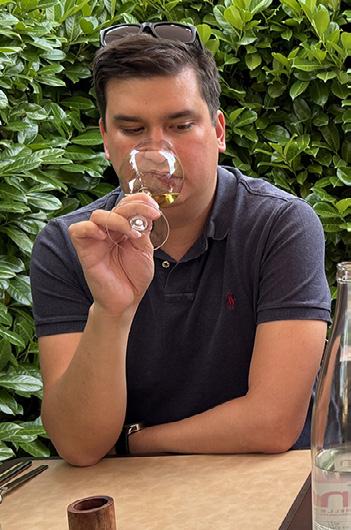
Rebecca

I absolutely loved their whites. I love Marsanne and, especially when it was over 50% of the blend, I thought the wines were often stunning. We tried Hermitage Les Miaux 2016 at dinner and I thought it was just beautiful. They’re wonderful young, when they’ve got that sort of texture; there’s a richness and generosity on the palate. I always get that sheep’s wool, lanolin note from Marsanne, which I don’t really get from anything else.
Among the reds I particularly enjoyed the Ermitage Lieu-dit Les Dionnières 2024, which is 80% Serine, a clone of Syrah. The reds have that lovely distinctive freshness, with a floral, violet note. Despite being big wines and quite weighty a lot of the time, they also had sort of a delicate quality.
Notting Hill, London

What really surprised me is that that Ferraton is owned by Chapoutier, but still has full independence. Chapoutier gives them space to do their own thing, even if that means a bit of internal competition. I found that super-impressive.
What I loved most is how Ferraton lets the terroir speak. Their signature wines aren’t about marvellous winemaking, but about the vineyard itself, with no ego – just respect for the land.
I always thought this area was all about Syrah, but it turns out there is a strong presence of Roussanne and Marsanne and that the whites are seriously good.
Hermitage really surprised me: it’s tiny and exclusive and the appellation doesn’t allow any expansion, so what’s planted is all there ever will be. That makes it feel even more special to walk through those vineyards.
Authentique
London


The wine that particularly impressed me is Hermitage Les Miaux Blanc 2016. It’s lively, with a lot of primary fruit; balanced, and full of energy.
The big revelation was Cornas Les Grands Mûriers 2023, because I’ve always thought of Cornas as rustic, but this one changed everything. It was elegant, polished, and completely redefined the appellation for me.
For me, the Saint-Josephs that were closer to the heart of the appellation – Les Oliviers and the Lieu-dit Saint-Joseph – really stood out. You could sense the sun exposure; the minerality, the concentration.
But a quite common denominator in all the wines is they all have this kind of silky mid palate, even though some of them have quite big structure. Even the en primeur wines I think are all really drinkable, which is great for northern Rhône reds, which can sometimes be a bit rustic. It’s a style of wine that still allows the terroir to express itself.

The winemaker [Damien Brisset] is very down to earth. He seems to be a really hard worker, very considerate of his team. He was highlighting that for him the most important thing is that all of his workers understand exactly what they are going to do, every single day.
The white wines on the northern Rhône are always going to be low acidity. What you’re looking for is bitterness, minerality, balance, but you’re always going to have richer, oilier whites. And that’s why they’re usually most suitable for fine dining or gastronomic experiences.
The older Hermitage white we had for dinner [Les Miaux 2016] was super, showing perfect drinkability and ageing potential. It was probably an even better match to the food we were having, even to the meats, than the Crozes-Ermitage [Le Grand Courtil 2019] from the magnum.

Join Beverley Blanning MW and Rebecca Gibb MW for this specialist event.
Blanning is author of The Wines of the Loire Valley and Gibb the Loire specialist for the American publisher Vinous Media. Details of masterclasses will follow. Contact claire@island-media.co.uk.
Tuesday, November 4
Conway Hall
25 Red Lion Street
London WC1R 4RL
This “Gewürztraminer journey from the heart of Alto Adige” will focus on the latest vintage of Epokale Gewürztraminer Spätlese.
It will also include selected vintages of Nussbaumer Gewürztraminer and a lineup of other Cantina Tramin wines. Email press@studiocru.com.
Wednesday, November 5
67 Pall Mall
London SW1Y 5ES
More than 100 members will present their 2023 vintage.
Created in 1973, this group of 132 châteaux-based producers represents Gironde (including the Médoc), Graves, Pessac-Léognan, Sauternes, Barsac, SaintEmilion and Pomerol.
Places are strictly by invitation only. Email celine@otaria.co.uk.
Wednesday, November 5
RHS Lindley Hall
80 Vincent Square
London SW1P 2PB
Find out what’s new in the region with the Valpolicella Consorzio at this walkaround tasting attended by many top producers.
Masterclasses will be hosted by Patrick Schmitt MW and Peter McCombie MW. Contact andrea.rinaldi@ uksommelierassociation.com.
Monday, November 10
The Honourable Society of the Middle Temple
The Treasury Office, Ashley Building Middle Temple Lane London EC4Y 9BT
Highlighting the 2021 vintage of Grands Crus Classés from the Médoc, PessacLéognan, Saint-Emilion and the top Pomerol estates, including first growths and their right bank equivalents. Contact beaton@mastersofwine.org.
Tuesday, November 11
Vintners’ Hall
68 Upper Thames Street
London EC4V 3BG
This tasting will take place from 12pm to 5.30pm with a briefing from Tim Atkin MW and Pablo Baquera from the
Consejo Regulador de Ribera del Duero at 3pm. Registration via eventbrite.
Thursday, November 13
10-11 Carlton House Terrace
London SW1Y 5AH
A self-pour tasting bringing together all New Zealand’s latest releases including wines from the 2025 vintage. All wines being presented are produced in accordance with recognised sustainability programmes and will be laid out by varietal, vintage, region and price. Contact sarahs@nzwine.com.
Tuesday, November 18
St James’s Room
67 Pall Mall
London SW1Y 5ES
For more information and to register, contact louise@phillips-hill.co.uk.
Wednesday, November 19
67 Pall Mall
London SW1Y 5ES
Featuring six producers, a cocktail stand, a food and wine pairing stand and three masterclasses.
For more information and to register, contact info@westburycom.co.uk.
Thursday, November 27
St Mary’s Church
Wyndham Place, York Street
London W1H 1PQ
In the final part of our exclusive Wine Merchant mini-series, Sunny Hodge, author of The Cynic’s Guide to Wine, extrapolates another topic from a chapter of his book.
The book lays out the scientific connections in wine, from soil to fruit to glass, and onwards to our own sensory perception. It references the latest in soil science, viticulture, microbiology and neuroscience to present wine professionals and experts, ensuring what we say about wine is technically and scientifically correct.
I can almost guarantee that those of you wine professionals reading this have at one point in time (if not daily) been asked by a customer if you smell the thing they’re smelling in a wine.
“I smell grapefruit, do you get that?” or “ooh, there’s lots of black pepper, is that correct?” I mean we’re the experts, right? But does that necessarily mean that we’re equipped to tell our customers what they are or should be smelling?
From a scientific viewpoint, the freefloating aroma compounds that emerge from a glass of wine can be measured and documented by olfactometers or mass spectrometers. We can then take these readings and present a clear idea of what aroma compounds exist, and what they should most likely be perceived to smell like.
There are thousands of aromatic compounds which emerge from a glass of wine and, depending on how certain aromatics combine in a mixture, they’ll then go on to smell like entirely different things. Even with lab equipment it’s difficult to understand how a person might perceive certain matrices of aroma compounds as there are so many combinations of aromatics that are at play,
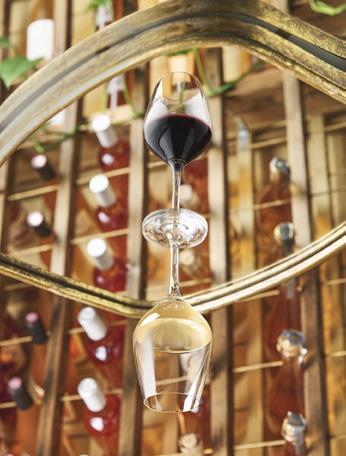
and in differing concentrations.
And now to the humble shop assistant who is being asked what a wine smells like. It’s a minefield. To further add to the complexities, people all have different odour thresholds to specific aromatic compounds, meaning that all individuals vary in their sensitivity to detecting isolated aromas – and in many cases some of us lack the ability to smell aroma compounds entirely. The term for this is anosmia.
Sesquiterpene Rotundone is the compound famed for its contribution to the smell of black pepper, yet 25% of the general population cannot detect it. This means that when we all sit around a bottle
of Châteauneuf-du-Pape and enjoy the wonderful aromas it gives off, a quarter of us simply won’t pick up the black pepper notes. And all of us will be picking up the random aromas we’re more sensitive to than others.
So far, we have just discussed the aroma measurement tools we’re biologically equipped with. Let’s take this one step further to how we articulate this information into language. Our Wernicke’s and Broca’s part of the brain is responsible for language processing. It’s also incredibly far away from our olfactory bulb which does all of the smelling calculations. This directly reduces our information processing capacity, which put simply means that we’re naturally not so good at it. Inversely our amygdala – which processes emotions and memory surround the olfactory bulb – are directly connected. This explains why we have all struggled to formulate a sentence around describing wine aroma yet never fail to link a smell to a memory.
Our sensory systems are flawed yet wonderfully diverse – and I’d say subjective in the purest sense of the word.
Follow @sunnyhodgewine on Instagram for more handy wine science facts.

The Cynic’s Guide to Wine is available online at Waterstones, Amazon, Academie du Vin Library and all good book retailers.

Telephone: 07956 377705
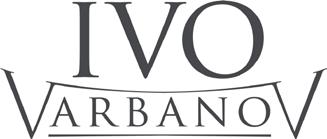
Three regions, three visionaries, three icons that shaped the identity of their
1. Clos Figueras – Clos Figueras (Priorat, Spain)
Founded in 1997 by Charlotte and Christopher Cannan, Clos Figueras established itself as one of Priorat’s leading estates. Its flagship wine, Clos Figueras, is crafted primarily from old-vine Grenache and Carignan, planted on the region’s famous llicorella slate soils. It embodies the essence of Priorat: power, minerality, and refinement.
2. Rosso Conero Riserva “Dorico” – Moroder (Marche, Italy)
In the limestone-rich hills of Conero, the Moroder family has been a pioneering force in Marche winemaking. Their flagship wine, Dorico, made from 100% Montepulciano, set a milestone as the first wine from the region to win Gambero Rosso’s Tre Bicchieri award, bringing international recognition to Rosso Conero.
3. Faro Palari (Sicily, Italy)
From the hills of Messina, Salvatore Geraci revived the nearly forgotten Faro DOC, turning it into one of Sicily’s most celebrated and rare wines. The blend is led by Nerello Mascalese and Nerello Cappuccio, supported by Nocera, Galatena, and others. A wine of remarkable finesse and longevity, now considered one of Italy’s great reds.
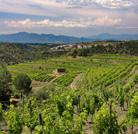
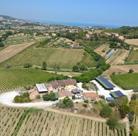
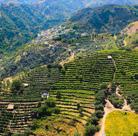
Woolyard
Bermondsey Street London SE1 3UD
020 7840 3600
info@mentzendorff.co.uk www.mentzendorff.co.uk



Step inside the Bastion de l’Oratoire, a medieval fortress where Chanson’s Premier and Grand Cru wines are aged to perfection. Join us at one of our exclusive tastings of the 2024 en primeur vintage – in London or Manchester – guided by Vincent Wallays, Export Director. For more information, please contact Claire@mentzendorff.co.uk
schenk family uk
Unit 5, The E Centre
Easthampstead Road
Bracknell RG12 1NF
01753 521336
info@buckingham-schenk.co.uk www.buckingham-schenk.co.uk @schenkfamilyuk

020 7720 5350 order@libertywines.co.uk www.libertywines.co.uk

@liberty_wines



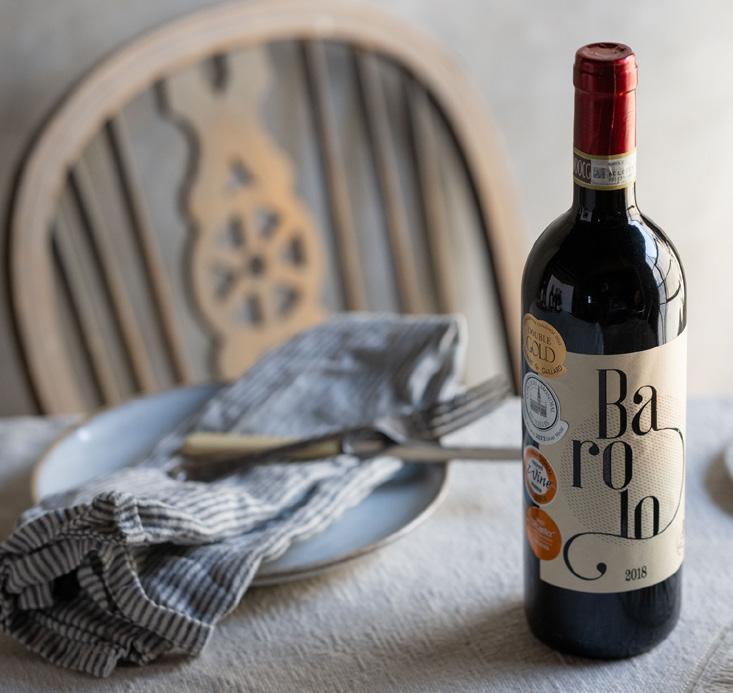
The Casali del Barone range showcases some of the most typical and authentic wines from the Piedmont area. These wines celebrate the true personality of the region, beautifully expressing the vineyards of Langhe, Piedmont, Barbaresco, and Barolo.
Under the guidance of oenologist Daniele Ress, the range is crafted to be well-balanced, fruit-driven, and true flag bearers of Piedmont’s winemaking tradition.






Fernando González Riveiro of Adega Algueira and Jonatan García Lima of Ocampo are two leading lights of Spain’s dynamic wine scene – both dedicated to preserving the rich vinous heritage of ancient vineyards, indigenous grape varieties, and traditional practices in their respective regions.

A jewel in Ribeira Sacra’s magnificent crown, family-run Adega Algueira is recognised for producing refined wines – from its excellent value young Mencía to their complex, ageworthy ‘Escalada’ Godello. Fernando and his son Fabio have 130 vineyard plots totalling 30 hectares with varied soil compositions, aspects and gradients, many perched on very steep southfacing slopes. Slate and schist soils have proven well suited to Mencía, accentuating the variety’s natural tension and minerality, while granite soils with quartz and gneiss provide remarkable freshness and elegance to Godello, Treixadura and Albariño.
Ocampo is an exciting new project in Tacoronte-Acentejo, the oldest DO in Tenerife, where reddish, volcanic soils produce distinctive, characterful wines. Ungrafted and organically farmed, the Ocampo vineyards are planted with Malvasía Volcánica, Marmajuelo, Albillo Criollo and Vijariego Negro, while Listán Blanco and Listán Negro come from like-minded growers in the higher part of the appellation. Jonatan is the winemaker behind two of the Canary Islands’ most respected estates and though Ocampo is still in its infancy, we are eager to watch how it develops under his guidance.

New Bank House
1 Brockenhurst Road
Ascot SL5 9DL 01344 871800
info@hatch.co.uk www.hatchmansfield.com

Hatch Mansfield

hatchmansfield

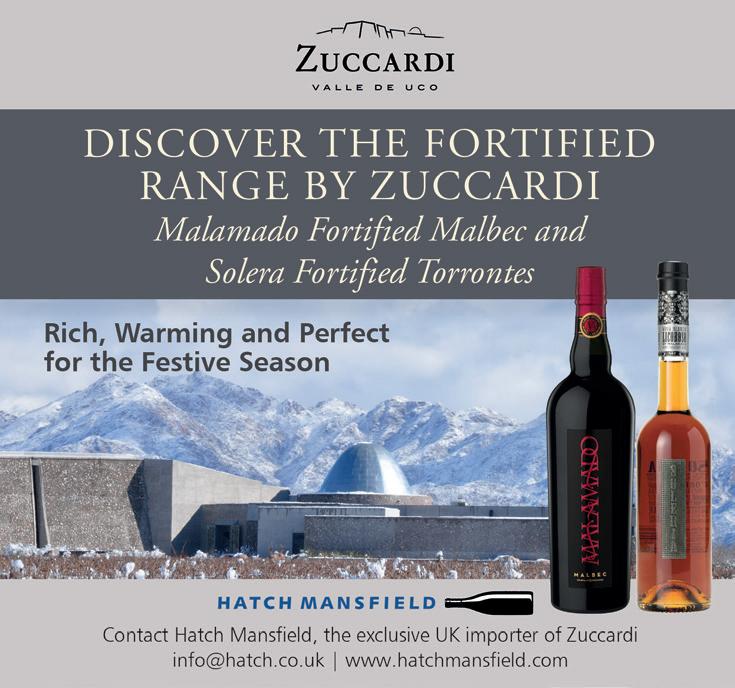
28 Recreation Ground Road
Stamford
Lincolnshire PE9 1EW 01780 755810
orders@abs.wine www.abs.wine

@ABSWines


We are thrilled to have recently started work with two new producers, Sophie Schaal Wines from France, and Weingut Robert Weil from Germany. Sophie crafts aromatic varietal wines in her native Alsace, all the wines are certified organic, and perfectly reflect the terroir of the region. Weingut Robert Weil, is a renowned family-owned Rheingau producer, producing expressive Rieslings, across the entire Riesling spectrum from bone-dry to luscious.
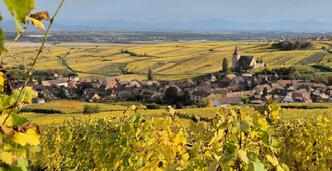

Born in Burgundy, Sophie Schaal’s journey into the world of wine began with studies in Dijon. After five years of dedication, she earned the national diploma of oenologist. Alsace has always held a special place in her heart. Nestled at the foothills of the Vosges Mountains, this region is a true paradise for winemaking, with its diverse soils and deep-rooted traditions. As a mother, Sophie places great emphasis on aligning all her actions with sustainable practices.
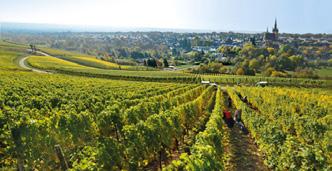

Vines have been cultivated at Weingut Robert Weil for four generations. The founder of the estate, Dr. Robert Weil, purchased the first vineyards on the Kiedricher Berg in 1867. Today, the estate is run by Wilhelm Weil, the great-grandson of the estate’s founder. The focus on Riesling as well as meticulous, quality-oriented work in the vineyard and cellar enable the estate to produce wines of the highest quality. Their motto is quality through the union of tradition and modernity.
For more information contact your Account Manager
Hanworth TW13 6JE 020 8744 5550
Mark Isham, south & London: mark@richmondwineagencies.com
Tim Hawtin, south west & London: tim@richmondwineagencies.com
Julia Langshaw, north of the UK: julia@richmondwineagencies.com
Monika Kent, north of UK monika@richmondwineagencies.com

Ground Floor
Bibendum Matthew Clark
16 St Martin’s Le Grand London EC1A 4EN
0207 449 1665
orders@walkerwodehousewines.com www.walkerwodehousewines.com


@WalkerWodehouse

Frank, the Cape wine company, was founded in 2010 by Erlank Erasmus, who previously had 10 years of experience in winemaking in the industry and decided to start a new venture of his own to produce exceptional wines from the Western Cape.
The family is based just south of Paarl, which is where Erlank sources the grapes for his wines, all from smaller local growers. Given the rich history of the country, Frank proudly gives back to local communities and the smaller growers that assist in production, from vine to bottle, through participating in the Fairtrade initiative. This ensures that the local farms benefit through sustainability and equality measures.
We have these super wines on offer until 1st January so please contact us for further info –along with details of our Winter Brochure with lots of offers for Christmas!
Frank Chenin Promo: RRP £11.95 AND Frank Pinotage RRP £12.95

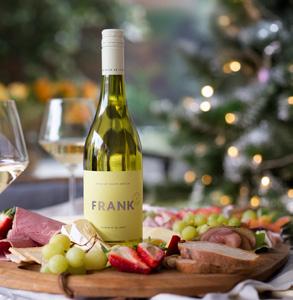
Located in the Adelaida District of Paso Robles, California, Daou is known for its Bordeaux-style wines and stunning hilltop estate. Founded by brothers George and Daniel Daou, the vineyard combines French winemaking heritage with Californian innovation to produce highly acclaimed wines.
The following Daou wines are now available in our range:
• Discovery Chardonnay
• Reserve Chardonnay
• Discovery Cabernet Sauvignon
• Reserve Cabernet Sauvignon
• Soul Of Lion
Please contact your account manager for more information or to place and order.


Fells House, Station Road
Kings Langley WD4 8LH
01442 870 900
For more details about these wines and other wines from our awardwinning portfolio from some of the world’s leading wine producing families contact:
info@fells.co.uk www.fells.co.uk

@FellsWine

je_fells

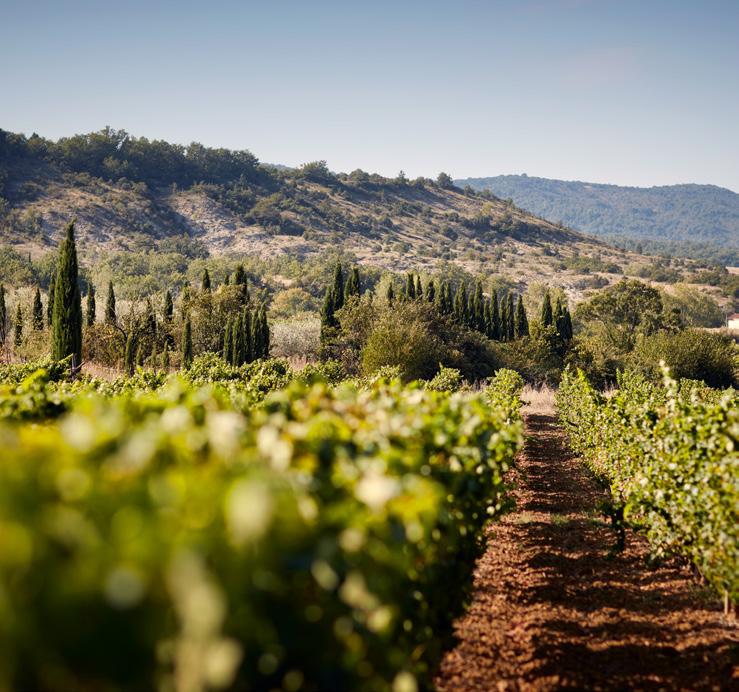
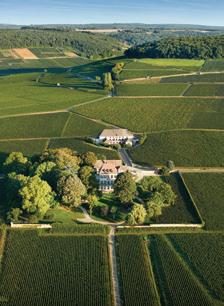
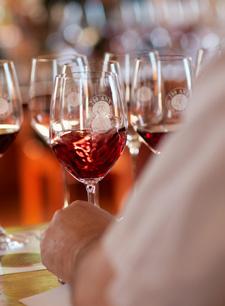
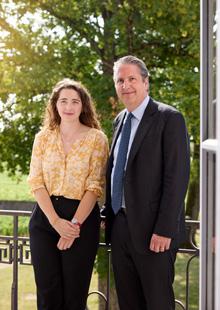
Fells is delighted to welcome world-famous Burgundy producer Maison Louis Latour into its prestigious portfolio. With over 200 years’ experience crafting breathtaking Burgundy from across the region’s matchless mosaic of distinct terroirs, this twelfthgeneration producer perfectly complements the Fells commitment to bringing the world’s best family wineries to the glasses of UK wine lovers.


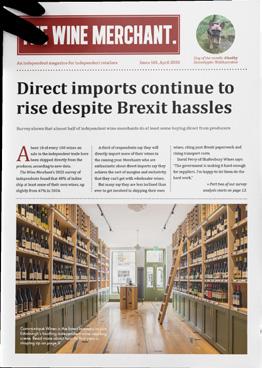
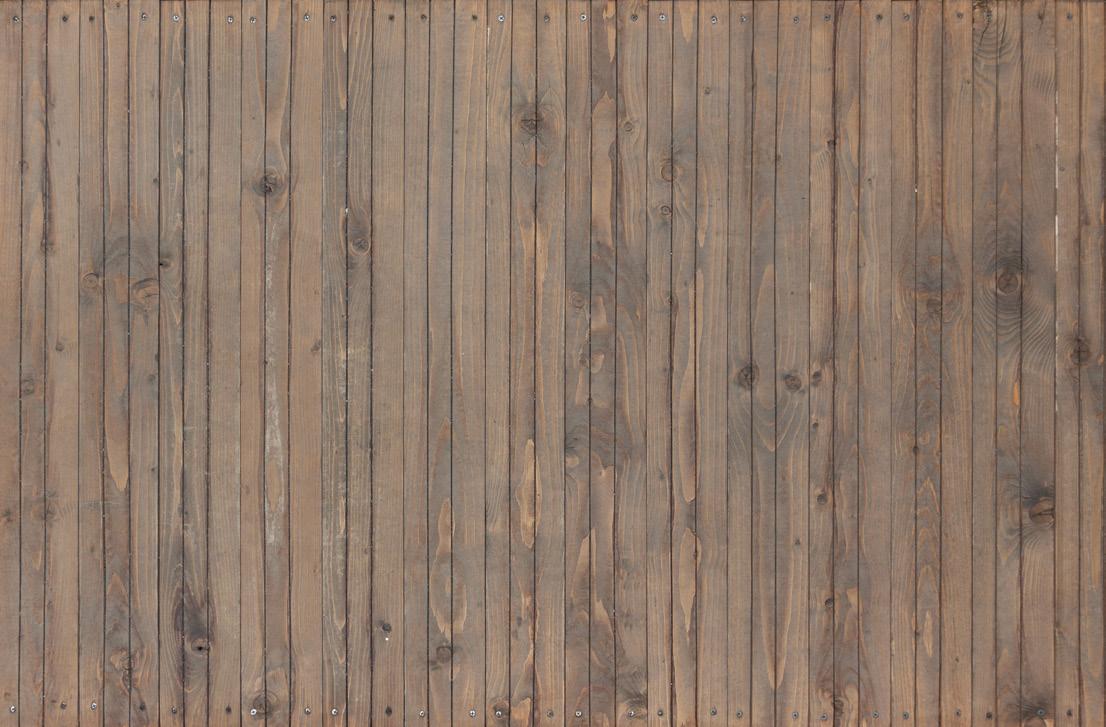


The Old Pigsty, Rose Cottage Church Hanborough OX29 8AA
07802 405627
orders@delibo.co.uk jamesfleetwood@delibo.co.uk robertewing@delibo.co.uk johnnybingham@delibo.co.uk gyorgyzsiga@delibo.co.uk www.delibo.co.uk
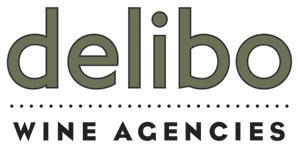
7-9 Elliott’s Place
London N1 8HX
020 7288 8888
sales@jeroboamstrade.co.uk www.jeroboamstrade.co.uk

@jeroboamstrade

A heroic zero-alcohol wine from the Pfalz
Not all heroes wear capes! Oliver Zeter, the Pfalz iconoclast, has drawn upon his extensive experience with Sauvignon Blanc to develop the fresh and invigorating Zero Hero with true varietal character. A vibrant, alcohol-free 100% Sauvignon Blanc with zesty passionfruit, yellow kiwi, and verbena aromas. Serious on the palate, benefiting from several months on the lees before the alcohol was gently reduced to less than 0.5% and then a little unfermented grape must added for extra zap.
Well worth adding to your range for the festive period and beyond!


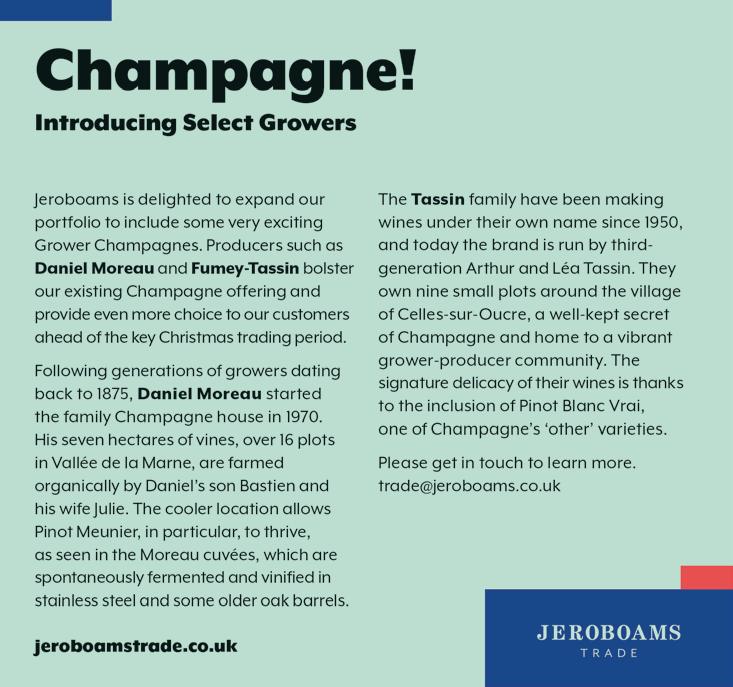
hallgarten wines
Mulberry House Parkland Square
750 Capability Green
Luton LU1 3LU
01582 722 538
sales@hnwines.co.uk www.hnwines.co.uk



@hnwines
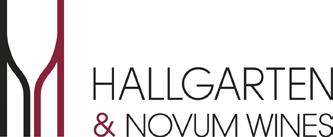

top selection
23 Cellini Street London SW8 2LF
www.topselection.co.uk info@topselection.co.uk
Contact: Alastair Moss
Telephone: 020 3958 0744


@topselectionwines
@topselection

Developed in collaboration with some of the world’s most respected winemakers to embody the spirit of discovery and excellence that defines Top Selection

“Gaston Huey
1969 changed my life”

Richard was born in Leicester to teetotal parents and initially worked as a chef before discovering wine and enrolling for the MW course. He fell in love with South African wine and lived in the Cape for seven years. On his return to the UK he worked at Richards Walford before taking over Dreyfus Ashby in 2014. His alter ego is Rick, creator of The Liberator wine, an indie favourite.
What’s the first wine you remember drinking?
Lutomer Laski Rizling, circa 1978, bought from Asda. I was trying to impress a girl by cooking her dinner that night. However the bottle of wine that changed my life was in 1981: Vouvray Demi-sec 1969 from Gaston Huet.
What job would you be doing if you weren’t in the wine trade?
I’d probably still be cheffing.
How do you relax?
Put me in a bird hide.
What’s the best book you’ve recently read?
The Times World Atlas. I don’t get out much.
Give us a TV recommendation. Gone Fishing (not that I ever have) with Mortimer & Whitehouse. And away …
Do you have any sporting loyalties?
I’m a firm believer that you should follow your local team: the rise and fall of Leicester City.
Who’s your favourite music artist?
I’m a child of the seventies, so my teenage years were influenced by glam rock and latterly prog rock. Sadly, one of my songwriting heroes died recently: Rick Davies of Supertramp. Rudy, Downstream, You Started Laughing and From Now On are just some of his best.
But my go-to band is Steely Dan. If I’d ever had kids, ever had a daughter, she would have been called Aja.
Any superstitions?
My late mother had them all covered and I seem to have inherited them.
Who’s your favourite wine critic?
In these days of social media, everyone’s a critic. Regardless. I have followed HRH Jancis from my first introduction to wine in the early 1980s.
What’s your most treasured possession?
Memories recalled through photographs.
What’s your proudest moment?
Passing the Master of Wine exam in 1995 and my 30-plus year relationship with the Cape.
What’s your biggest regret?
My thirty-one month tenure with ABS.
Who’s your hero?
I have three. Gaston Huet, although I never did get to meet him. My cathartic moment with that bottle of 1969 is the reason why I do what I do now.
Robert Mondavi (who I did meet once). He started his eponymously-named winery at the age of 52. I was the same age when we reinvented Dreyfus Ashby, bringing it into the 21st century.
Allan Mullins CWM: as much of a life hero as wine hero. Allan was the wine buyer at Woolworths in South Africa (with close links to M&S in the UK). A remarkable man, something that would be recognised by anyone who ever knew him.
Any hidden talents?
If there are, they’re hidden from me.
What’s your favourite place in the UK?
The Trough of Bowland. (Get the map out.)
If we could grant you one wish, what would it be?
All I want for my birthday is another birthday …
